OvisLink N450R 3T3R WIRELESS-N DUAL BAND GIGABIT ROUTER User Manual 05 N450R
OvisLink Corp. 3T3R WIRELESS-N DUAL BAND GIGABIT ROUTER 05 N450R
OvisLink >
Users Manual

1
N450R
3T3R Wireless-N Dual Band Gigabit
Router
Use
r
’s Manual
802.11a (UNII) RF exposure statement
According to FCC 15.407(e), the device is intended to operate in the frequency
band of 5.15GHz to 5.25GHz under all conditions of normal operation. Normal
operation of this device is restricted to indoor used only to reduce any potential for
harmful interference to co-channel MSS operations.
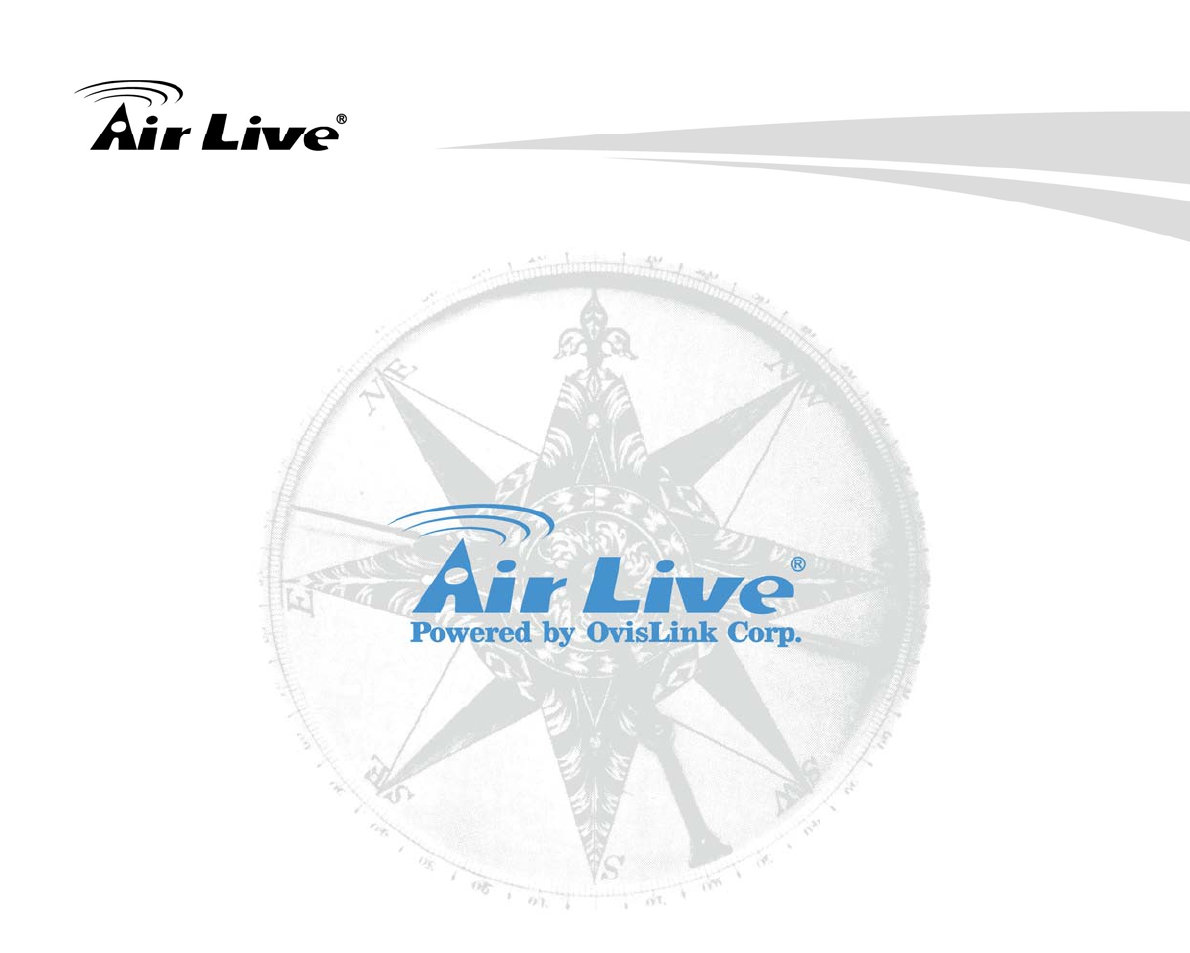
Copyright and Disclaimer
AirLive N450R User’s Manual
i
Copyright & Disclaimer
No part of this publication may be reproduced in any form or by any means, whether
electronic, mechanical, photocopying, or recording without the written consent of OvisLink
Corp.
OvisLink Corp. has made the best effort to ensure the accuracy of the information in this
user’s guide. However, we are not liable for the inaccuracies or errors in this guide. Please
use with caution. All information is subject to change without notice
All Trademarks are properties of their respective holders.

Copyright and Disclaimer
AirLive N450R User’s Manual
ii
FCC Statement
Federal Communication Commission Interference Statement This equipment has been
tested and found to comply with the limits for a Class B digital device, pursuant to Part 15 of
the FCC Rules.
These limits are designed to provide reasonable protection against harmful interference in
a residential installation. This equipment generates uses and can radiate radio frequency
energy and, if not installed and used in accordance with the instructions, may cause
harmful interference to radio communications. However, there is no guarantee that
interference will not occur in a particular installation. If this equipment does cause harmful
interference to radio or television reception, which can be determined by turning the
equipment off and on, the user is encouraged to try to correct the interference by one of the
following measures:
Reorient or relocate the receiving antenna.
Increase the separation between the equipment and receiver.
Connect the equipment into an outlet on a circuit different from that to which the
receiver is connected.
Consult the dealer or an experienced radio/TV technician for help.
FCC Caution
Any changes or modifications not expressly approved by the party responsible for
compliance could void the user's authority to operate this equipment.
This device complies with Part 15 of the FCC Rules. Operation is subject to the following
two conditions:
1. This device may not cause harmful interference, and
2. This device must accept any interference received, including interference that may
cause undesired operation. For product available in the USA/Canada market, only
channel 1~11 can be operated. Selection of other channels is not possible.
This device and its antenna(s) must not be co-located or operation in conjunction with any
other antenna or transmitter.
IMPORTANT NOTE
FCC Radiation Exposure Statement:
This equipment complies with FCC radiation exposure limits set forth for an uncontrolled
environment. This equipment should be installed and operated with minimum distance
20cm between the radiator & your body.

Table of Contents
AirLive N450R User’s Manual
iii
Table of Contents
1. Introduction................................................................................................5
1.1 Package List ........................................................................................7
1.2 Features...............................................................................................7
1.3 Specification Table ...............................................................................8
1.4 Hardware Installation ...........................................................................9
1.4.1 Front View....................................................................................................9
1.4.2 Rear View ..................................................................................................10
1.4.3 LED Indicators ...........................................................................................10
1.4.4 Button Definition ........................................................................................ 11
1.4.5 How to Operate..........................................................................................12
1.5 Wireless Operation Modes.................................................................13
1.5.1 AP Router ..................................................................................................13
1.5.2 AP Only......................................................................................................13
1.5.3 WDS Repeater ..........................................................................................13
1.5.4 WDS Only..................................................................................................14
1.5.5 Adapter Mode ............................................................................................14
2. Getting Start .............................................................................................15
2.1 Easy Setup by Windows Utility ..........................................................15
2.2 Easy Setup by Configuring Web UI ...................................................23
2.2.1 Browse to Activate the Setup Wizard.........................................................23
2.3 Configure with Setup Wizard .............................................................24
3. Configuration ...........................................................................................28
3.1 Login Web UI .....................................................................................28
3.2 Basic Setting......................................................................................28
3.2.1 Network Setup ...........................................................................................29
3.2.2 DHCP Server .............................................................................................42
3.2.3 Wireless 2.4G Settings ..............................................................................44
3.2.4 Wireless 5G Settings .................................................................................52
3.2.5 Change Password .....................................................................................59
3.3 Forwarding Rules...............................................................................59
3.3.1 Virtual Server .............................................................................................60
3.3.2 Special AP .................................................................................................61
3.3.3 IP CAM ......................................................................................................62
3.3.4 Miscellaneous............................................................................................62

Table of Contents
AirLive N450R User’s Manual
iv
3.4 Security Setting..................................................................................63
3.4.1 Status.........................................................................................................63
3.4.2 Packet Filters.............................................................................................64
3.4.3 Domain Fitters ...........................................................................................65
3.4.4 URL Blocking .............................................................................................66
3.4.5 MAC Control ..............................................................................................67
3.4.6 Miscellaneous............................................................................................68
3.5 Advanced Setting...............................................................................69
3.5.1 Status.........................................................................................................70
3.5.2 System Log................................................................................................70
3.5.2 Dynamic DNS ............................................................................................71
3.5.3 QoS ...........................................................................................................72
3.5.4 SNMP ........................................................................................................77
3.5.5 Routing ......................................................................................................78
3.5.6 System Time..............................................................................................79
3.5.7 Scheduling.................................................................................................80
3.5.8 IPv6 ...........................................................................................................81
3.5.9 VLAN .........................................................................................................86
3.5.10 Advanced Wireless Settings ....................................................................87
3.6 NAS ...................................................................................................89
3.6.1 Disk Utility..................................................................................................89
3.6.2 Samba Server............................................................................................90
3.6.3 FTP Service Configuration.........................................................................90
3.6.4 Access Control...........................................................................................91
3.6.5 iTunes Server ............................................................................................91
3.6.6 Download Assistant ...................................................................................92
3.6.7 Download Status........................................................................................96
3.6.8 Web HDD...................................................................................................97
3.7 Tool Box .............................................................................................97
3.7.1 System Info................................................................................................98
3.7.2 USSD.........................................................................................................99
3.7.3 Firmware Upgrade .....................................................................................99
3.7.4 Backup Setting ........................................................................................100
3.7.5 Reset to Default.......................................................................................100
3.7.6 Reboot .....................................................................................................101
3.7.7 Miscellaneous – Wake on LAN & Ping ....................................................101
Appendix A: Troubleshooting...................................................................102
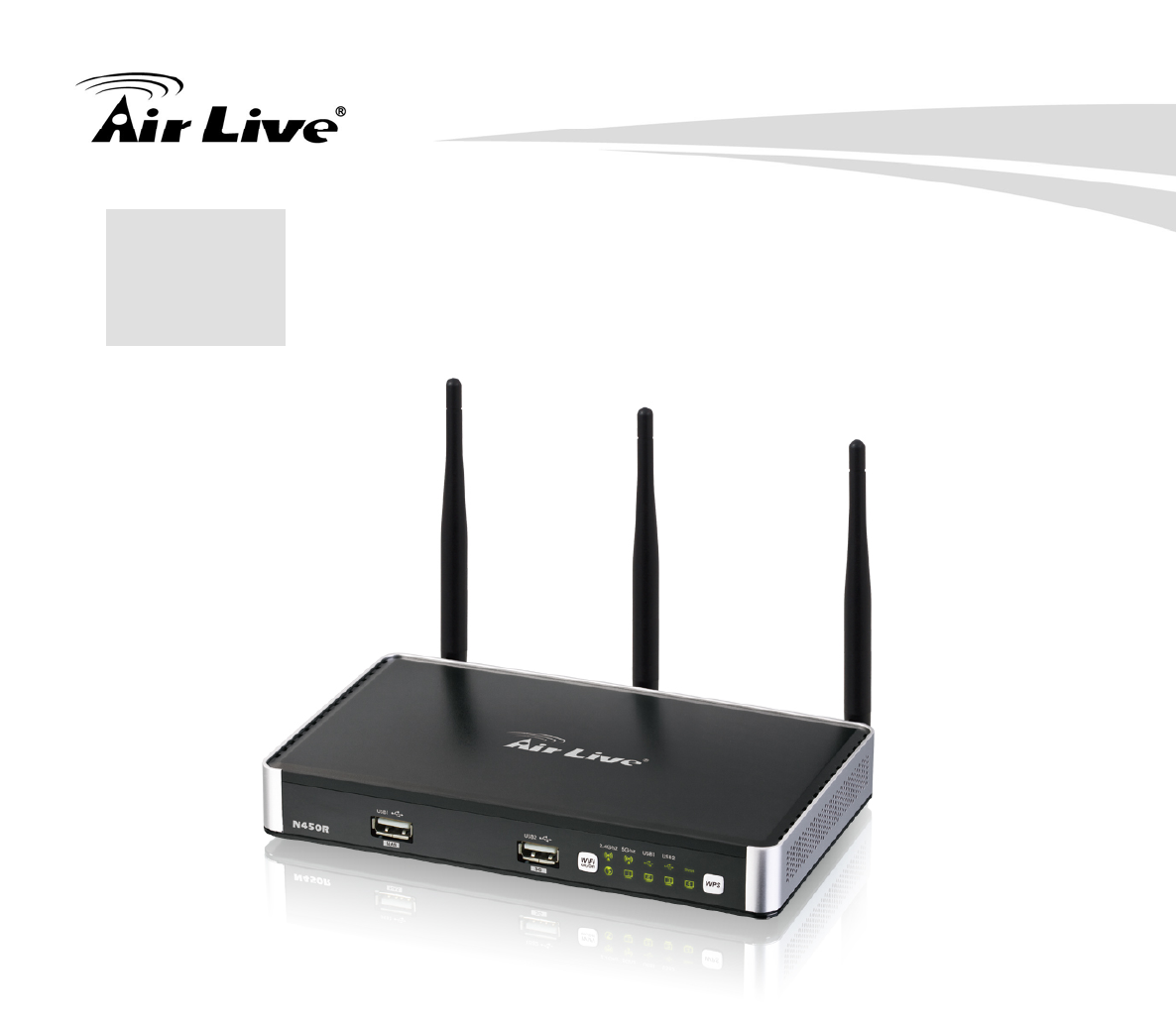
1. Introduction
AirLive N450R User’s Manual
5
1 1. Introduction
Congratulations on your purchase of this outstanding product! The AirLive N450R is a
802.11n concurrent dual band mobile broadband router with USB slots for 3G modem card
and USB storage. It can support 3G/4G mobile broadband, and also provides a physical
WAN port for fixed-line broadband and supporting varieties of WAN connection types,
such as PPPoE, Static IP, Dynamic IP (DHCP Client), PPTP, and L2TP.
There is a built-in 4-port Full-Duplex 10/100/1000 Gigabit switch to connect your wired
Ethernet devices together.
AirLive N450R is the high performance gateway of your home or office network, and it is
particularly designed for video streaming applications, users can extend the wireless by
802.11n compliant 5GHz/2.4GHz and up to 450Mbps.

1. Introduction
AirLive N450R User’s Manual
6
Moreover, the USB port is designed to share files under the Local Network, provides NAS
and 3G connection. For NAS function, it can support FAT16/FAT32, EXT2, NTFS file
system, and users can plug the USB Hard drive or pen drive, and share files instantly.
Once you want to enable FTP/HTTP/BT download service, you can follow easy setup
steps to let it download files without turning on a PC. With this powerful residential/SOHO
gateway, you can connect everyone in your home or small office to the network sharing
function for music, gaming, video, and achieving higher speed as Wi-Fi N, which is faster
and much better coverage than 11b/g.
N450R specifically designed for those who need to have the file sharing and P2P
download services beyond his home and office. It provides a complete solution for Internet
surfing and broadband sharing. Instructions for installing and configuring this product can
be found in this manual. Before you install and use this product, please read this manual
carefully for fully exploiting the functions of this product.
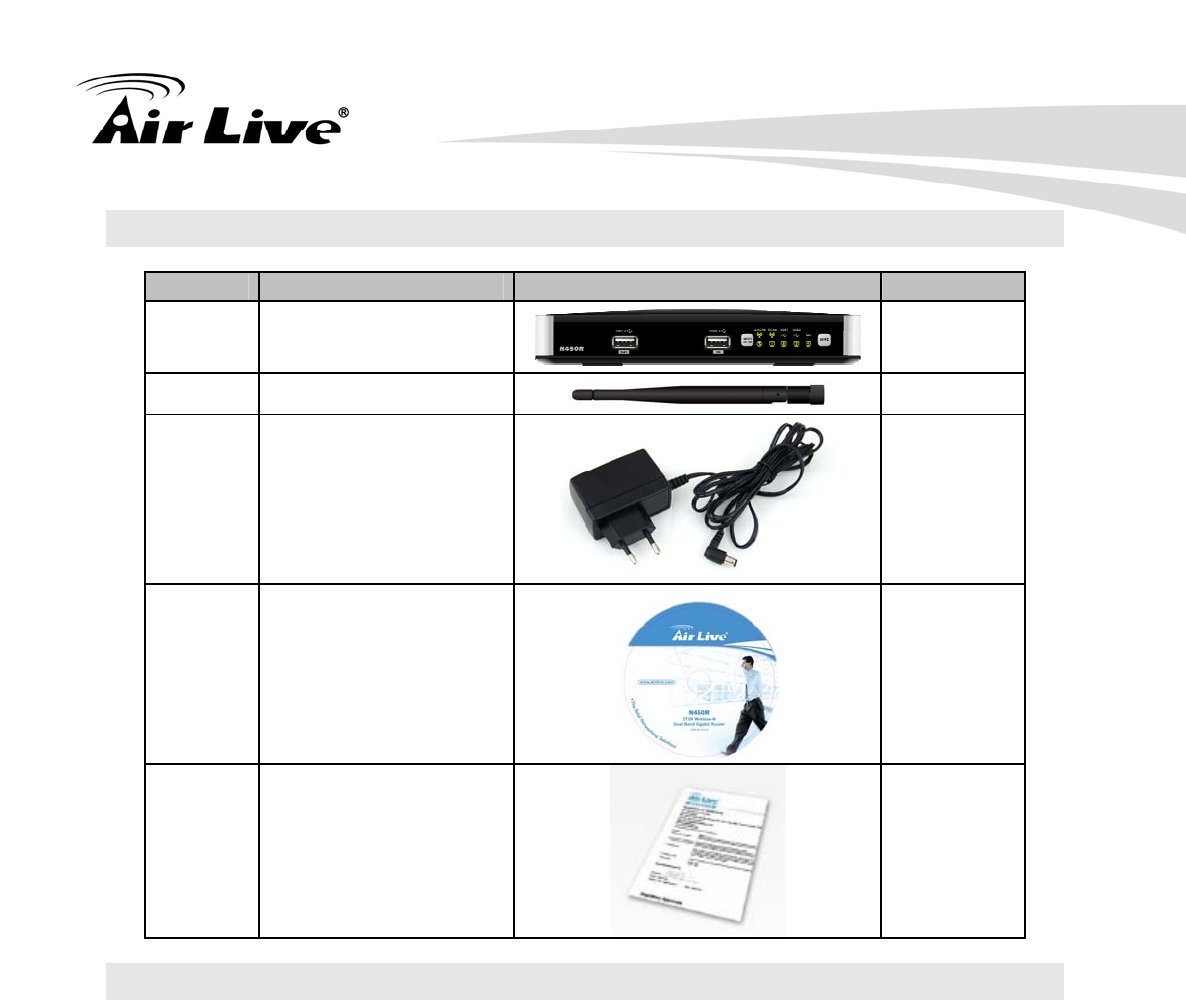
1. Introduction
AirLive N450R User’s Manual
7
1.1 Package List
Items Description Contents Quantity
1 N450R main unit
1
2 Antenna 3
3 Power adapter
(12V ,1.5A)
1
4 CD 1
5 Quick Start Guide
1
1.2 Features
Supports Wireless a/b/g/n Dual Band Standard
450Mbps at 5GHz and 300Mbps at 2.4GHz
5GHz and 2.4GHz at the same time
3T3R Beam Forming radio, smart antenna technology
Multi-Wall and Multi-Level environment
4 x Gigabit LAN and 1 x Gigabit WAN Ports
Support WAN and 3G Failover or Load Sharing
2 x USB 2.0 port for external storage and 3G dongle
Wireless Encryption: WEP, WPA/WPA2, WPA-PSK/WPA2-PSK
Support WPS Button
Supports QoS bandwidth, Web HDD, Internet scheduling
Supports Smartphone tethering to share 3G bandwidth
Supports UPnP Media server, iTunes Server
AirLive IPCAM Plug-and-Play
IPv6, SNMP, Static Route, RIP
UPnP, Virtual Sever, ALG, DMZ and SPI Firewall etc
Supports IPSec, L2TP and PPTP VPN Pass-Through
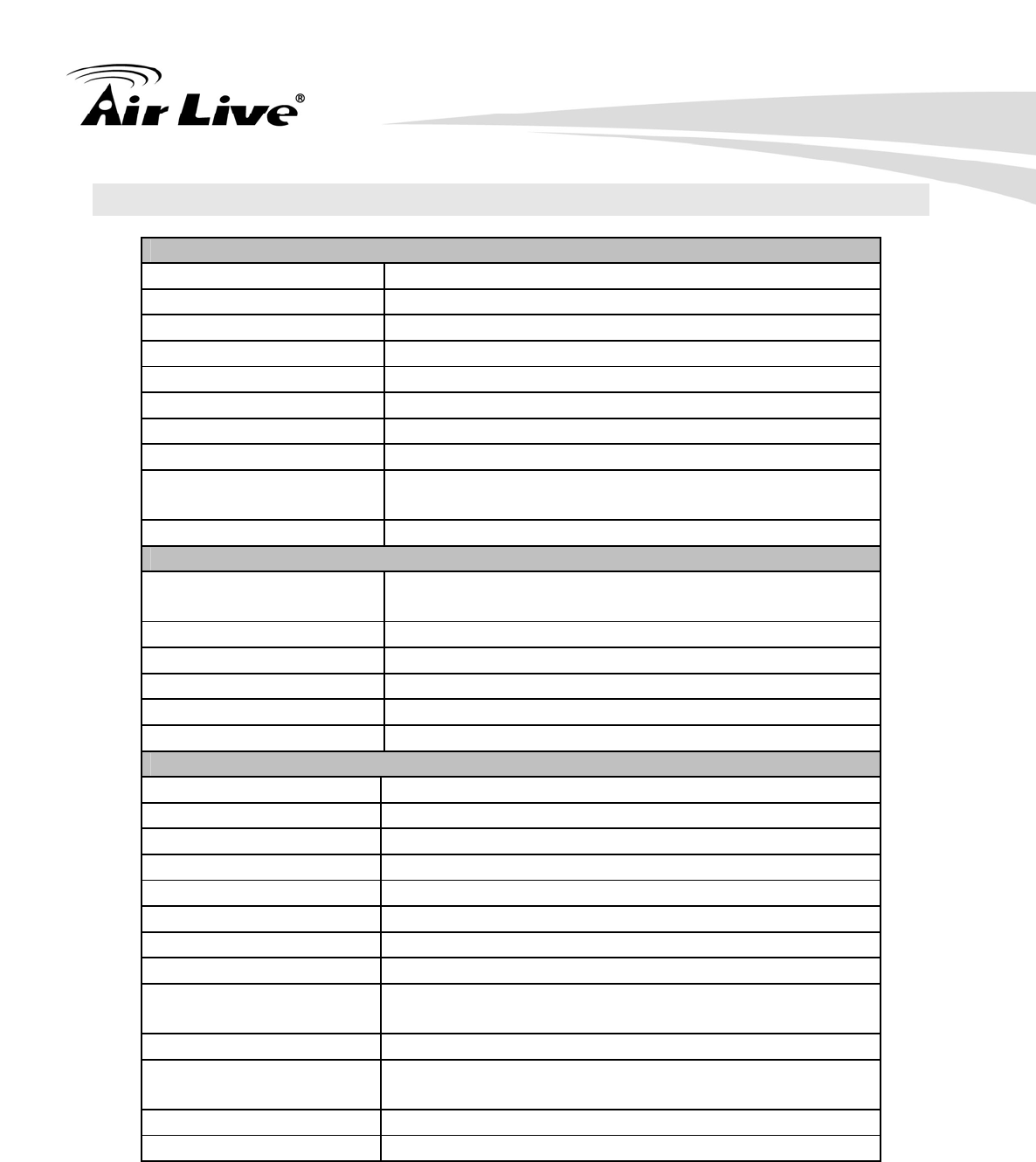
1. Introduction
AirLive N450R User’s Manual
8
1.3 Specification Table
Device Interface
Ethernet WAN RJ-45 port,10/100/1000Mbps, auto-MDI/MDIX
Ethernet LAN RJ-45 port, 10/100/1000Mbps, auto-MDI/MDIX x 4
USB WAN USB 2.0 for 3G/3.5G/4G USB dongle
USB Sharing USB 2.0 for file sharing
Antenna External antenna x 3
WPS Button For WPS connection
Wireless On/Off Button Enable /Disable Wireless Radio
Reset Button Reset router setting to factory default
LED Indication Status / 2.4GHz/5GHz/ USB1/USB2/ WAN / LAN1 ~
LAN4
Power DC 12V/1.5A switching power adapter
Wireless LAN (WiFi)
Standard IEEE 802.11n 2.4GHz(2x2) /5GHz (3x3)
compliance
SSID SSID broadcast or in stealth mode
Channel Auto-selection, manually
Security WEP, WPA, WPA-PSK, WPA2, WPA2-PSK
WPS WPS (Wi-Fi Protected Setup)
WMM WMM (Wi-Fi Multimedia)
Functionality
Ethernet WAN PPPoE, DHCP client, Static IP, PPTP, L2TP
WAN Connection Auto-reconnect, dial-on-demand, manually
IPv6 support Dual stack IPv6 support
One-to-Many NAT Virtual server, special application, DMZ
NAT Session Support NAT session up to 20,000 sessions
SPI Firewall IP/Service filter, URL blocking, MAC control
DoS Protection DoS (Deny of Service) detection and protection
Routing Protocol Static route, dynamic route (RIP v1/v2)
Storage/File Sharing FAT16/FAT32, EXT2, NTFS ( Read only)
Samba server, FTP server
Media server UPnP AV media server, iTunes server
Scheduling Download
management
FTP, HTTP , BitTorrent
Management SNMP, UPnP IGD, syslog, DDNS
Administration Web-based UI, remote login, backup/restore setting
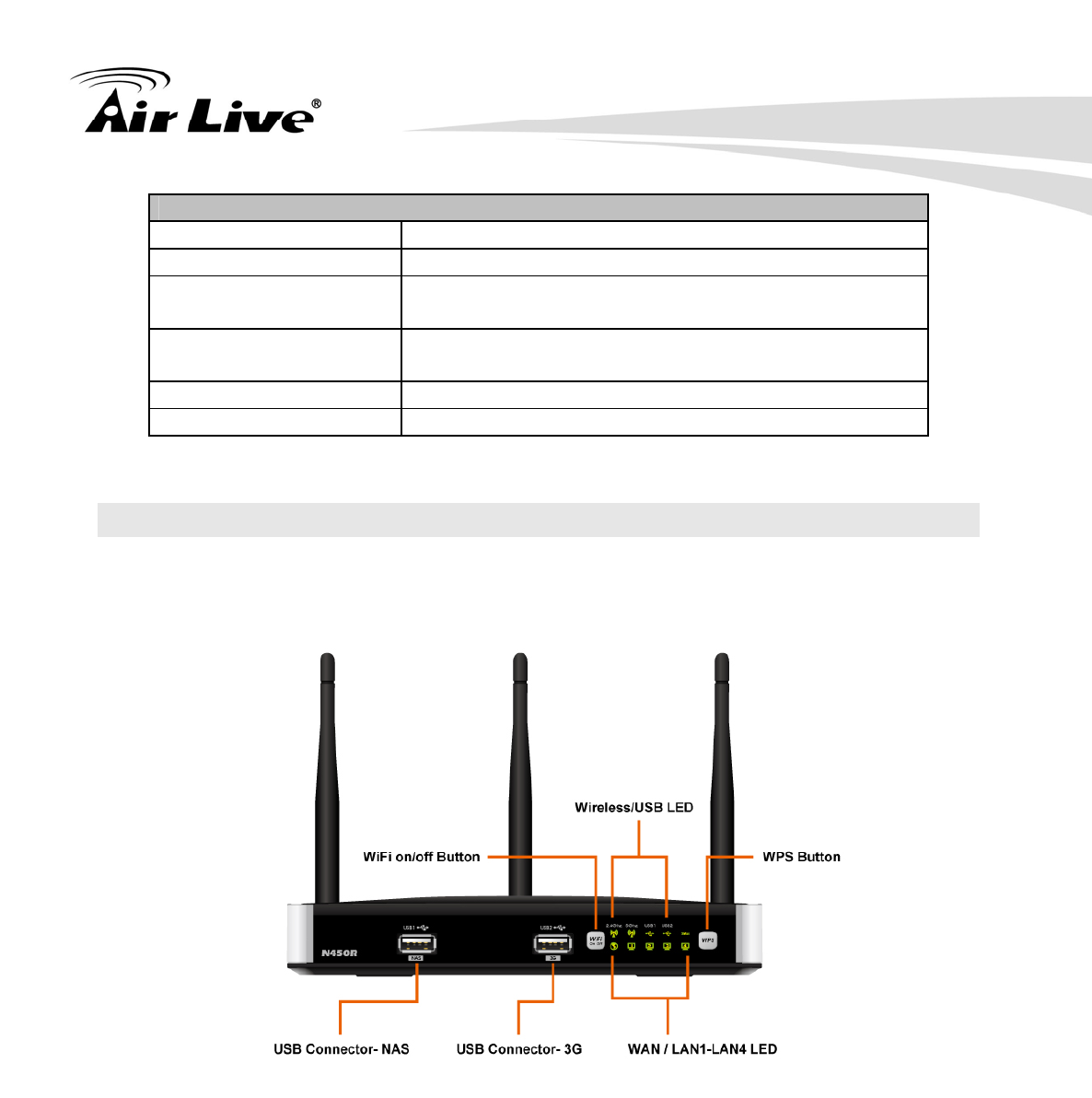
1. Introduction
AirLive N450R User’s Manual
9
Environment & Certification
Package Information Package dimension (mm)
Package weight (g)
Operation Temp. Temp.: 0~40oC, Humidity 10%~90%
non-condensing
Temp.: -10~70oC, Humidity: 0~95%
non-condensing
EMI Certification CE/FCC compliance
RoHS RoHS compliance
1.4 Hardware Installation
1.4.1 Front View
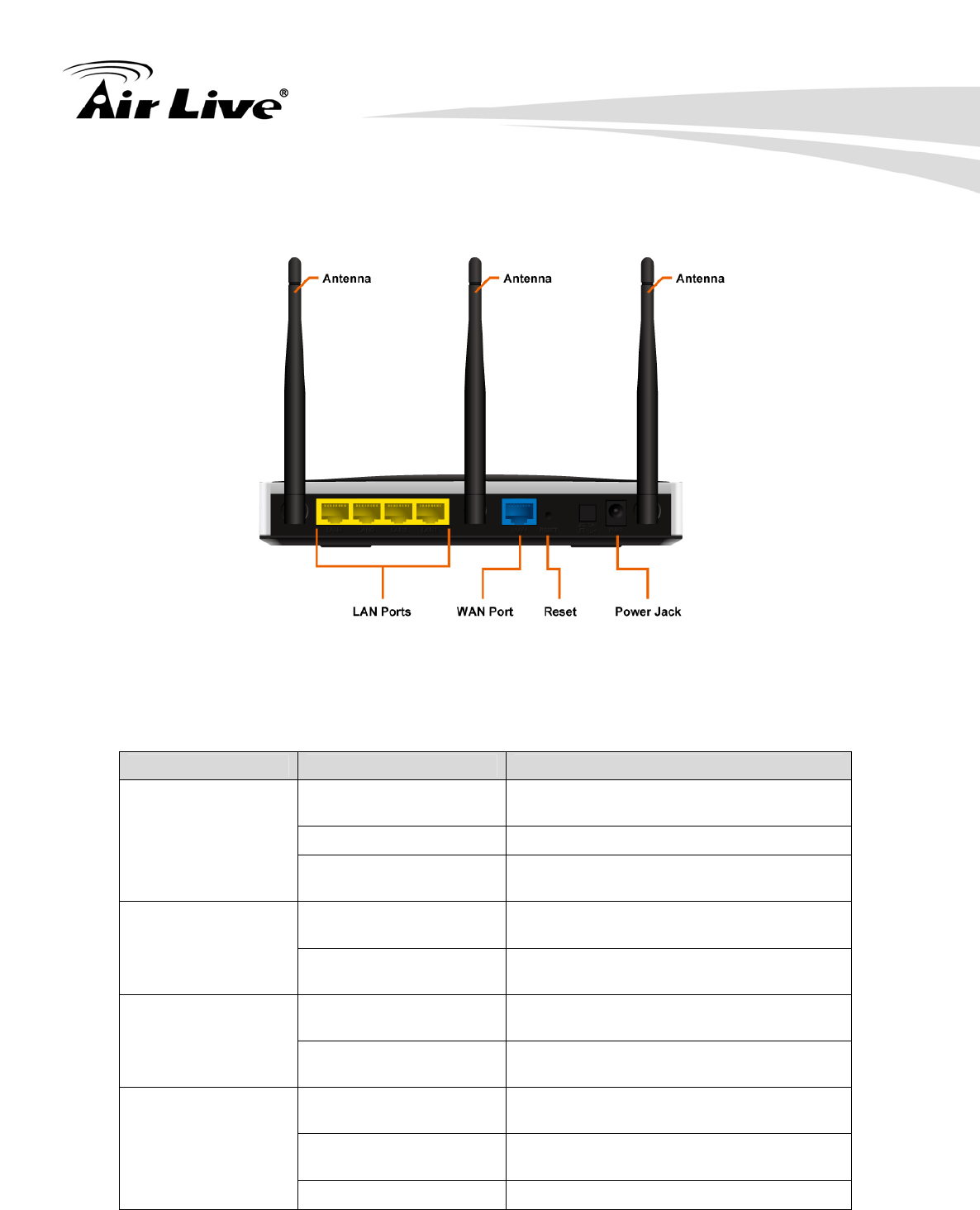
1. Introduction
AirLive N450R User’s Manual
10
1.4.2 Rear View
1.4.3 LED Indicators
LED Indicator Description
Green and flash once
per second This device is working
Green and Steady On An error occurred
Status
OFF Device is powered off or an error
occurred
Green and Steady On Ethernet WAN connection is
established
Ethernet WAN
Green and Blinking Data packet transferred via Ethernet
WAN
Green and Steady On Ethernet LAN connection is
established
Ethernet LAN 1~4
Green and Blinking Data packet transferred via Ethernet
LAN
Green and Blinking Data packet transferred via 2.4G
WiFi
Green and Fast
Blinking In WPS PBC mode
2.4GHz
OFF 2.4GHz wireless radio is disabled
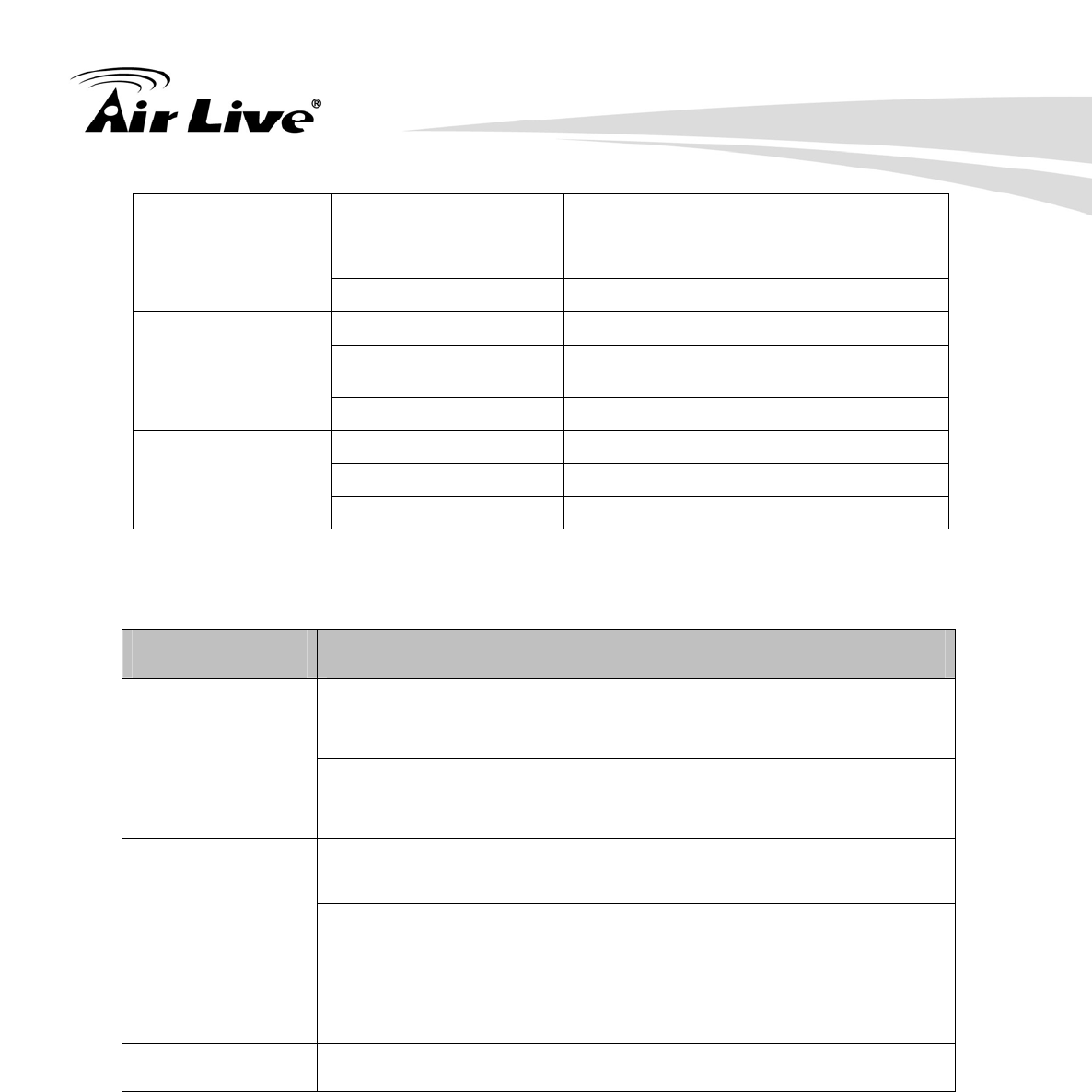
1. Introduction
AirLive N450R User’s Manual
11
Green and Blinking Data packet transferred via 5G WiFi
Green and Fast
Blinking In WPS PBC mode
5GHz
OFF 5GHz wireless radio is disabled
Green and Steady On An external USB storage is attached
Green and Blinking Data packet transferred via attached
USB storage device (e.g. USB drive)
NAS
OFF No USB storage is attached
Green and Steady On 3G connection is established
Green and Blinking Data packet transferred via 3G WAN
3G
OFF 3G connection is not established
1.4.4 Button Definition
Button Description
Continually press 3 seconds to enter WPS PBC mode for 2.4G
wireless
WPS
Continually press 8 seconds to enter WPS PBC mode for 5G
wireless
Continually press 3 seconds to switch on/off for 2.4G wireless
radio
WiFi on/off Continually press 8 seconds to switch on/off for 5G wireless
radio
Reset Continually press 6 seconds to reset device settings to factory
default
Power Push down the button to turn on the power
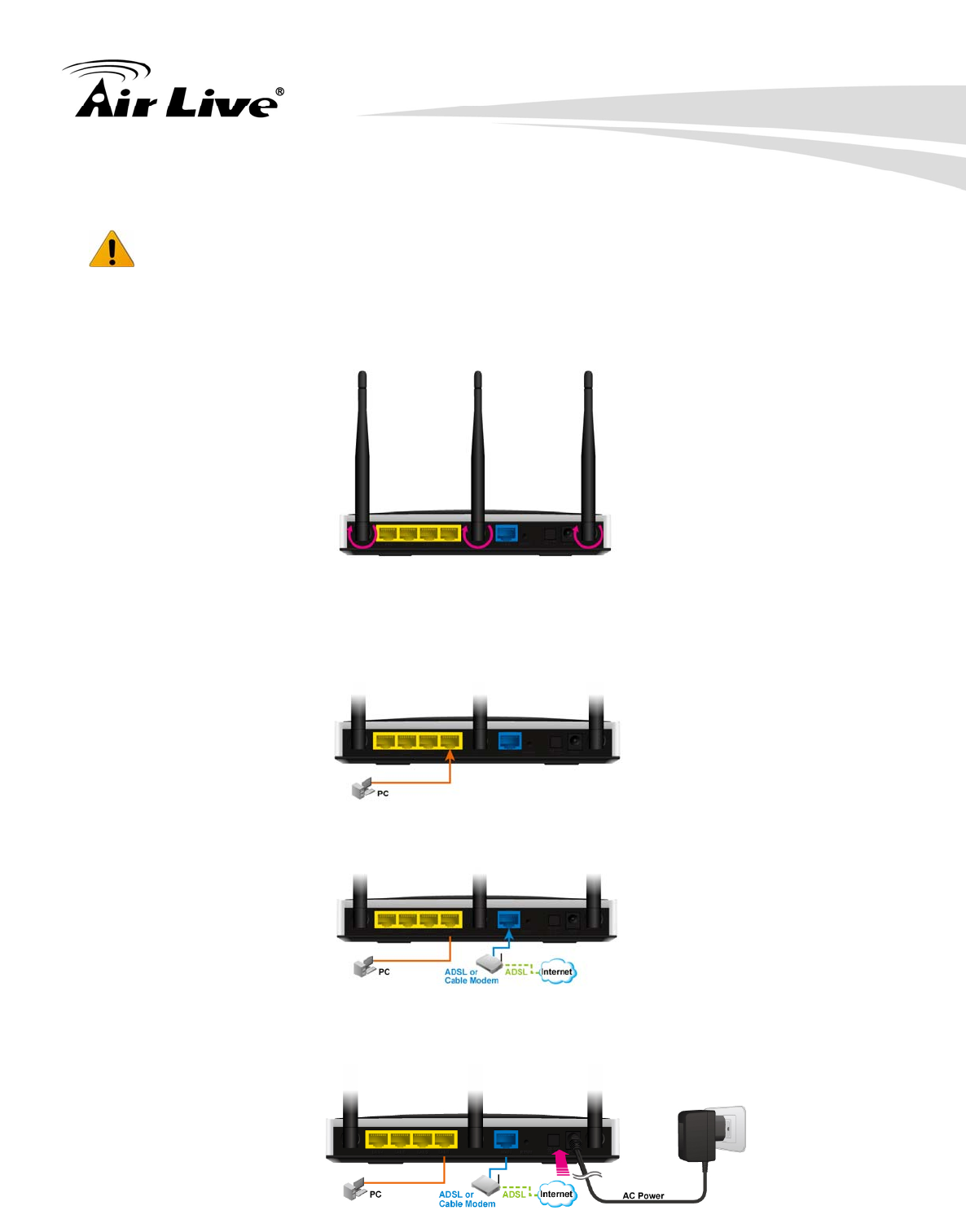
1. Introduction
AirLive N450R User’s Manual
12
1.4.5 How to Operate
DO NOT connect the router to power before performing the installation steps
below.
Step 1: Screw the antenna in a clockwise direction to the back panel of the unit.
Step 2: Plug the RJ45 cable into LAN port 1~4 and connect with your PC or NB.
Step 3: Plug your RJ-45 into the WAN port and connect with your xDSL modem.
Step 4: Plug the power jack into it.
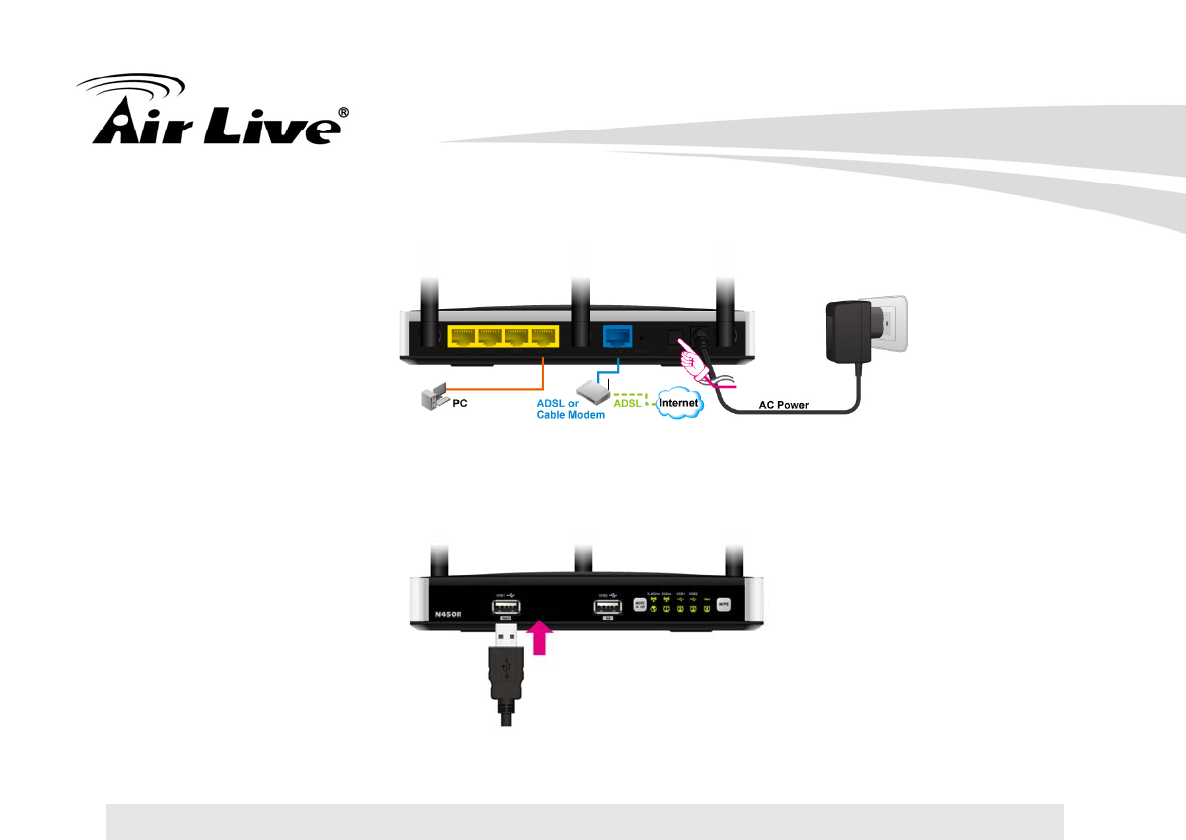
1. Introduction
AirLive N450R User’s Manual
13
Step 5: Power ON.
Step 6: Prepare a USB Storage and then plug into the USB port.
1.5 Wireless Operation Modes
1.5.1 AP Router
In this mode, you can share your 3G Internet connection and/or broadband connection. If
you do not have a 3G USB dongle, you can still share your ADSL modem, xDSL mdoem,
or Cable Modem connections. If you have both 3G and Broadband, you can use both for
connection backup.
1.5.2 AP Only
When operating in the Access Point mode, the N450R becomes the center hub of the
wireless network. All wireless cards and clients connect and communicate through N450R.
This type of network is known as “Infrastructure Network”. Other N450R can connect to
AP mode through “Adapter Mode”.
1.5.3 WDS Repeater
In WDS Repeater mode, the N450R functions as a repeater that extends the range of
remote wireless LAN. In this mode, the remote Access Point must have WDS (Wireless
Distribution System) capability. If you require the PC’s MAC addresses to be preserved
when the data pass through the Repeater, it is necessary to use the WDS Repeater mode.
Because the radio is divided into WDS + AP mode, the Repeater mode will have less
performance and distance.

1. Introduction
AirLive N450R User’s Manual
14
1.5.4 WDS Only
This mode is also known as “WDS Pure MAC Bridge mode”. When configured to
operate in the Wireless Distribution System (WDS) Mode, the N450R provides bridging
functions with remote LAN networks in the WDS system. Each bridge can only associate
with maximum of 4 other bridges in the WDS configuration. This mode is best used when
you want to connect LAN networks together wirelessly. This mode usually delivers faster
performance than infrastructure mode.
1.5.5 Adapter Mode
This mode is also known as “Client” mode. N450r acts as if it is a wireless adapter to
connect with a remote Access Point. Users can attach a computer or a router to the LAN
port of N450R to get network access. This mode is often used by WISP on the
subscriber’s side.
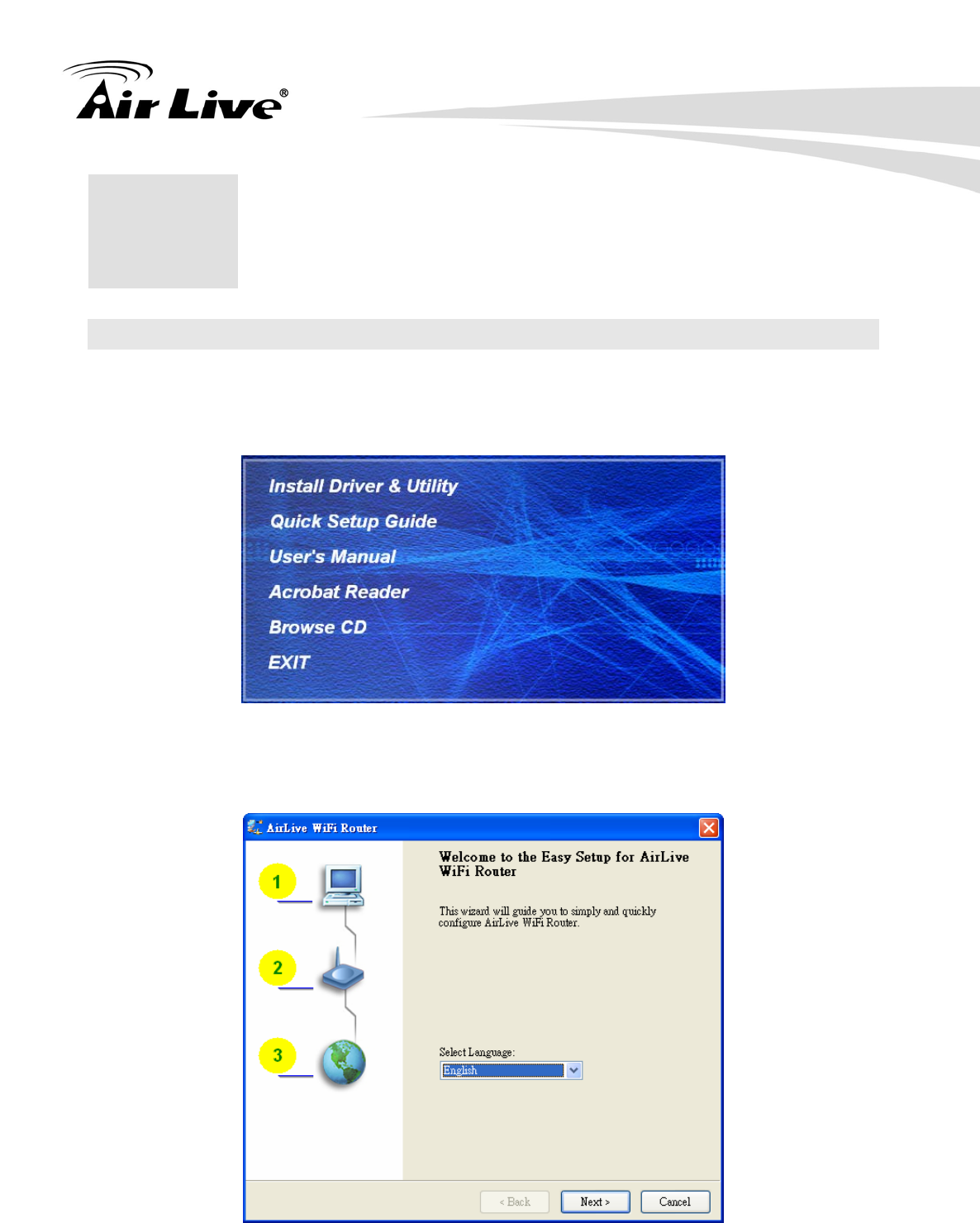
2. Getting Start
AirLive N450R User’s Manual
15
2 2. Getting Start
2.1 Easy Setup by Windows Utility
Step 1
Install the Easy Setup Utility from the provided CD. Click the “Install Driver & Utility” and
then follow the steps to configure the device.
Step 2
Select Language then click “Next” to continue.
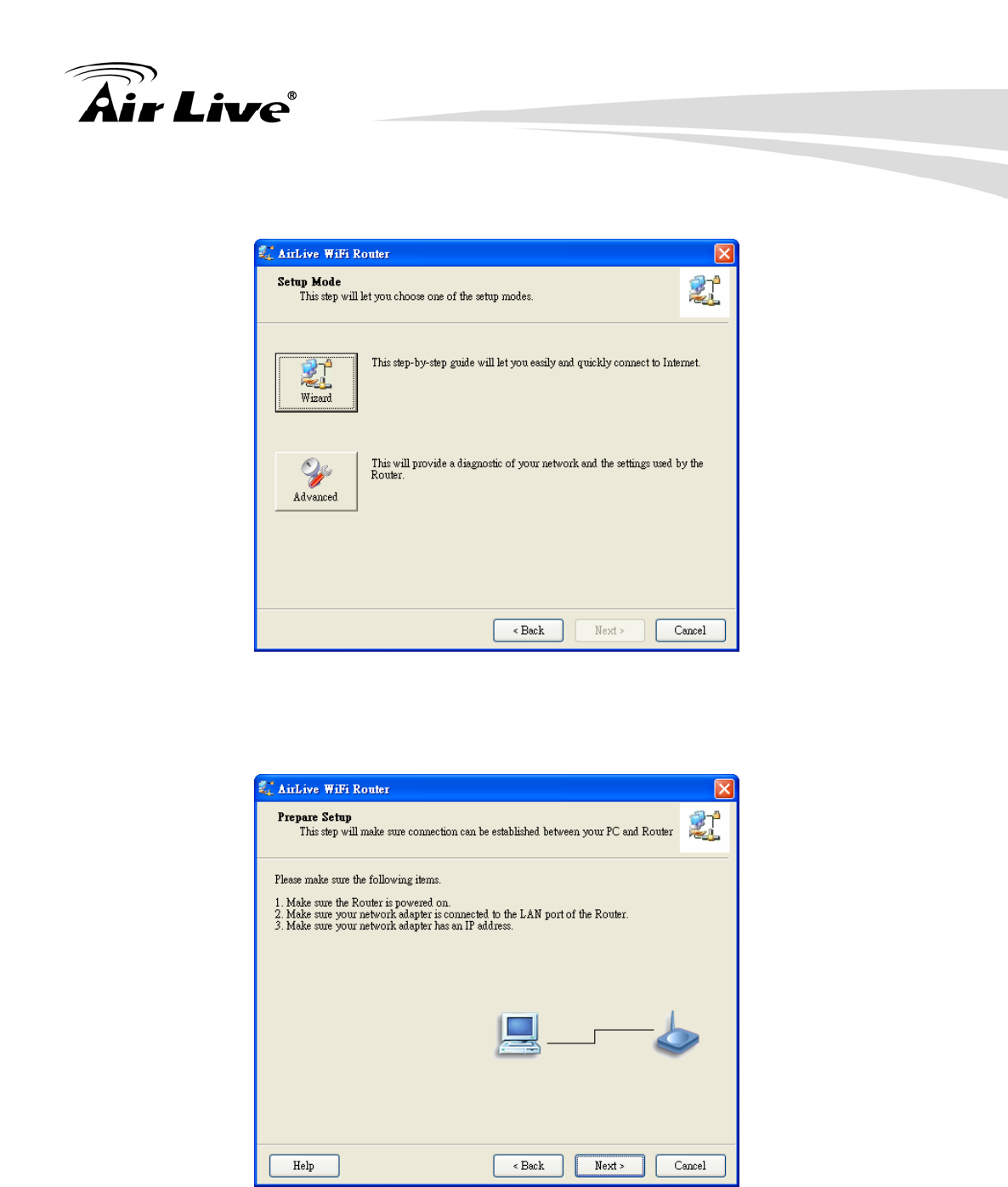
2. Getting Start
AirLive N450R User’s Manual
16
Step 3
Then, click the “Wizard” to continue.
Step 4
Click “Next” to continue.
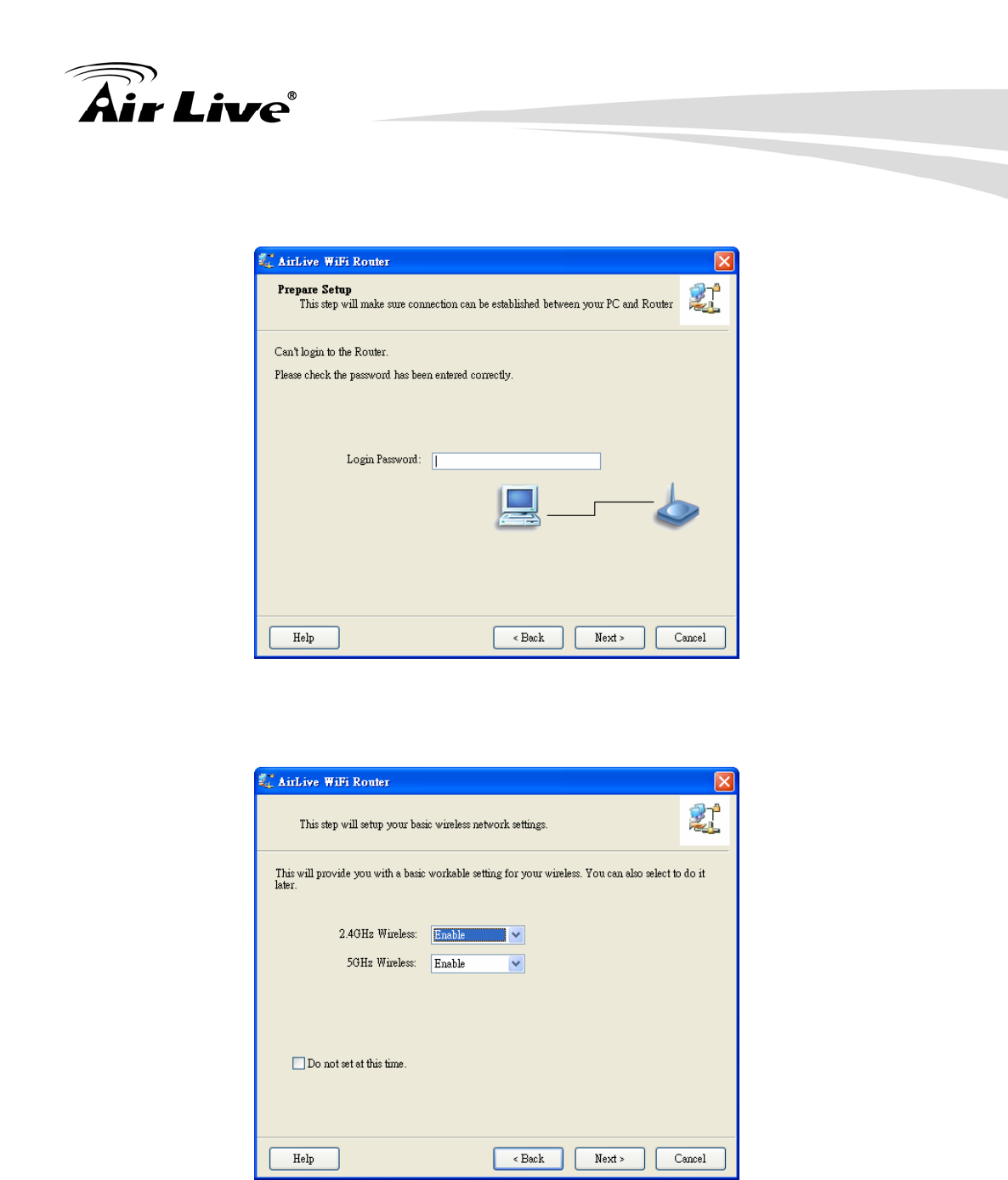
2. Getting Start
AirLive N450R User’s Manual
17
Step 5
Type-in password and then click “Next”. Default password is airlive.
Step 6
Configure the wireless interface and then click “Next”.
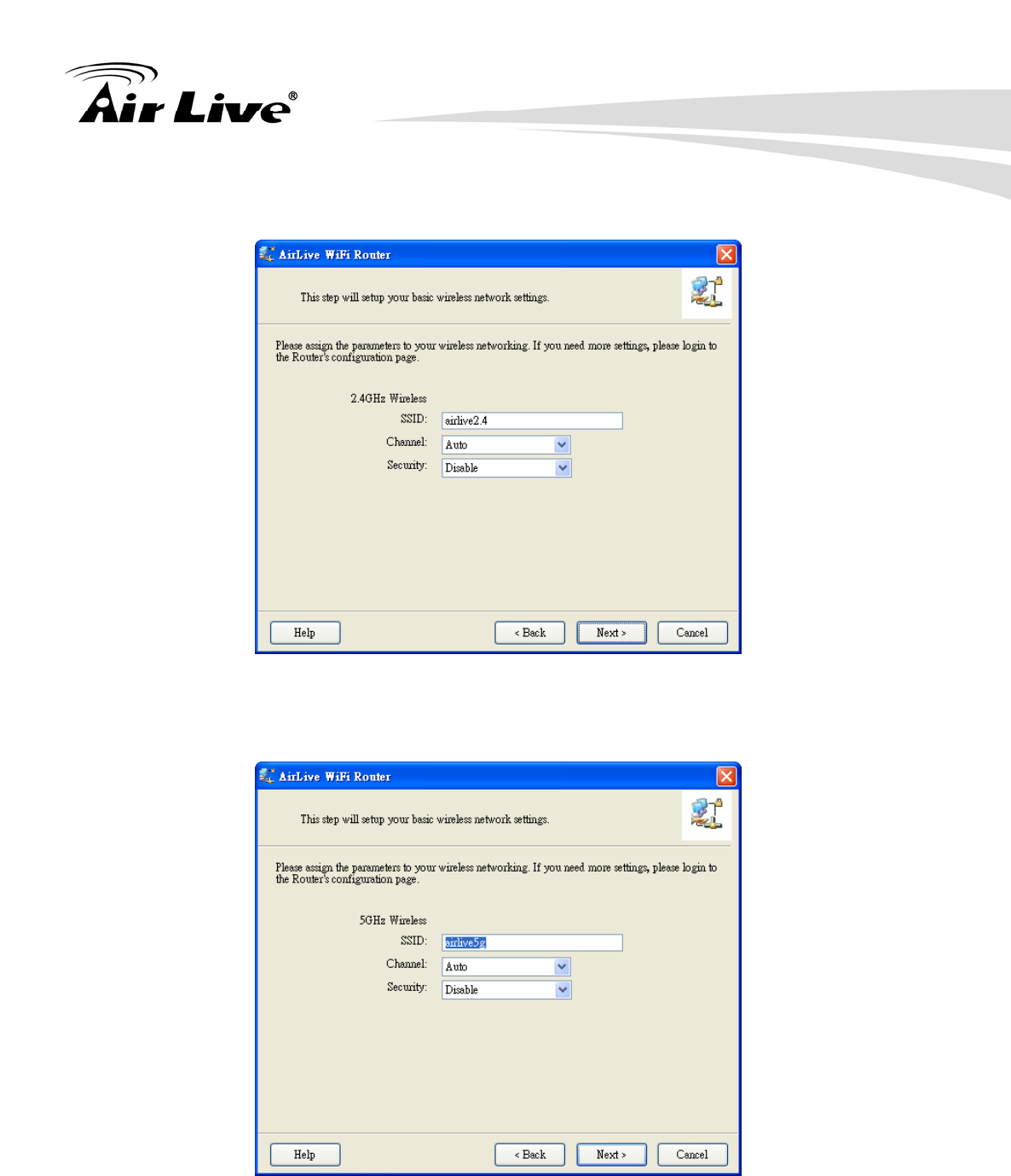
2. Getting Start
AirLive N450R User’s Manual
18
Step 7
Configure 2.4GHz wireless interface SSID, Channel and Security, and then click “Next”.
Step 8
Configure 5GHz wireless interface SSID, Channel and Security, and then click “Next”
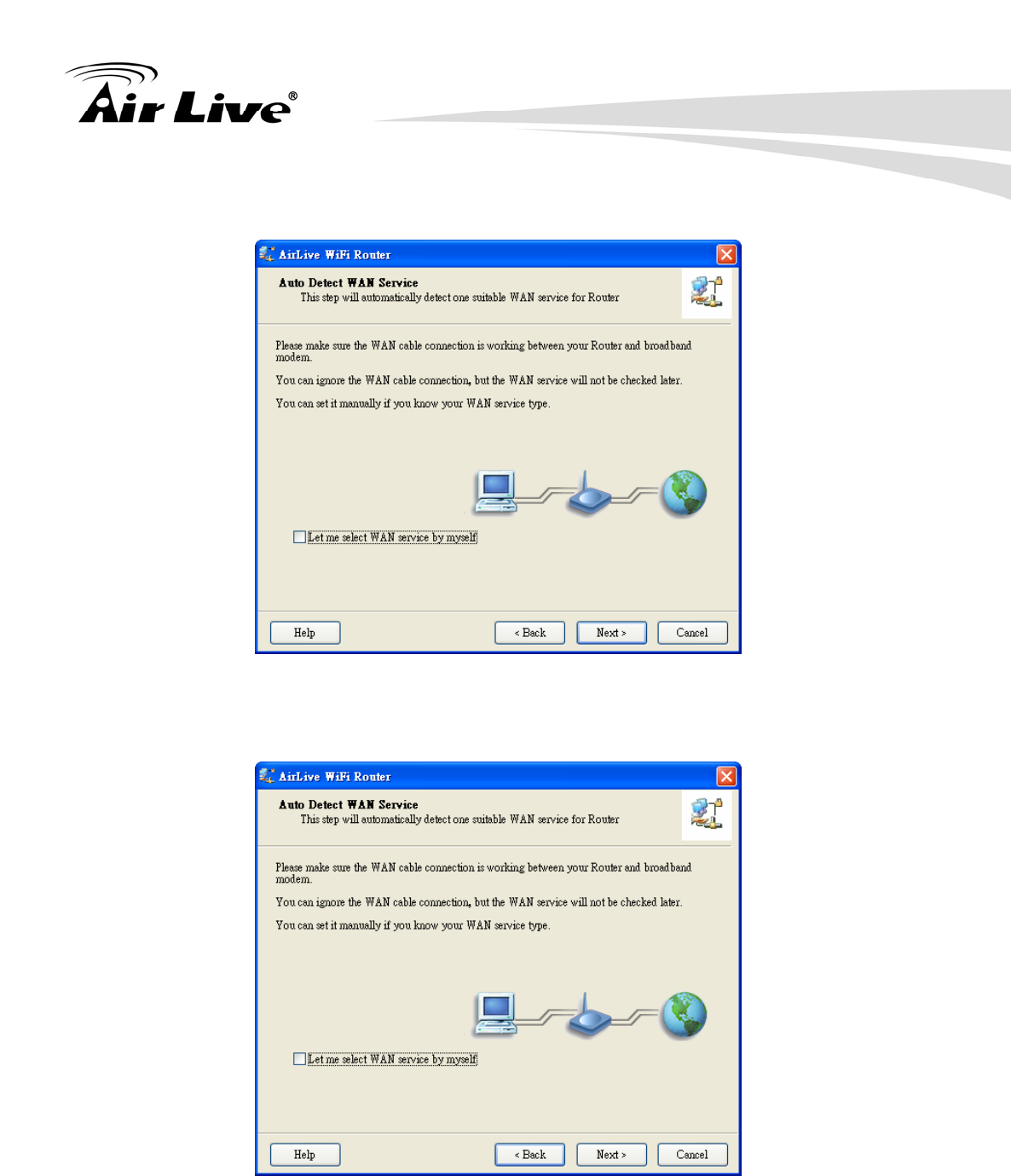
2. Getting Start
AirLive N450R User’s Manual
19
Step 9
Click Next.
Step 10
Click “Next” to detect the WAN automatically.
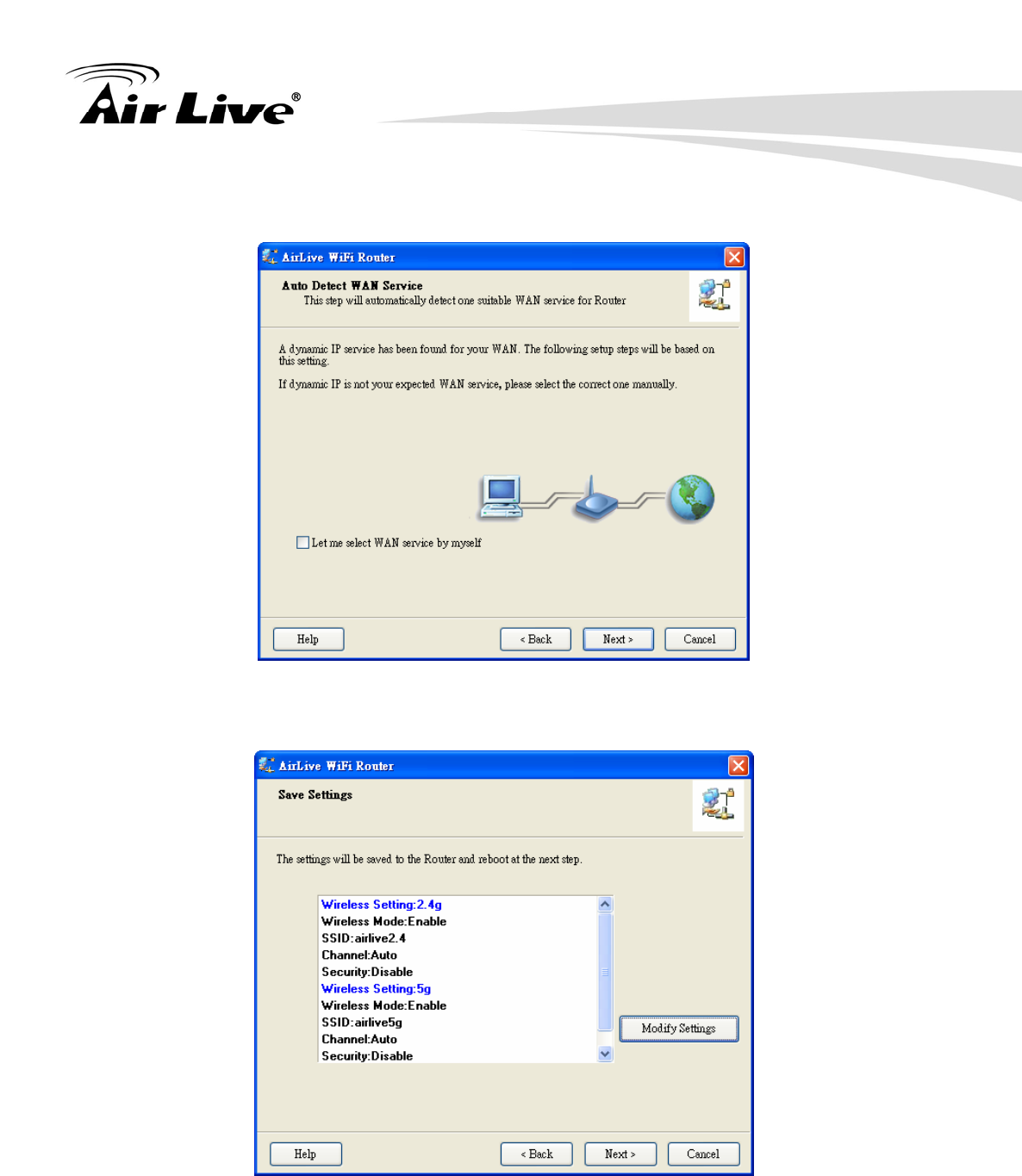
2. Getting Start
AirLive N450R User’s Manual
20
Step 11
Click “Next”.
Step 12
Click “Next”.
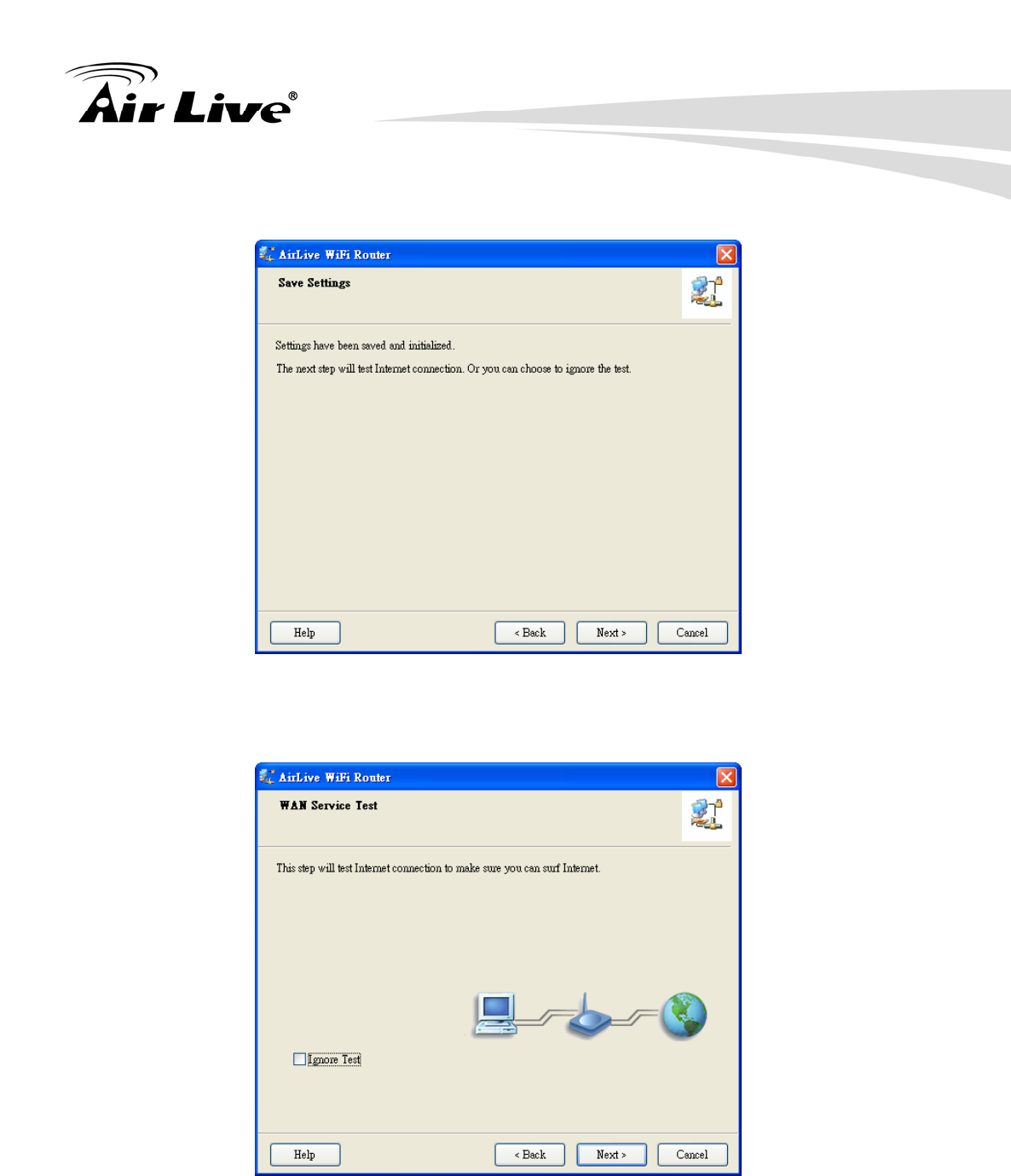
2. Getting Start
AirLive N450R User’s Manual
21
Step 13
Click “Next”.
Step 14
Click “Next” to test the internet connection.
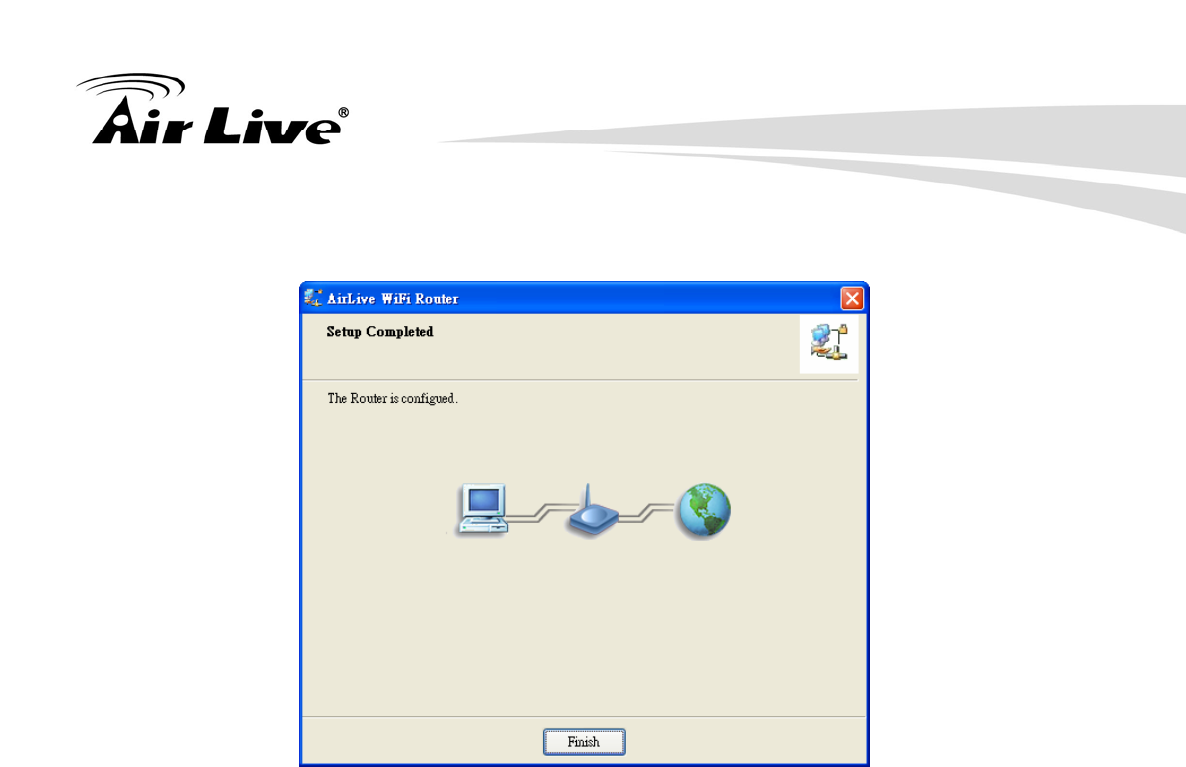
2. Getting Start
AirLive N450R User’s Manual
22
Step 15
You have completed the configuration. Click “Finish” and you can surf on the internet now.
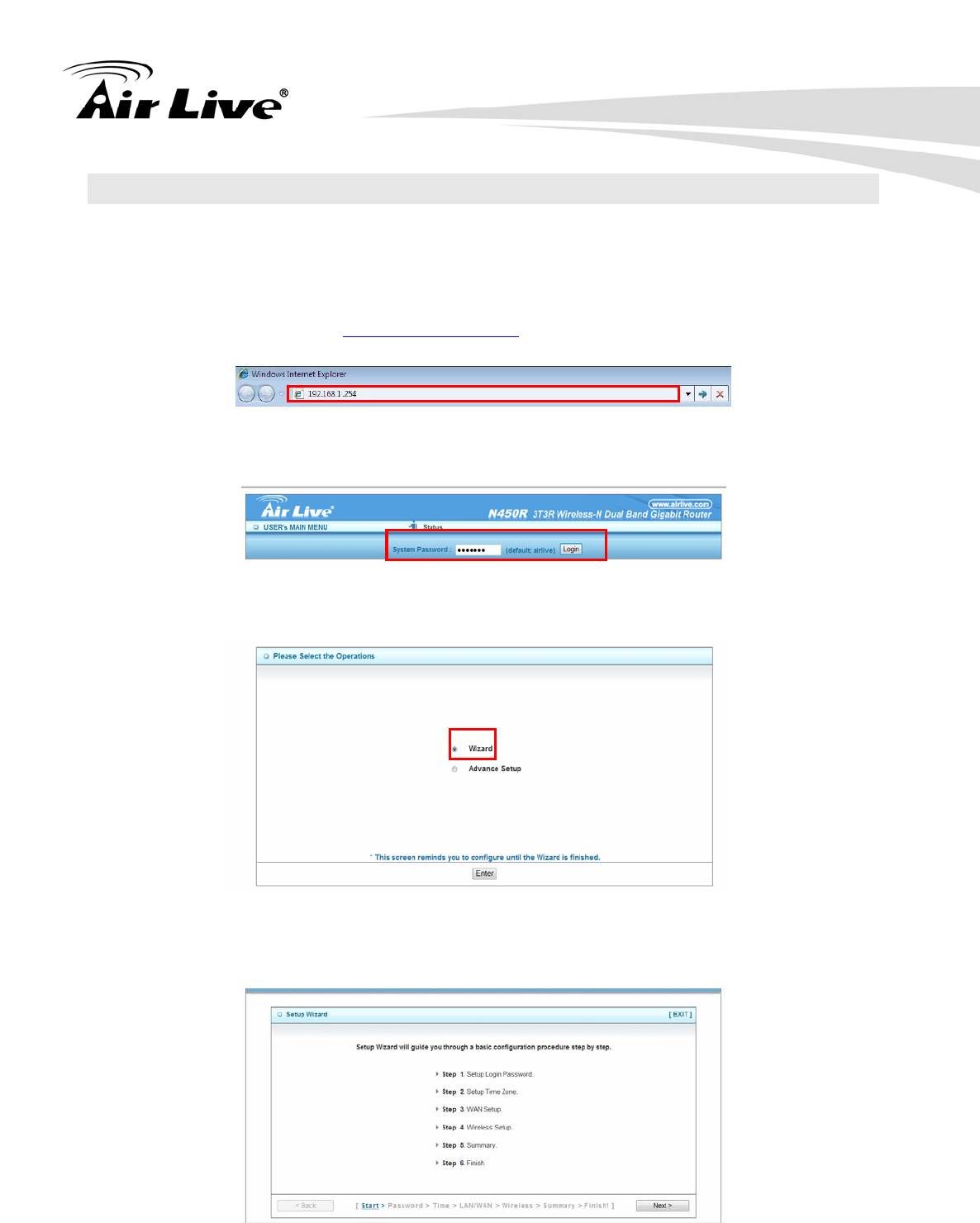
2. Getting Start
AirLive N450R User’s Manual
23
2.2 Easy Setup by Configuring Web UI
You can also browse UI of the web to configure the device
2.2.1 Browse to Activate the Setup Wizard
Type in the IP Address (http://192.168.1.254)
Type the default password ‘airlive’ in the System Password and then click ‘login’
button.
Select “Wizard” and then “Enter” for basic settings in simple way.
Press “Next” to start the Setup Wizard.
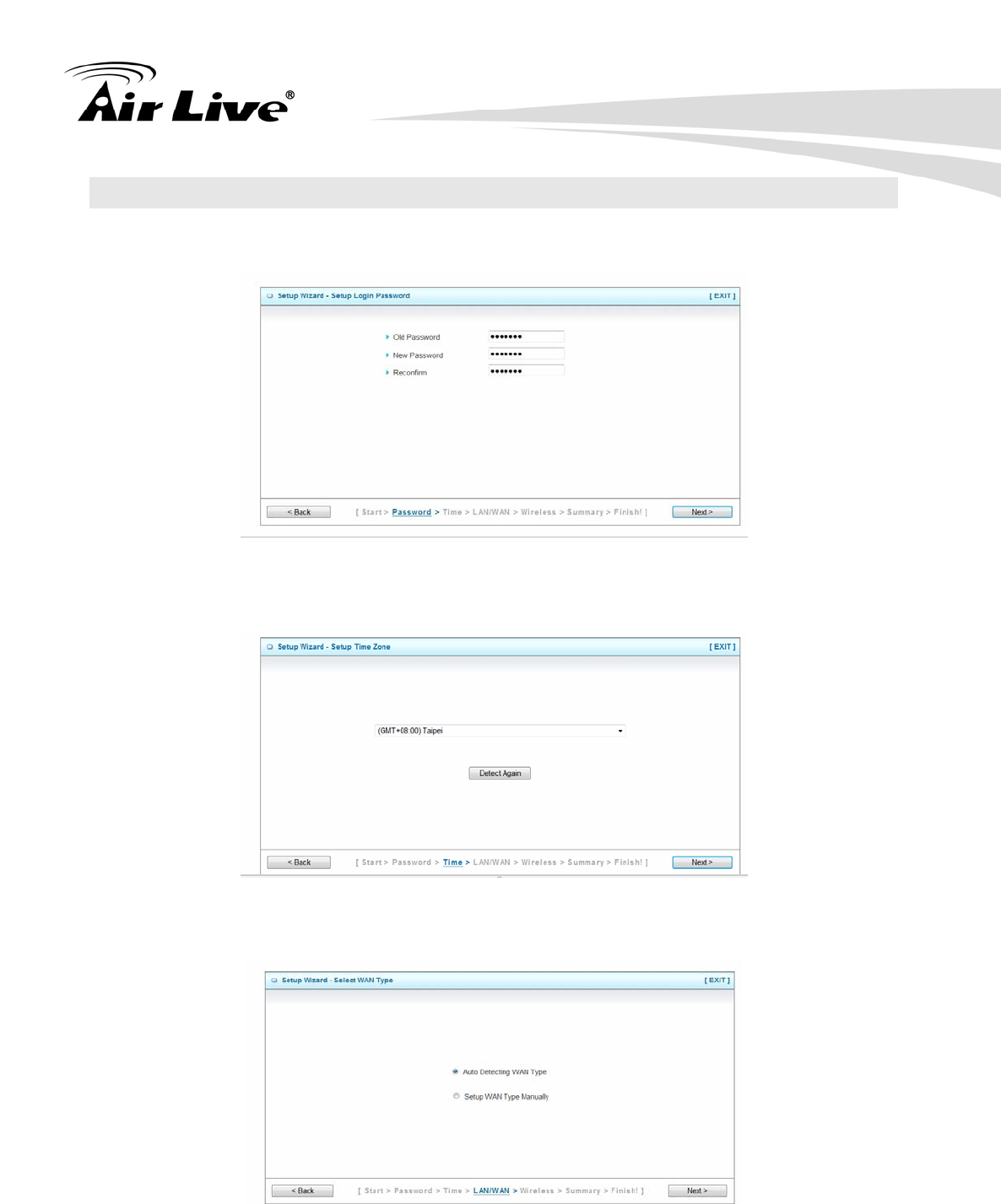
2. Getting Start
AirLive N450R User’s Manual
24
2.3 Configure with Setup Wizard
Step 1: Setup Login Password
You can change the admin password here, clicks “Next” to continue.
Step 2: Setup Time Zone
Select Time Zone, clicks “Next” to continue.
Step 3: Select WAN Type
Choose “Auto Detecting” or “Manually” Setup WAN Type.
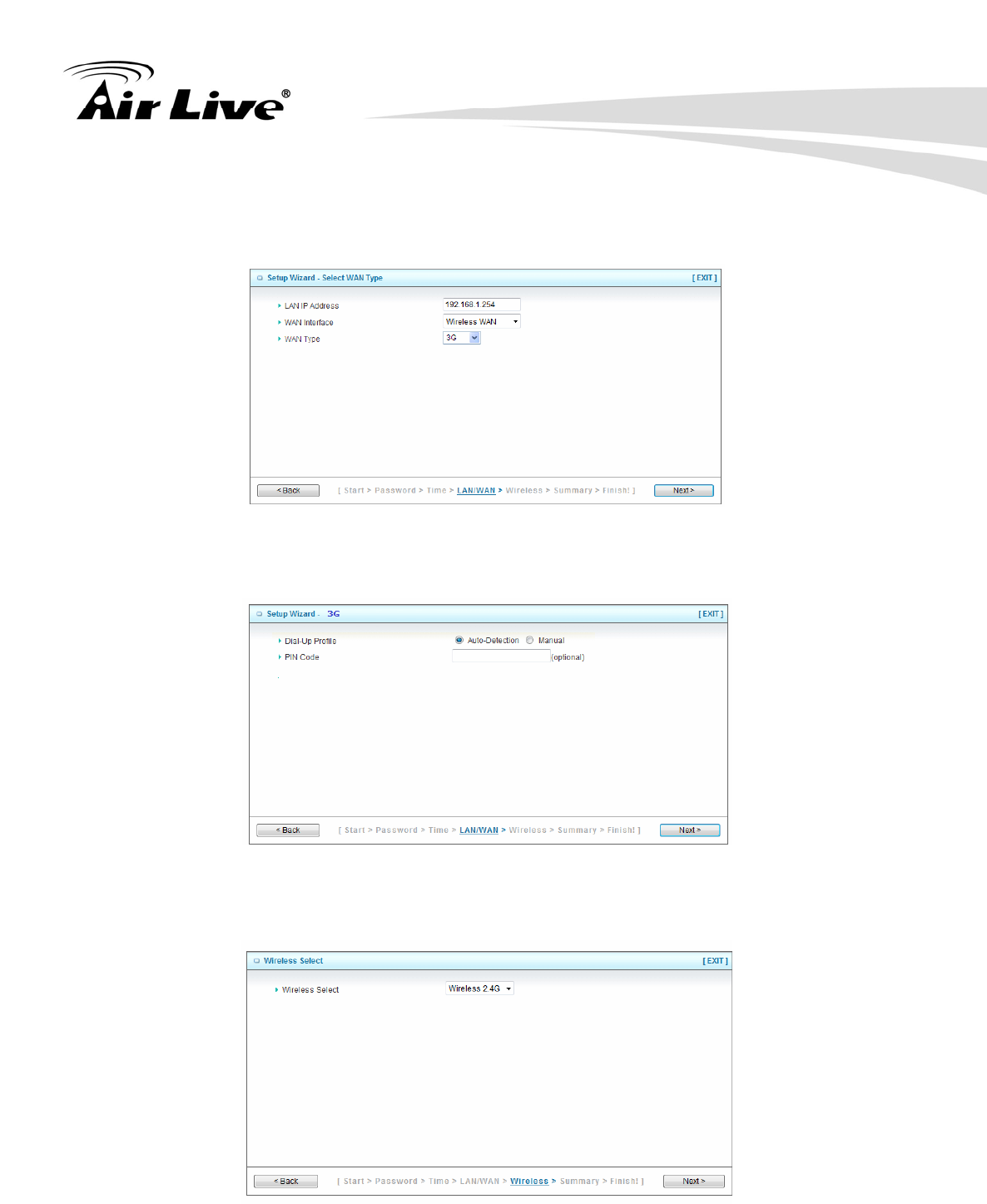
2. Getting Start
AirLive N450R User’s Manual
25
Step 4: Select WAN Type
If you want to use 3G service as the main Internet access, please set the WAN interface
as Wireless WAN and the WAN type as “3G”, and then click Next to continue.
Step 5: For 3G Mode
Select Auto-Detection, and then click Next to continue.
Step6: Wireless Settings
Set up your Wireless Network, select which wireless band you want to configure.
(e.g. Wireless 2.4G)
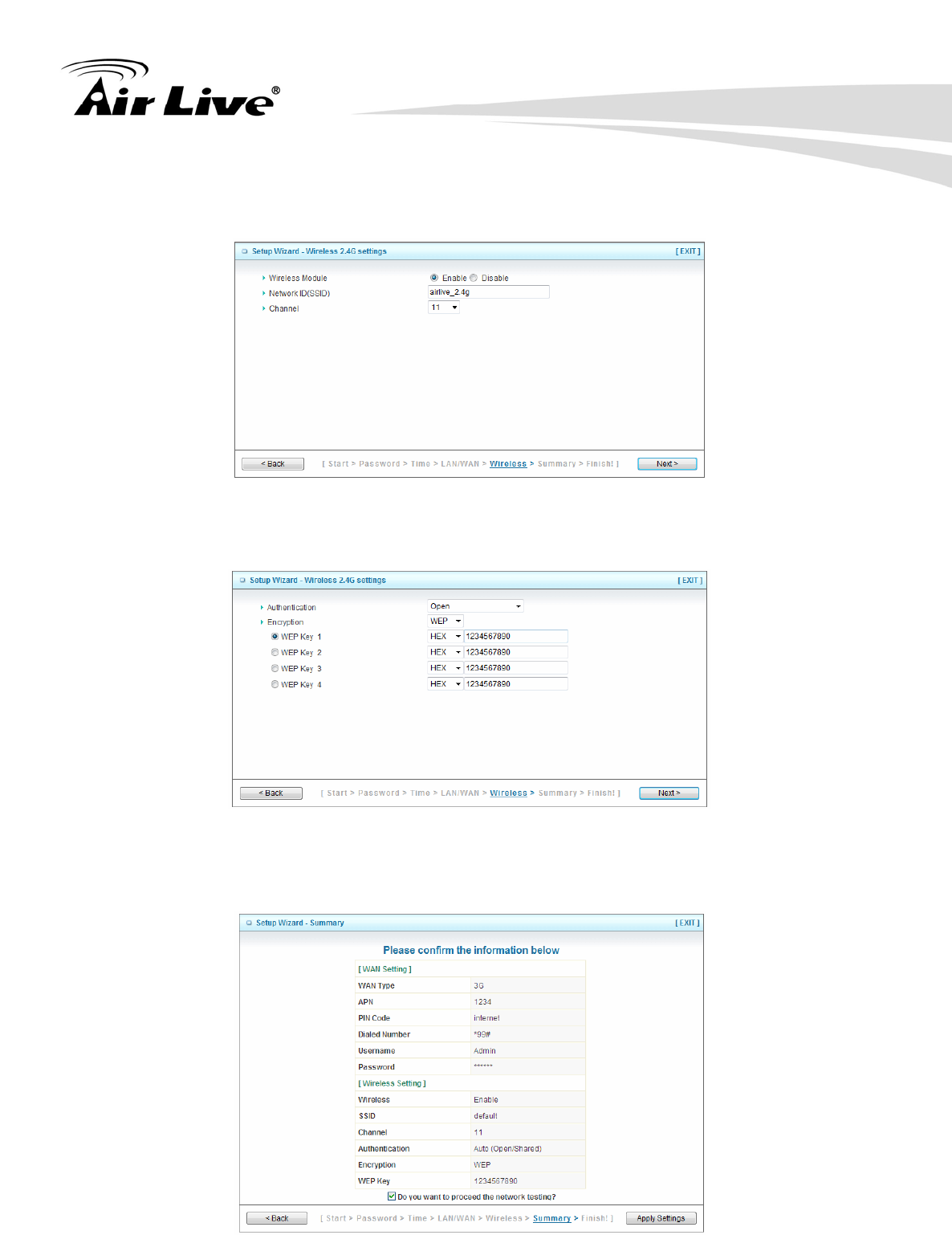
2. Getting Start
AirLive N450R User’s Manual
26
Step 7: Wireless 2.4G Settings
Setup your SSID and Wireless Channel.
Step 8
Setup Wireless Authentication and Encryption, then click Next to continue.
Step 9
Apply your Setting.
Clicks Apply Setting if finished, or click Back to previous settings.
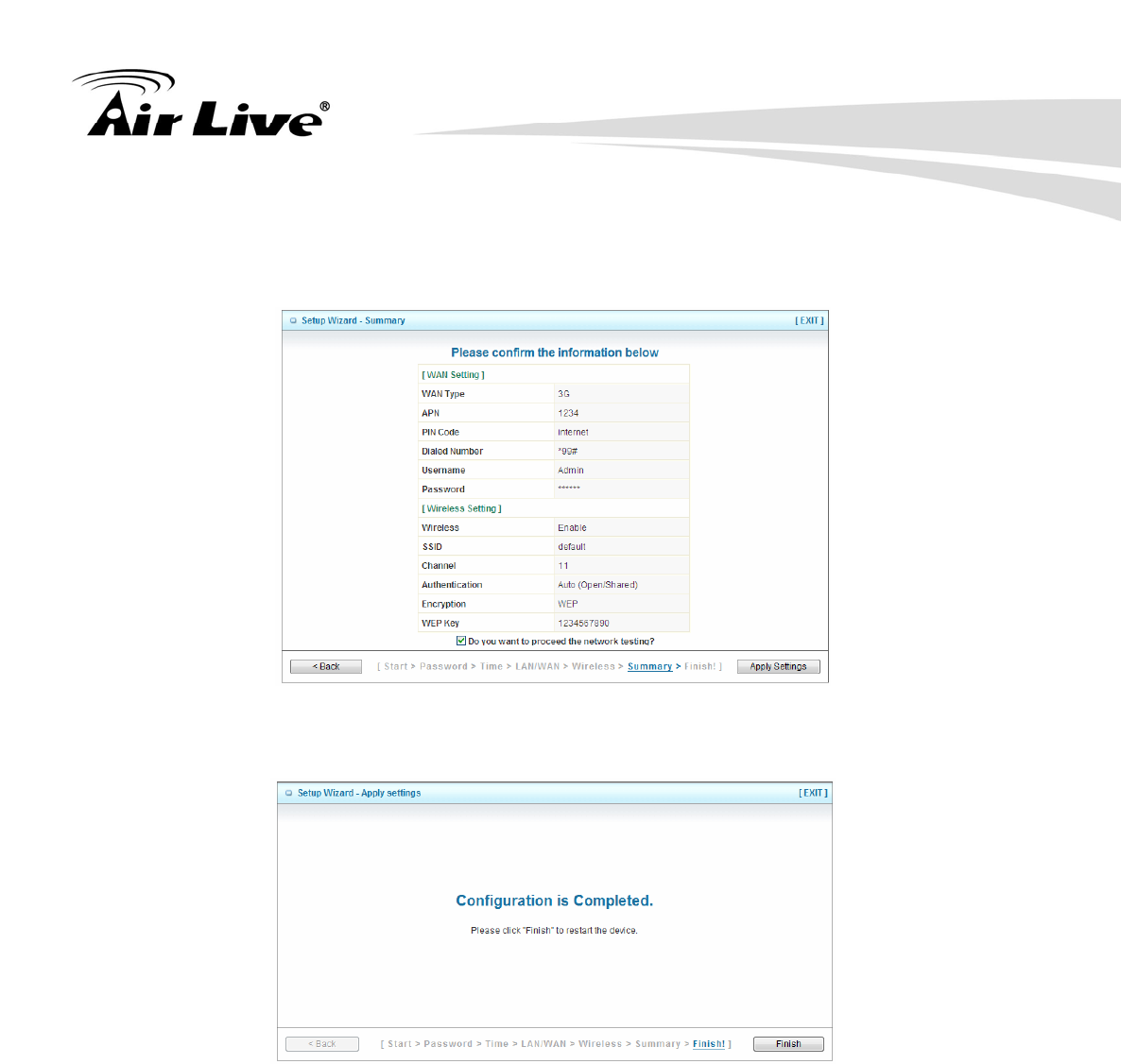
2. Getting Start
AirLive N450R User’s Manual
27
Step 10
Check the information again, click “Apply Setting” to finish all settings or “Back” to the
previous settings.
Step 11
Click “Finish” to complete it.
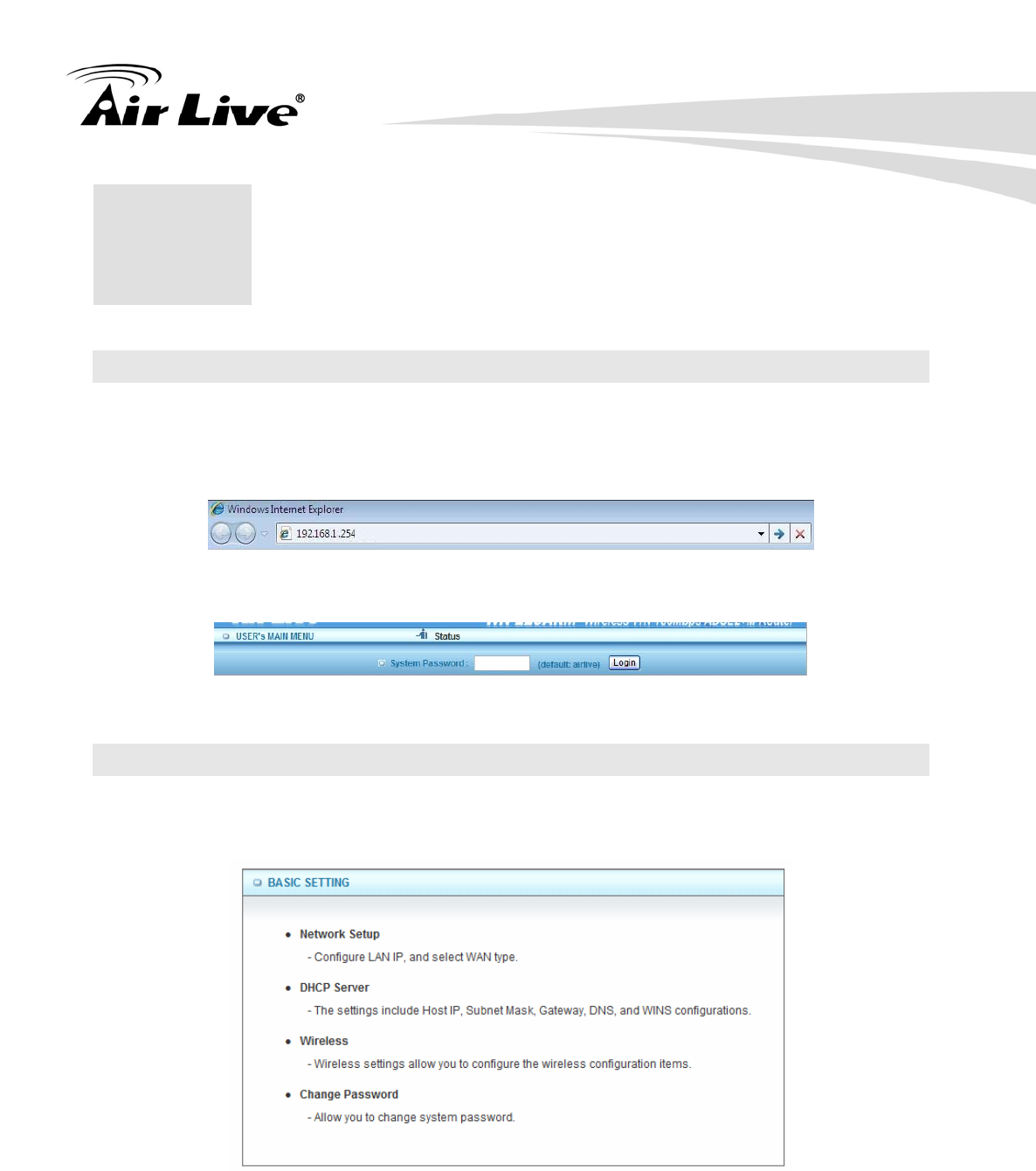
3. Configuration
AirLive N450R User’s Manual
28
3 3. Configuration
3.1 Login Web UI
Whenever you want to configure your network or this device, you can access the
Configuration Menu by opening the web-browser and typing in the IP Address of the
device. The default IP Address is: 192.168.1.254.
Enter the default password “airlive” in the System Password and then click ‘login’ button.
Then, you can browse the “Advanced” configuration pages for configuring this device.
3.2 Basic Setting
There are four options: Network Setup, DHCP Server, Wireless and Change
Password.
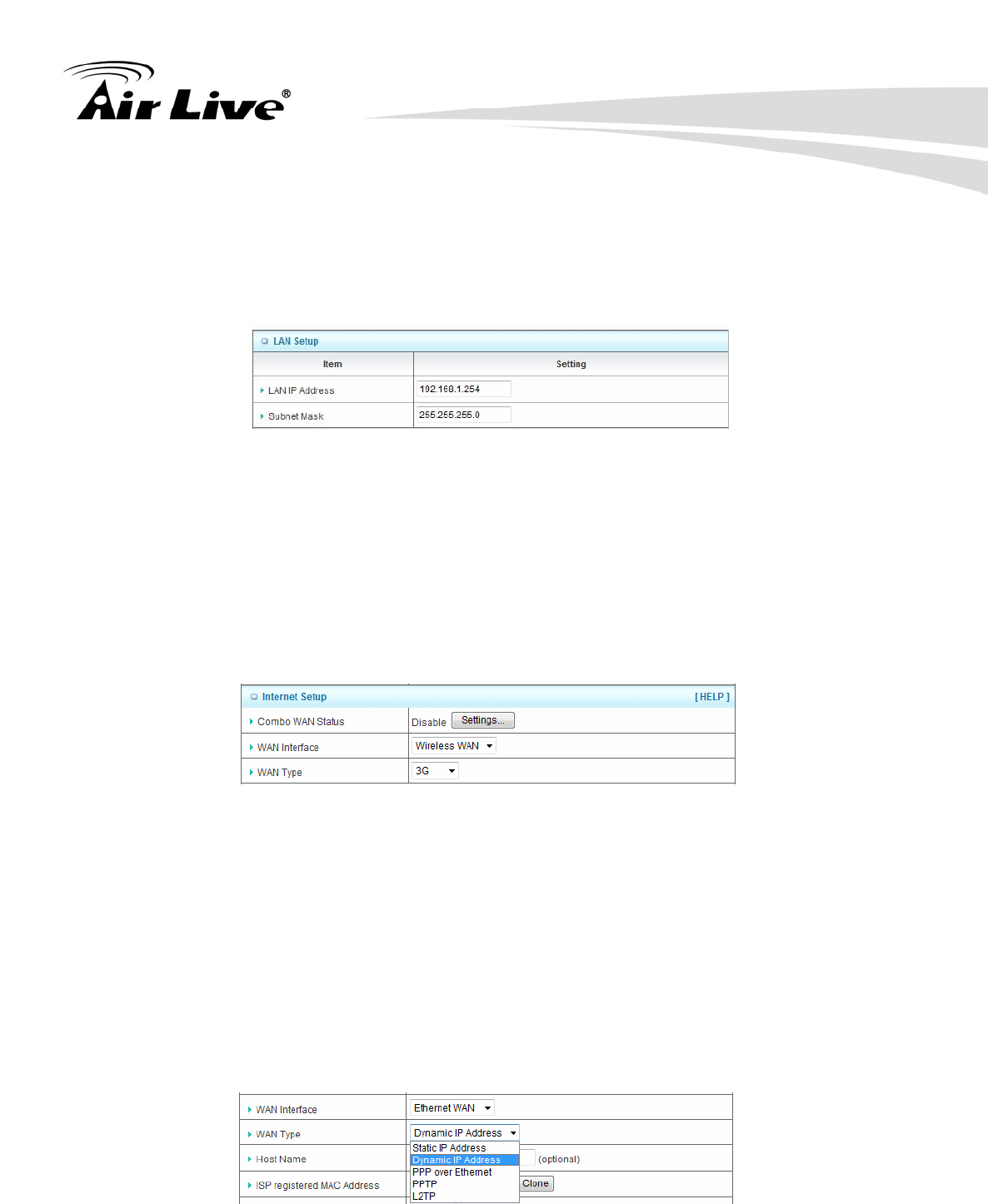
3. Configuration
AirLive N450R User’s Manual
29
3.2.1 Network Setup
There are two ways to configure the network, respectively LAN Setup and Internet
setup.
LAN Setup
1. LAN IP Address
The local IP address of this device, the computer on your network must use the LAN IP
address of this device as their Default Gateway. You can change it if necessary.
2. Subnet Mask
Input your Subnet mask. (All devices in the network must have the same subnet mask.)
The default subnet mask is 255.255.255.0.
Internet Setup
1. Combo WAN Status
Display status of combo WANS. With Combo WAN feature, you can choose one
primary WAN connection, and set another WAN connection for backup. Otherwise,
you can also choose “Load Sharing” to use Ethernet WAN and 3G WAN
simultaneously. The combo WAN status will be showed here. Press “Settings” button
to configure this feature.
2. WAN Interface
Select Ethernet WAN or Wireless WAN to continue.
Ethernet WAN
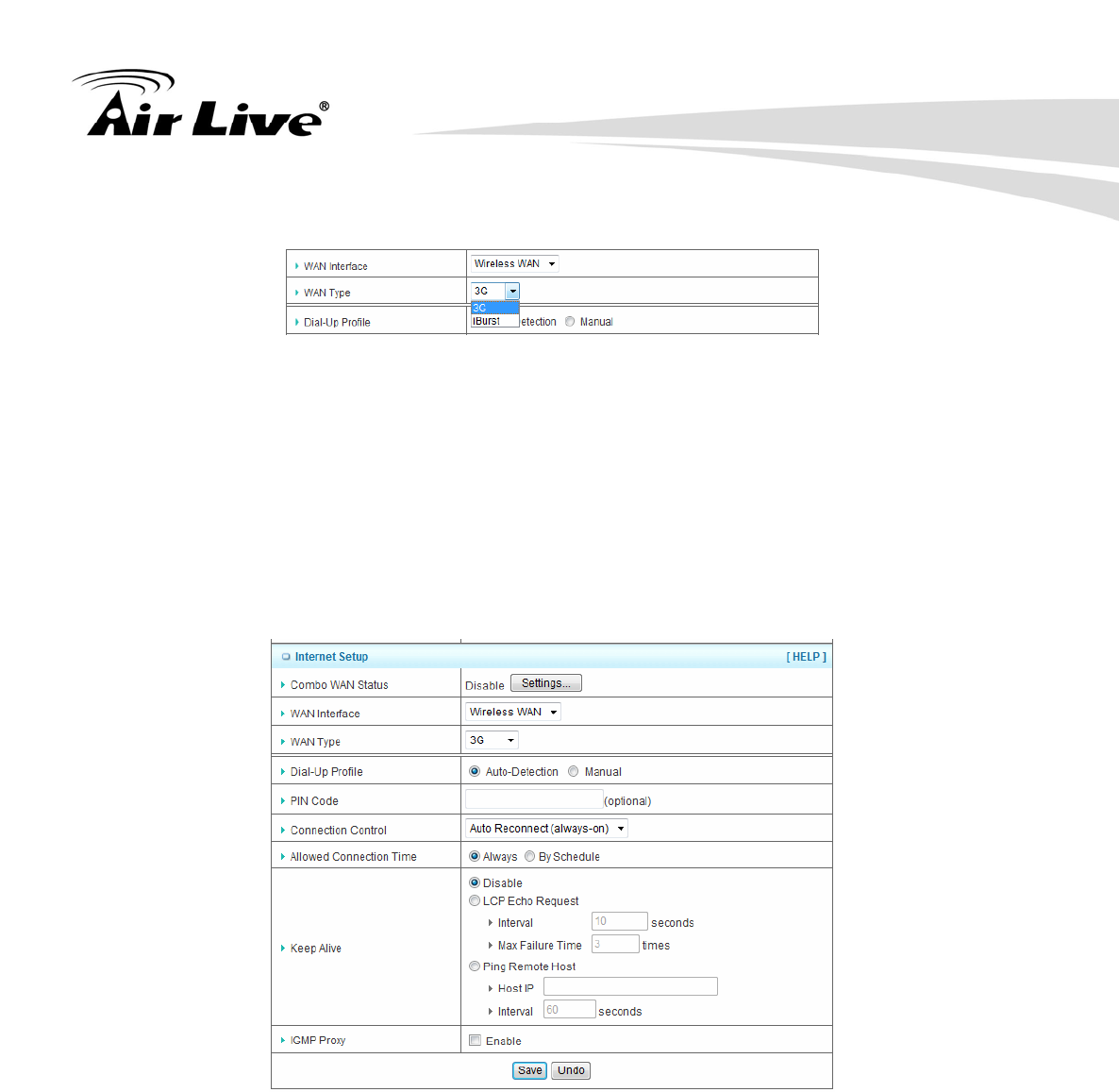
3. Configuration
AirLive N450R User’s Manual
30
Wireless WAN
1. WAN Type
WAN type of your Internet connection, select 3G and iBurst. You can choose a
correct one from the following options.
(A) 3G
This device supports different WAN types of connection for users to connect to remote
wireless ISP, such as 3G (WCDMA, HSxPA, HSPA+, CDMA2000, EV-DO, TD-SCDMA),
iBurst, or Wi-Fi Hotspot.
NOTE: You need to insert USB modem card for 3G WAN connections.
1. WAN Type
Choose 3G for WAN connection.
2. Dial-Up Profile
Please select Auto-Detection or Manual. You can choose “Auto-Detection”, and the
router will try to detect and configure the required 3G service settings automatically.
Otherwise, you can select “Manual”, and manually fill in the required 3G service
settings provided by your carrier or ISP.

3. Configuration
AirLive N450R User’s Manual
31
3. Connection Control
There are 3 options to start connection:
Auto Reconnect (Always-on)
The device will always try to link to Internet.
Connect-on-demand
The device won’t try to connect to Internet until LAN PCs or devices try to go to
Internet. Once Internet connection is established, this device will drop the
connection if maximum idle time is reached.
Manually
The device won’t try to connect to Internet until users press “connect” button at
Status page. Once Internet connection is established, this device will drop the
connection if maximum idle time is reached.
4. Allowed Connection Time
You can limit WAN connection in a period of time if required.
5. Keep Alive
There are three options for keep alive feature as below.
Disable
Disable keep alive feature.
LCP Echo Request
The device will constantly send LCP packets for keeping alive. Enter the time
interval and the maximum failure count.
Ping Remote Host
Enter the Remote host IP address and the time interval to send the ping packets
for keeping alive.
6. NAT Disable
You can disable NAT feature if required.
7. IGMP Proxy
Enable this feature allows multicast stream (e.g. IPTV stream) to pass-through this
device.
NOTE: The items with * above are only available when choosing Manual for Dial-up
Profile.
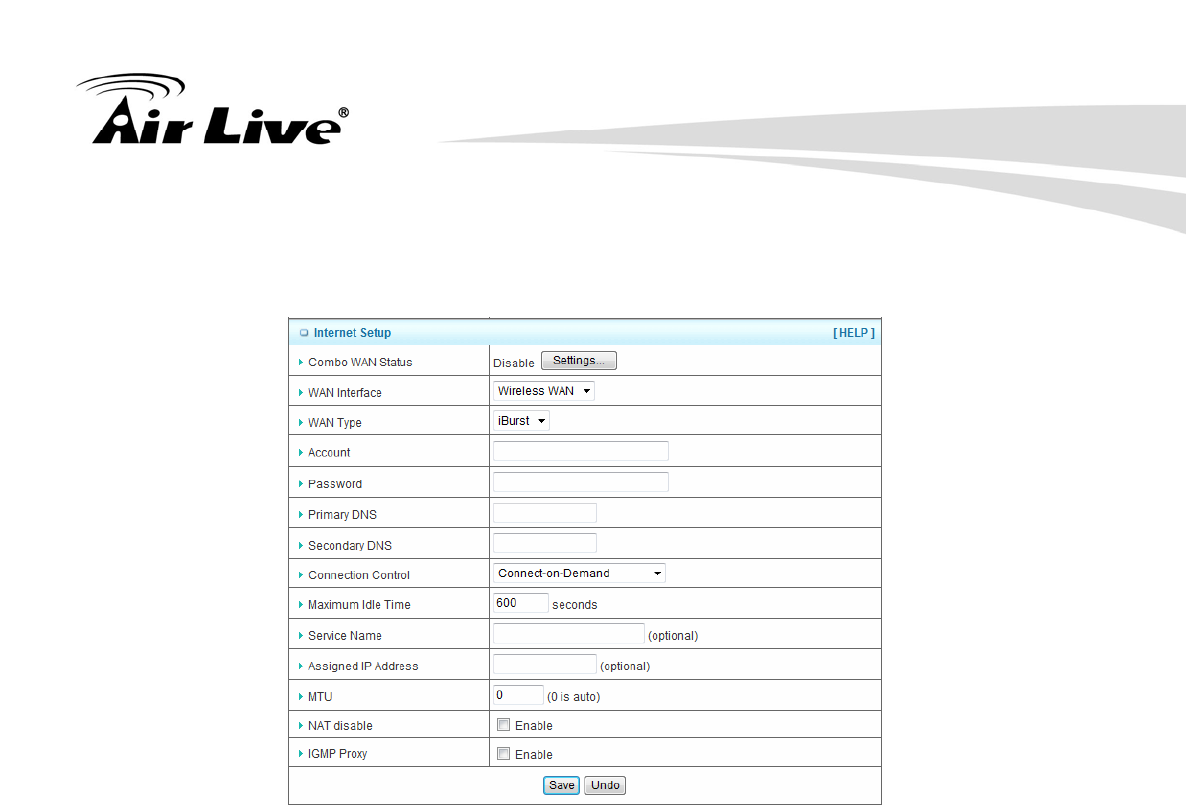
3. Configuration
AirLive N450R User’s Manual
32
(B) iBurst
NOTE: You need to insert USB modem card for iBurst WAN connections.
1. WAN Type
Choose iBurst for WAN connection.
2. Account
Enter the User Name for iBurst connection.
3. Password
Enter new Password for iBurst connection.
4. Primary DNS
You can assign a Primary DNS server if required. (Optional)
5. Secondary DNS
You can assign a Secondary DNS server if required. (Optional)
6. Connection Control
There are 3 options to start connection:
Auto Reconnect (Always-on)
The device will always try to link to Internet.
Connect-on-demand
The device won’t try to connect to Internet until LAN PCs or devices try to go to
Internet. Once Internet connection is established, this device will drop the
connection if maximum idle time is reached.
Manually
The device won’t try to connect to Internet until users press “connect” button at
Status page. Once Internet connection is established, this device will drop the
connection if maximum idle time is reached.
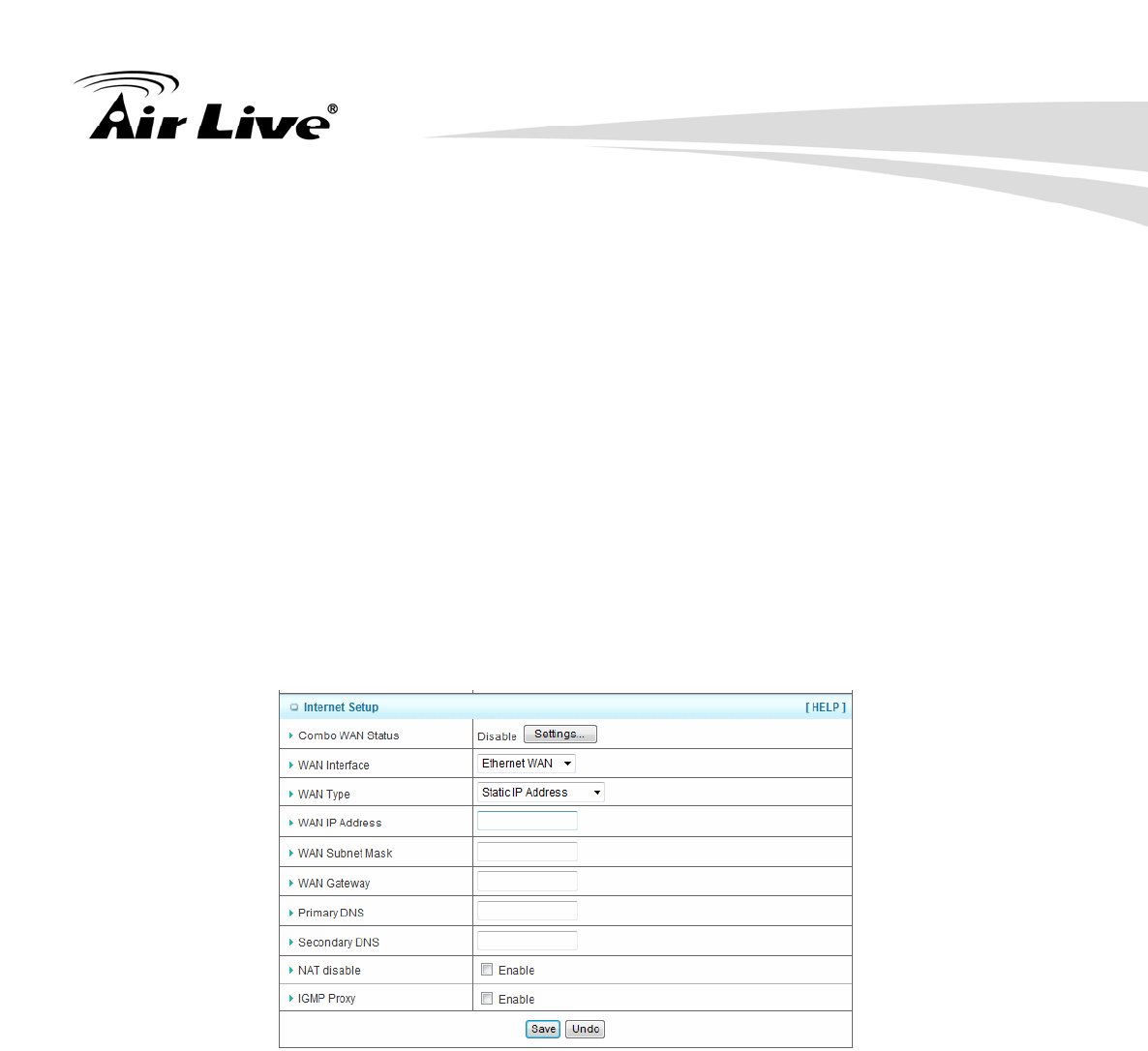
3. Configuration
AirLive N450R User’s Manual
33
7. Maximum Idle Time
The amount of time of inactivity before disconnecting Internet connection. Set it to zero,
or choosing “Auto-reconnect” mode to disable this feature.
8. Service Name
Input the service name if your ISP requires it. (Optional)
9. Assigned IP Address
Input a IP address if your ISP requires it. (Optional)
10. Maximum Transmission Unit (MTU)
You can change MTU value if required. The default MTU value is set to 0 (auto).
11. NAT disable
You can disable NAT feature if required.
12. IGMP Proxy
Enable this feature allows multicast stream (e.g. IPTV stream) to pass-through this
device.
(C) Static IP Address
1. WAN Type
Choose Static IP Address.
2. WAN IP Address
Input the IP address you got from ISP.
3. Subnet Mask
Input the subnet mask of IP address you got from ISP.
4. WAN Gateway
Input the IP address of WAN gateway you got from ISP.
5. Primary DNS
Input the IP address of primary DNS you got from ISP.
6. Secondary DNS
Input the IP address of secondary DNS you got from ISP.
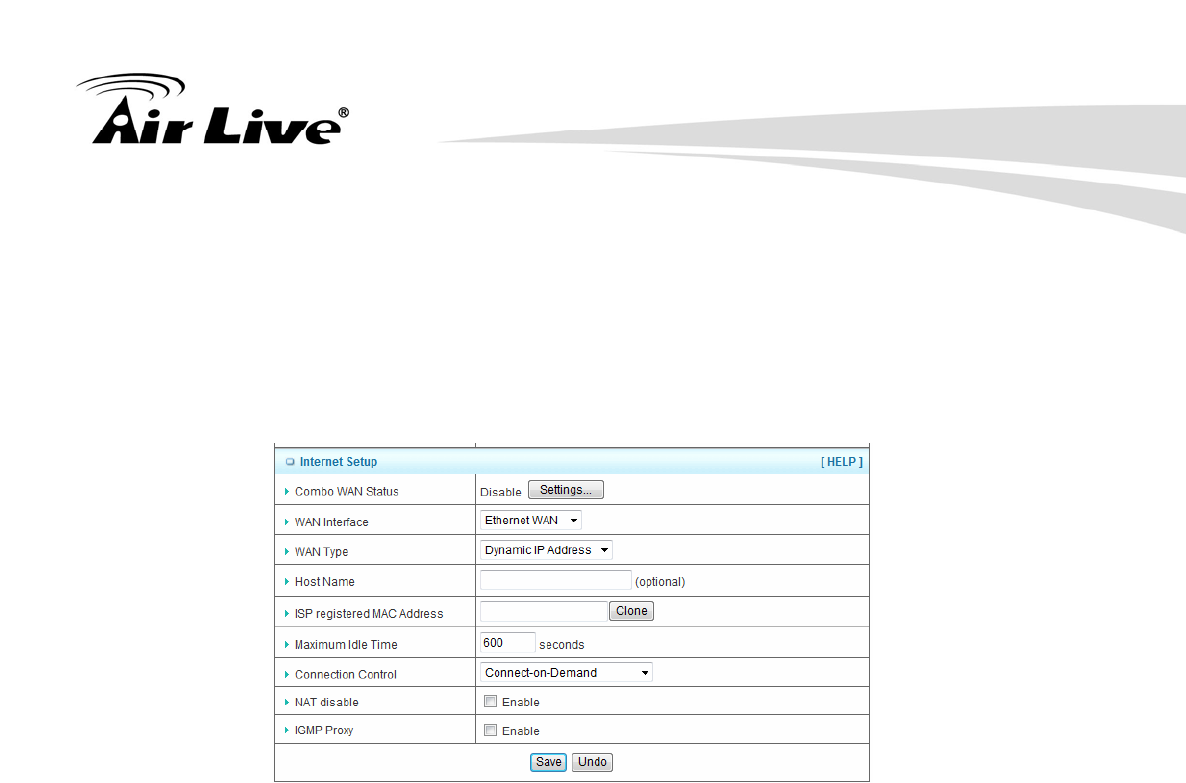
3. Configuration
AirLive N450R User’s Manual
34
7. NAT disable
You can disable NAT feature if required.
8. IGMP Proxy
Enable this feature allows multicast stream (e.g. IPTV stream) to pass-through this
device.
(D) Dynamic IP Address
1. WAN Type
Choose Dynamic IP Address.
2. Host Name
Optional, required by some ISPs, for example, @Home.
3. ISP registered MAC Address
Some ISP (Cable Company) will record your MAC address on PC. You can press
“Clone” button to copy the MAC address on your PC here, or you can input it manually.
4. Maximum Idle Time
The amount of time of inactivity before disconnecting Internet connection. Set it to zero,
or choosing “Auto-reconnect” mode to disable this feature.
5. Connection Control
There are 3 options to start connection:
Auto Reconnect (Always-on)
The device will always try to link to Internet.
Connect-on-demand
The device won’t try to connect to Internet until LAN PCs or devices try to go to
Internet. Once Internet connection is established, this device will drop the
connection if maximum idle time is reached.
Manually
The device won’t try to connect to Internet until users press “connect” button at
Status page. Once Internet connection is established, this device will drop the
connection if maximum idle time is reached.
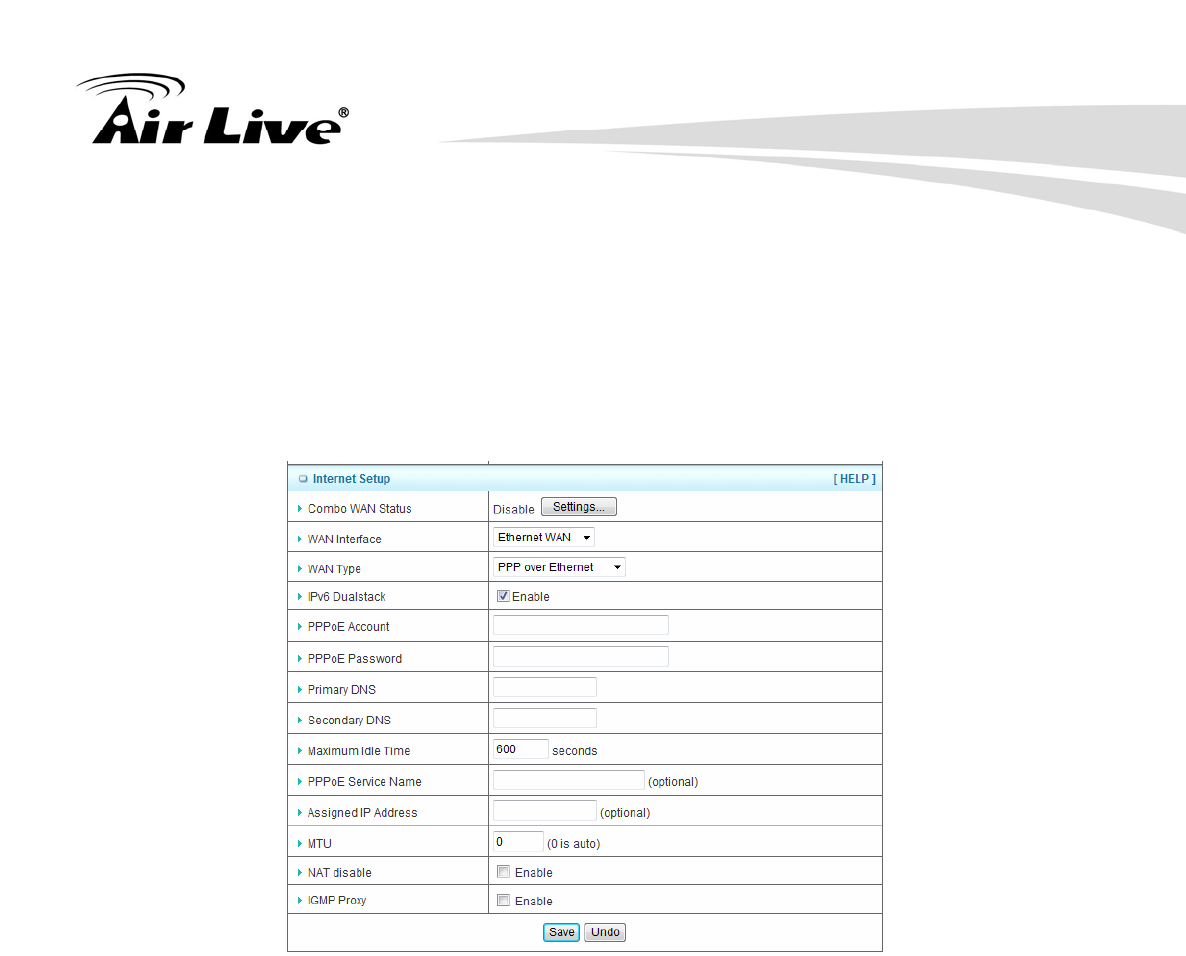
3. Configuration
AirLive N450R User’s Manual
35
6. NAT disable
You can disable NAT feature if required.
7. IGMP Proxy
Enable this feature allows multicast stream (e.g. IPTV stream) to pass-through this
device.
(E) PPP over Ethernet
1. WAN Type
Choose PPP over Ethernet.
2. IPv6 Dual Stack
If your ISP supports IPv6 dual stack, you can check this check box to get an IPv4
address and an IPv6 address via one PPPoE connection. After you check this check
box, you also need to enable IPv6 function at Advanced Setting->IPv6 setting page.
3. PPPoE Account and Password
The account and password your ISP assigned to you.
4. Primary DNS
You can indicate IP address of primary DNS if required.
5. Secondary DNS
You can indicate IP address of secondary DNS if required.
6. Maximum Idle Time
The amount of time of inactivity before disconnecting your PPPoE session. Set it to
zero or enable “Auto-reconnect” to disable this feature.
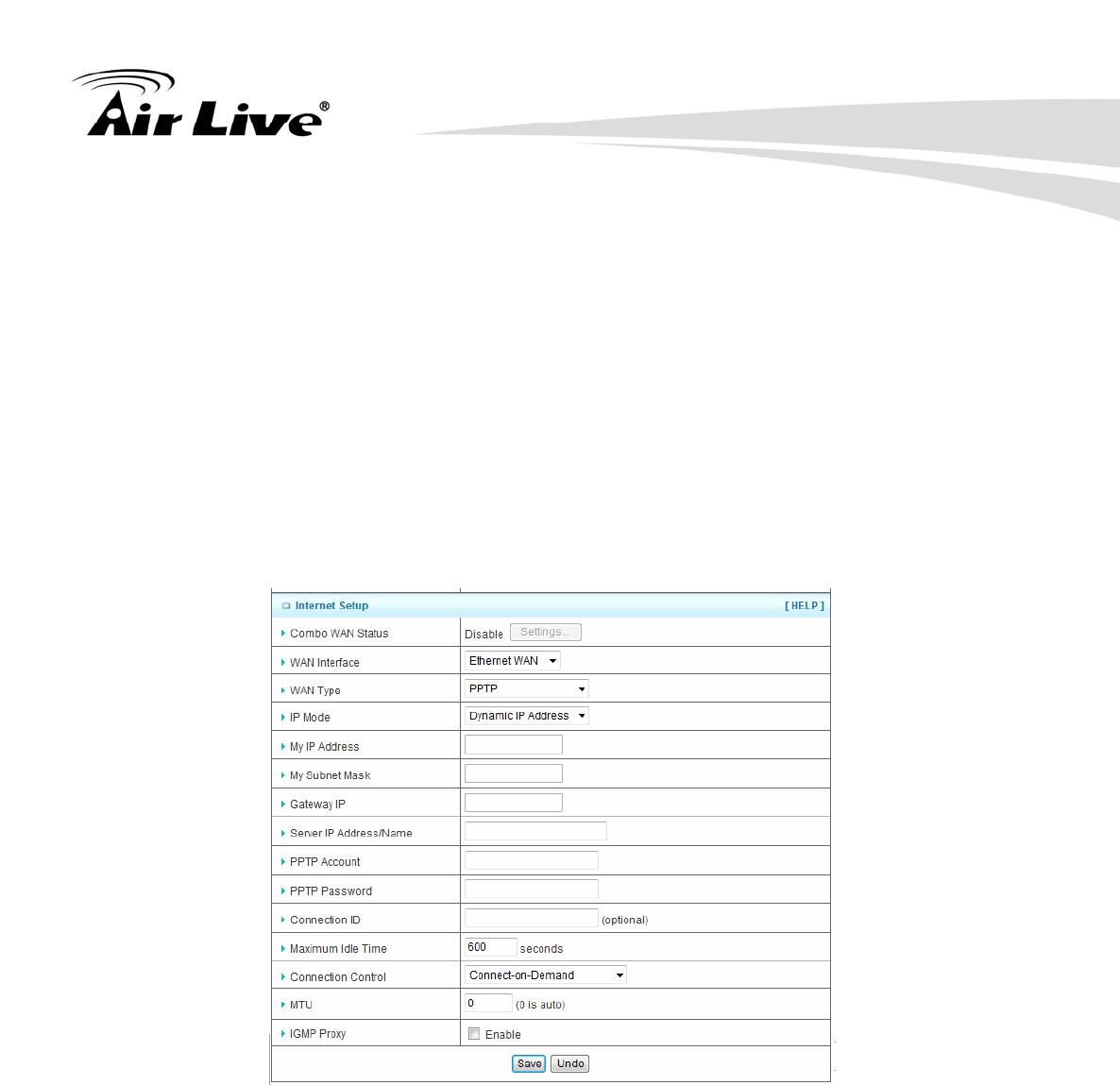
3. Configuration
AirLive N450R User’s Manual
36
7. PPPoE Service Name
Optional. Input the service name if your ISP requires it.
8. Assigned IP Address
You can input a IP address if you got a fix IP address from ISP.
9. Maximum Transmission Unit (MTU)
Most ISP offers MTU value to users. The default MTU value is 0 (auto).
10. NAT disable
You can disable NAT feature if required.
11. IGMP Proxy
Enable this feature allows multicast stream (e.g. IPTV stream) to pass-through this
device.
(F) PPTP
1. WAN Type
Choose PPTP.
2. IP Mode
You can select “Static IP Address” or “Dynamic IP Address”.
3. My IP Address*, My Subnet Mask*, and Gateway IP*
The IP address, subnet mask, and IP address of gateway your ISP assigned to you.
4. Server IP Address/Name
The IP address of the PPTP server.
5. PPTP Account and Password
The account and password your ISP assigned to you.

3. Configuration
AirLive N450R User’s Manual
37
6. Connection ID
Optional. Input the connection ID if your ISP requires it.
7. Maximum Idle Time
The amount of time of inactivity before disconnecting your PPTP session. Set it to zero
or enable “Auto-reconnect” to disable this feature.
8. Connection Control
There are 3 options to start connection:
Auto Reconnect (Always-on)
The device will always try to link to Internet.
Connect-on-demand
The device won’t try to connect to Internet until LAN PCs or devices try to go to
Internet. Once Internet connection is established, this device will drop the
connection if maximum idle time is reached.
Manually
The device won’t try to connect to Internet until users press “connect” button at
Status page. Once Internet connection is established, this device will drop the
connection if maximum idle time is reached.
9. Maximum Idle Time
The time of no activity to disconnect your PPTP session. Set it to zero or enable
“Auto-reconnect” to disable this feature.
10. Maximum Transmission Unit (MTU)
Most ISP offers MTU value to users. The default MTU value is 0 (auto).
11. IGMP Proxy
Enable this feature allows multicast stream (e.g. IPTV stream) to pass-through this
device.
NOTE: The items with * above are only available when choosing Static IP Address in IP
mode.
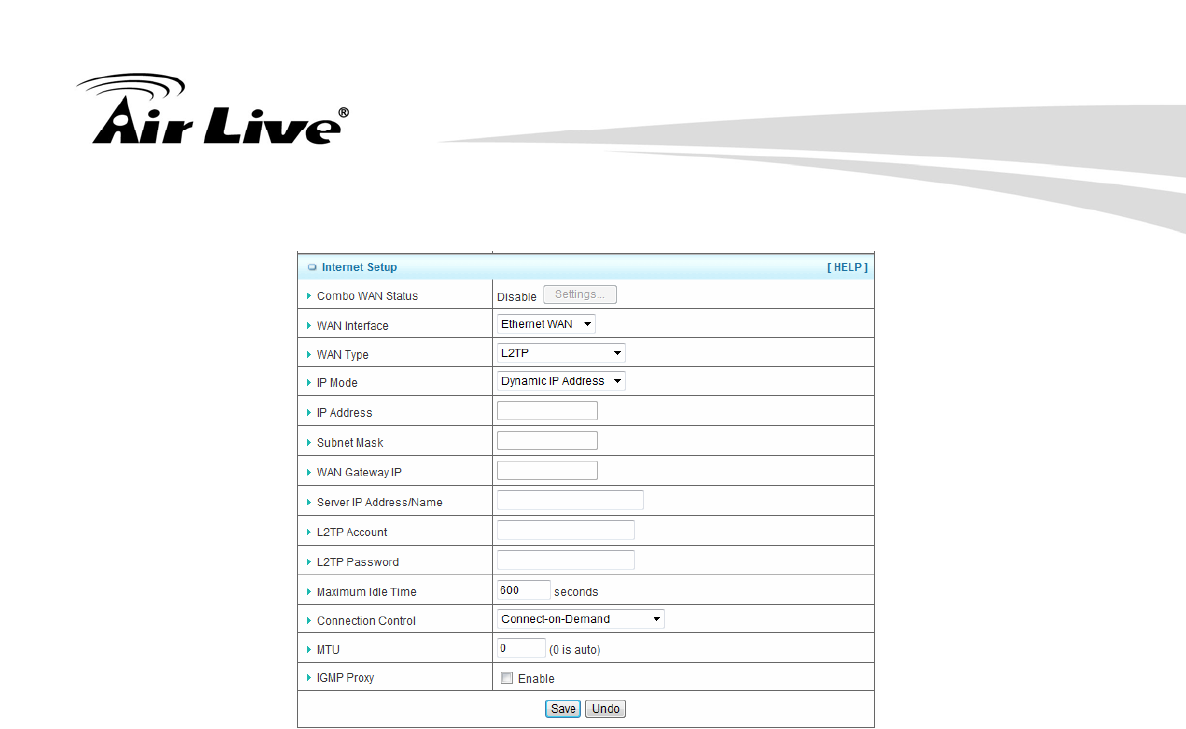
3. Configuration
AirLive N450R User’s Manual
38
(G) L2TP
1. WAN Type
Choose L2TP.
2. IP Mode
You can select “Static IP Address” or “Dynamic IP Address”.
3. My IP Address*, My Subnet Mask*, and Gateway IP*
The IP address, subnet mask, and IP address of gateway your ISP assigned to you.
4. Server IP Address/Name
The IP address of the L2TP server.
5. L2TP Account and Password
The account and password your ISP assigned to you.
6. Maximum Idle Time
The time of no activity to disconnect your L2TP session. Set it to zero or enable
“Auto-reconnect” to disable this feature.
7. Connection Control
There are 3 options to start connection:
Auto Reconnect (Always-on)
The device will always try to link to Internet.
Connect-on-demand
The device won’t try to connect to Internet until LAN PCs or devices try to go to
Internet. Once Internet connection is established, this device will drop the
connection if maximum idle time is reached.
Manually
The device won’t try to connect to Internet until users press “connect” button at
Status page. Once Internet connection is established, this device will drop the
connection if maximum idle time is reached.
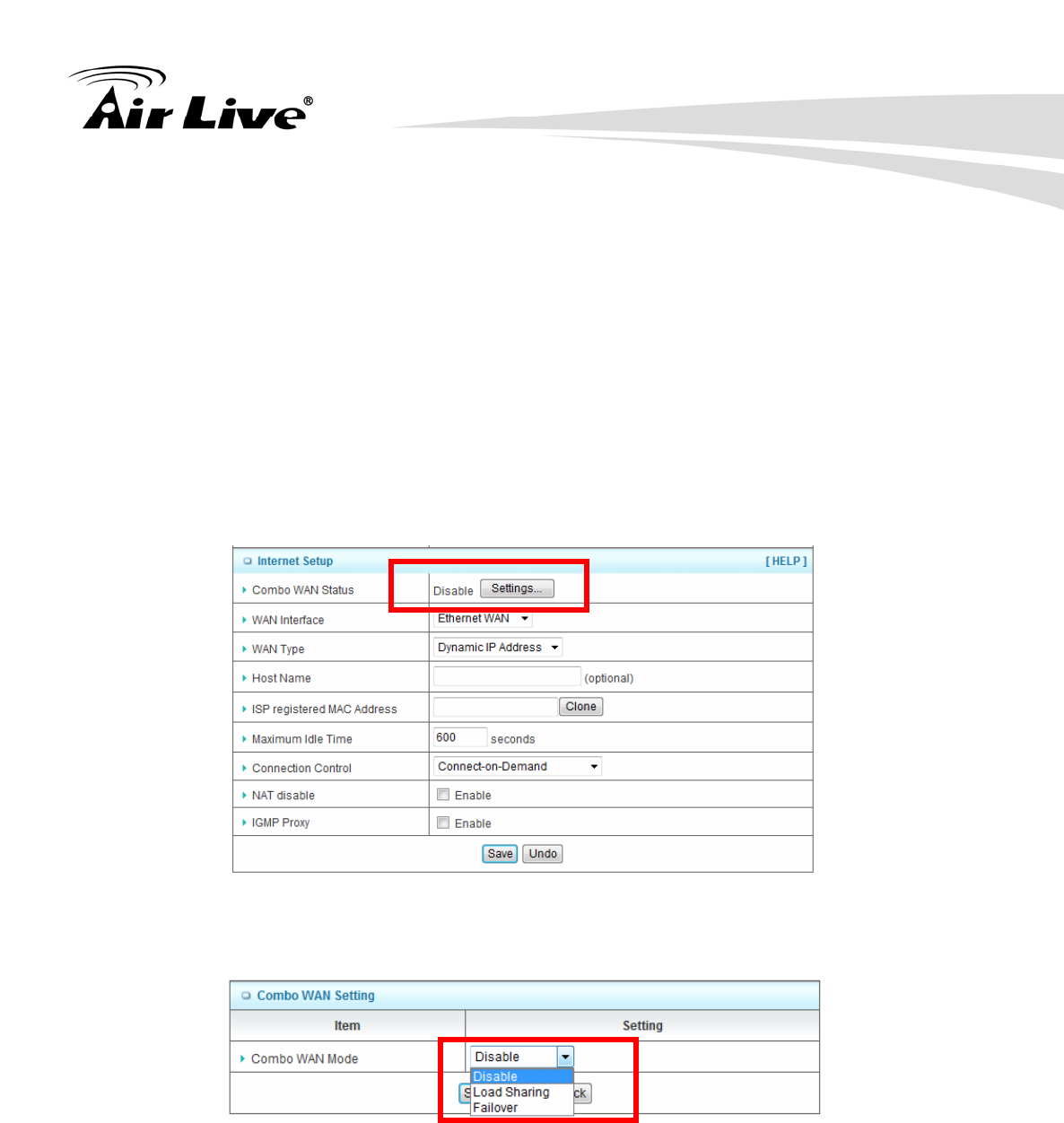
3. Configuration
AirLive N450R User’s Manual
39
8. Maximum Transmission Unit (MTU)
Most ISP offers MTU value to users. The default MTU value is 0 (auto).
9. IGMP Proxy
Enable this feature allows multicast stream (e.g. IPTV stream) to pass-through this
device.
Note: The items with * above are only available when choosing Static IP Address in IP
mode.
(H) Combo WAN Setting
With Combo WAN feature, you can choose one primary WAN connection, and set another
WAN connection for backup. Otherwise, you can also choose “Load Sharing” to use
Ethernet WAN and 3G WAN simultaneously. The combo WAN status will be showed at
Internet Setup page. Press “Settings” button to configure this feature.
At Combo WAN setting page, you can choose Disable, Load Sharing, or Failover
options. This Combo WAN feature will be deactivated if you select “Disable” from the list.
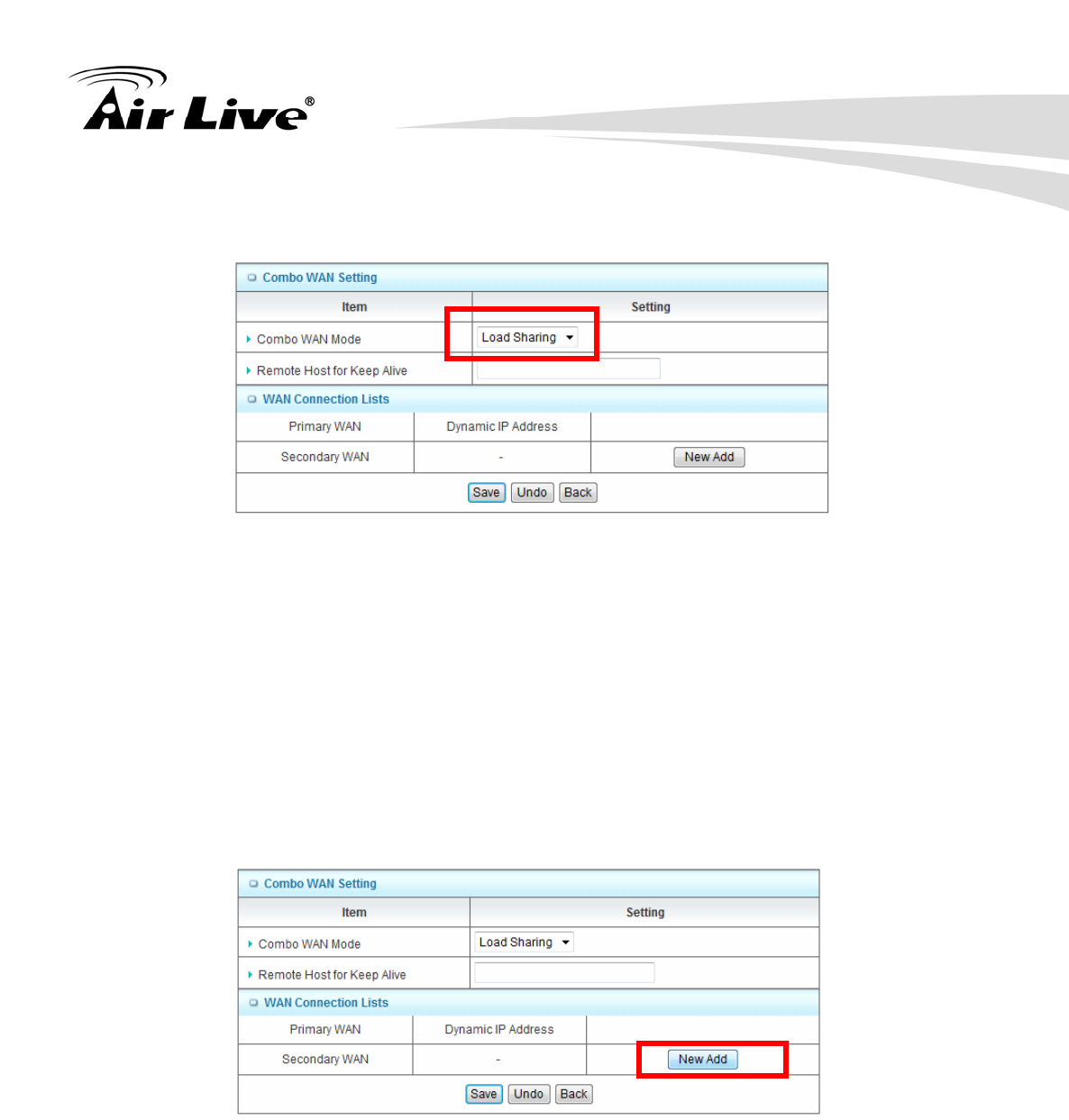
3. Configuration
AirLive N450R User’s Manual
40
(a) Load Sharing
The feature of Load Sharing will activate 3G WAN and Ethernet WAN simultaneously.
1. Combo WAN Mode
Choose Load Sharing mode.
2. Remote Host for Keep Alive
Type an IP address or domain name of remote host to detect if Internet connection is
alive.
3. Primary WAN
The primary WAN is the WAN type you set at Internet Setup page.
4. Secondary WAN
Press “New Add” button to add the secondary WAN. If the primary WAN is 3G or
iBurst, then you can choose one of Static IP, Dynamic IP, and PPPoE as the secondary
WAN. However, 3G can be the secondary WAN if primary WAN is Static IP, Dynamic IP,
or PPPoE.
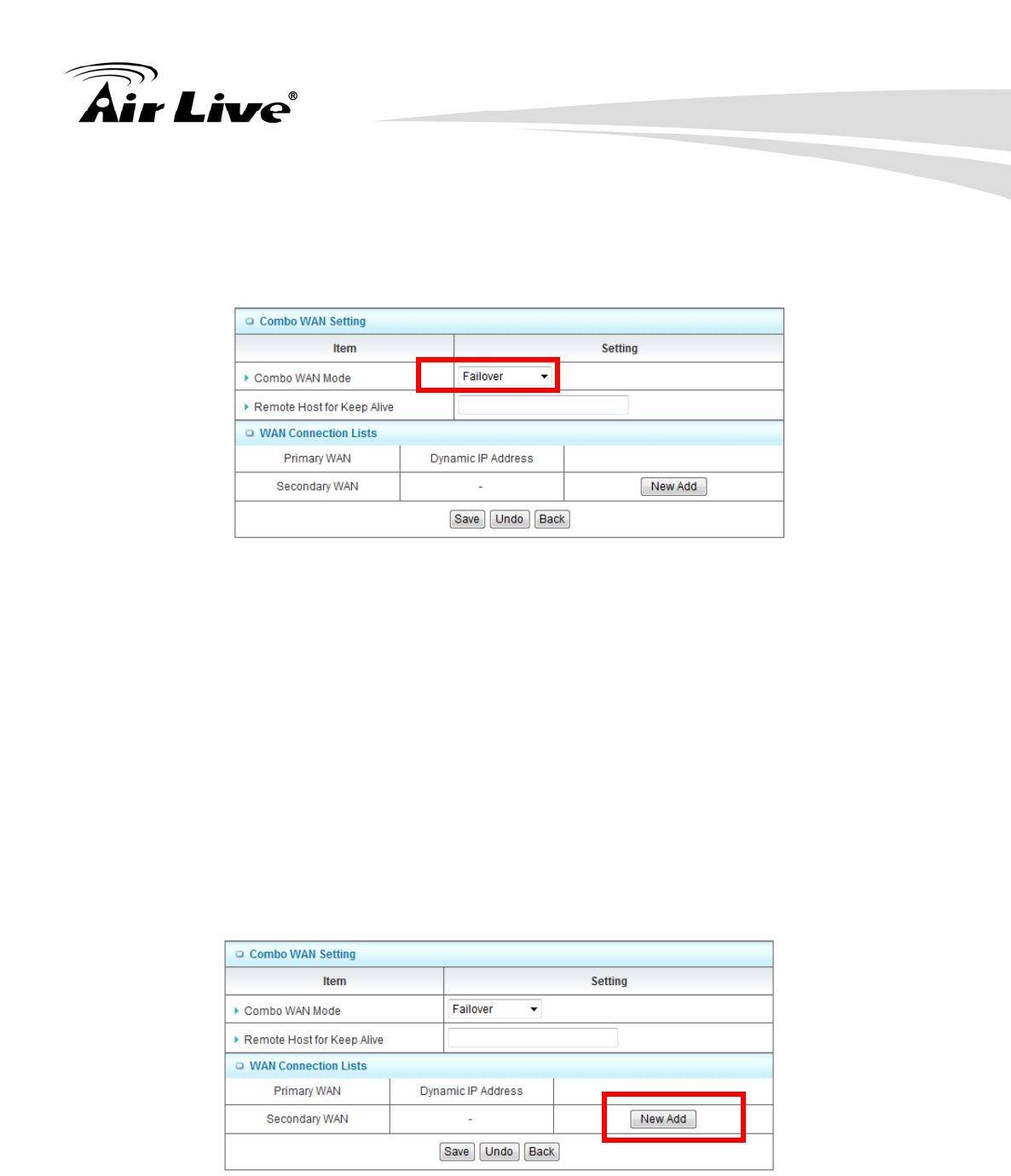
3. Configuration
AirLive N450R User’s Manual
41
(b) Failover
With this function enabled, when the primary WAN connection is broken, the device will
automatically switch to secondary WAN connection and keep you connected to Internet.
Meanwhile, if the device detects that the primary WAN connection is recovered, your
Internet connection will be switched from secondary WAN back to primary WAN.
1. Combo WAN Mode
Choose Failover mode.
2. Remote Host for Keep Alive
Type an IP address or domain name of remote host to detect if Internet connection is
alive.
3. Primary WAN
The primary WAN is the WAN type you set at Internet Setup page.
4. Secondary WAN
Press “New Add” button to add the secondary WAN. If the primary WAN is 3G or
iBurst, then you can choose one of Static IP, Dynamic IP, and PPPoE as the secondary
WAN. However, 3G can be the secondary WAN if primary WAN is Static IP, Dynamic IP,
or PPPoE.
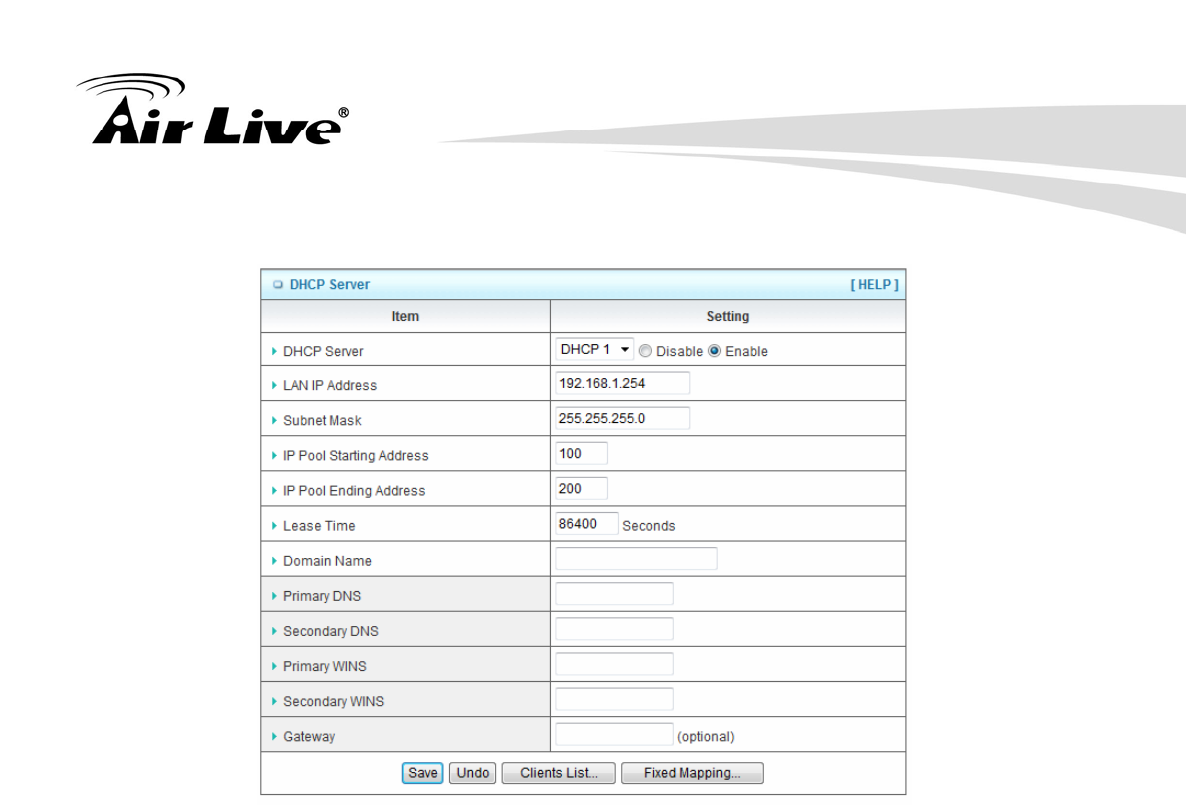
3. Configuration
AirLive N450R User’s Manual
42
3.2.2 DHCP Server
1. DHCP Server
You can have total four (DHCP1~DHCP4) different settings of DHCP server
configurations on this device. If you divide LAN network into different groups via
VLAN ID (Please refer to Advanced Setting->VLAN for detail), you can have
different DHCP server settings for each of them.
2. IP Pool Starting/Ending Address
Whenever there is a request, the DHCP server will automatically allocate an unused
IP address from the IP address pool to the requesting computer. You must specify the
starting / ending address of the IP address pool.
3. Lease Time
DHCP lease time to the DHCP client.
4. Domain Name
Optional, this information will be passed to the clients.
5. Primary DNS/Secondary DNS
Optional. This feature allows you to assign a DNS Servers
6. Primary WINS/Secondary WINS
Optional. This feature allows you to assign a WINS Servers
7. Gateway
Optional. Gateway Address would be the IP address of an alternate Gateway. This
function enables you to assign another gateway to your PC, when DHCP server
offers an IP to your PC.
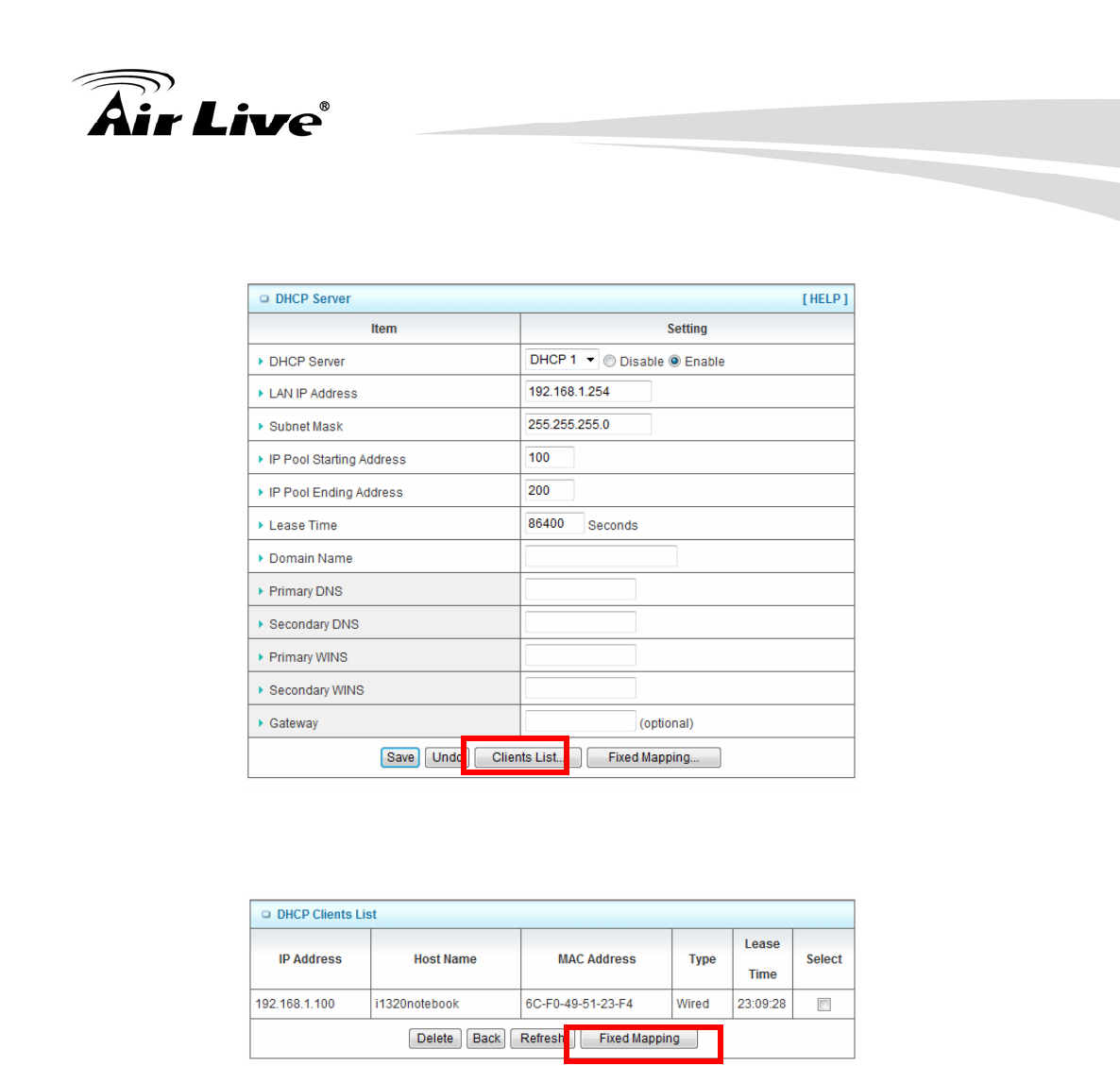
3. Configuration
AirLive N450R User’s Manual
43
Click on “Save” to store your settings or click “Undo” to give up the changes.
Press “Clients List” and the list of DHCP clients will be shown consequently.
Press “Fixed Mapping” and the DHCP Server will reserve the special IP for designated
MAC Address.
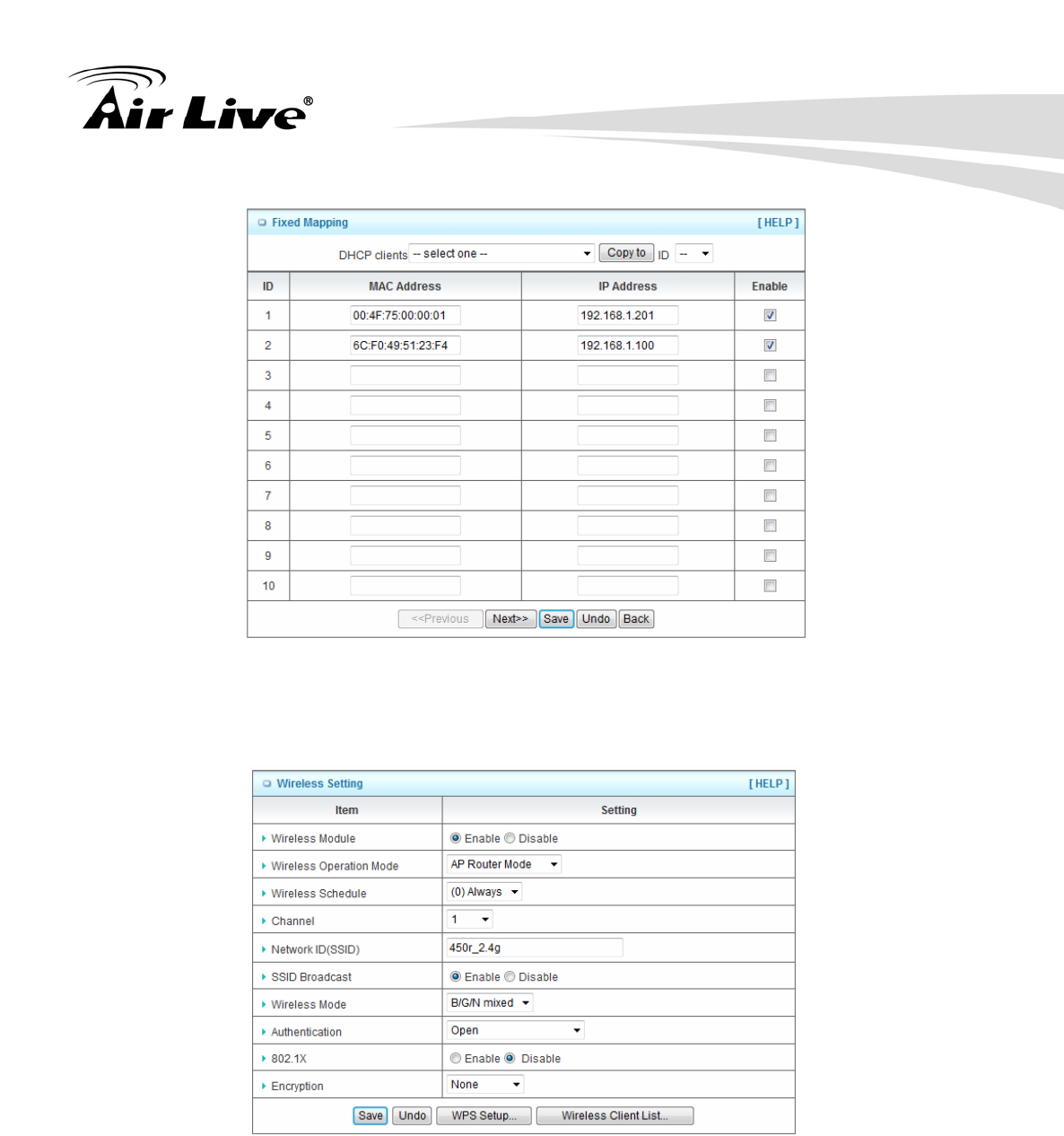
3. Configuration
AirLive N450R User’s Manual
44
3.2.3 Wireless 2.4G Settings
Here you can configure settings for 2.4GHz wireless functions.
Wireless settings allow you to set the wireless configuration items.
1. Wireless Module
You can enable or disable wireless function.
2. Wireless Operation Mode
You can select the wireless operation mode such as AP Router, AP Only, and WDS
Hybrid and WDS Only..etc.

3. Configuration
AirLive N450R User’s Manual
45
3. Wireless Schedule
You can limit Wi-Fi functions in a period of time if required.
4. Channel
The radio channel number. The permissible channels depend on the Regulatory
Domain. The factory default setting is as follow: channel 1~11 for North America.
(Channel 1~13 for European (ETSI); channel1~ 14 for Japan).
5. Network ID (SSID)
Network ID is used for identifying the Wireless LAN (WLAN). Client stations can roam
freely over this device and other Access Points that have the same Network ID. (The
factory default setting is “airlive2.4g”)
6. SSID Broadcast
The router will broadcast beacons that have some information, including SSID so that
wireless clients can know how many AP devices by scanning the network. Therefore, if
this setting is configured as “Disable”, the wireless clients cannot find the device from
beacons.
7. Wireless Mode
Choose “B/G mixed”, “B only”, “G only”, “N only”, “G/N mixed” or “B/G/N mixed”.
The factory default setting is “B/G/N mixed”.
8. Authentication
You may select one of authentication to secure your wireless network: Open, Shared,
Auto, WPA-PSK, WPA, WPA2-PSK, WPA2, WPA-PSK/WPA2-PSK, or WPA /WPA2.
(A) Open
Open system authentication simply consists of two communications. The first is an
authentication request by the client that contains the station ID (typically the MAC
address). This is followed by an authentication response from the AP/router containing a
success or failure message. An example of when a failure may occur is if the client's MAC
address is explicitly excluded in the AP/router configuration.
(B) Shared
Shared key authentication relies on the fact that both stations taking part in the
authentication process have the same "shared" key or passphrase. The shared key is
manually set on both the client station and the AP/router. Three types of shared key
authentication are available today for home or small office WLAN environments.
(C) Auto
The AP will Select the Open or Shared by the client’s request automatically.
(D) WPA-PSK
Select Encryption and Pre-share Key Mode, if you select HEX, you have to fill in 64
hexadecimal (0, 1, 2…8, 9, A, B…F) digits. If you select ASCII, the length of pre-share key
is from 8 to 63. Fill in the key (e.g. 12345678)
(E) WPA
Check Box was used to switch the function of the WPA. When the WPA function is
enabled, the Wireless user must authenticate to this router first to use the Network
service. RADIUS Server IP address or the 802.1X server’s domain-name. Select
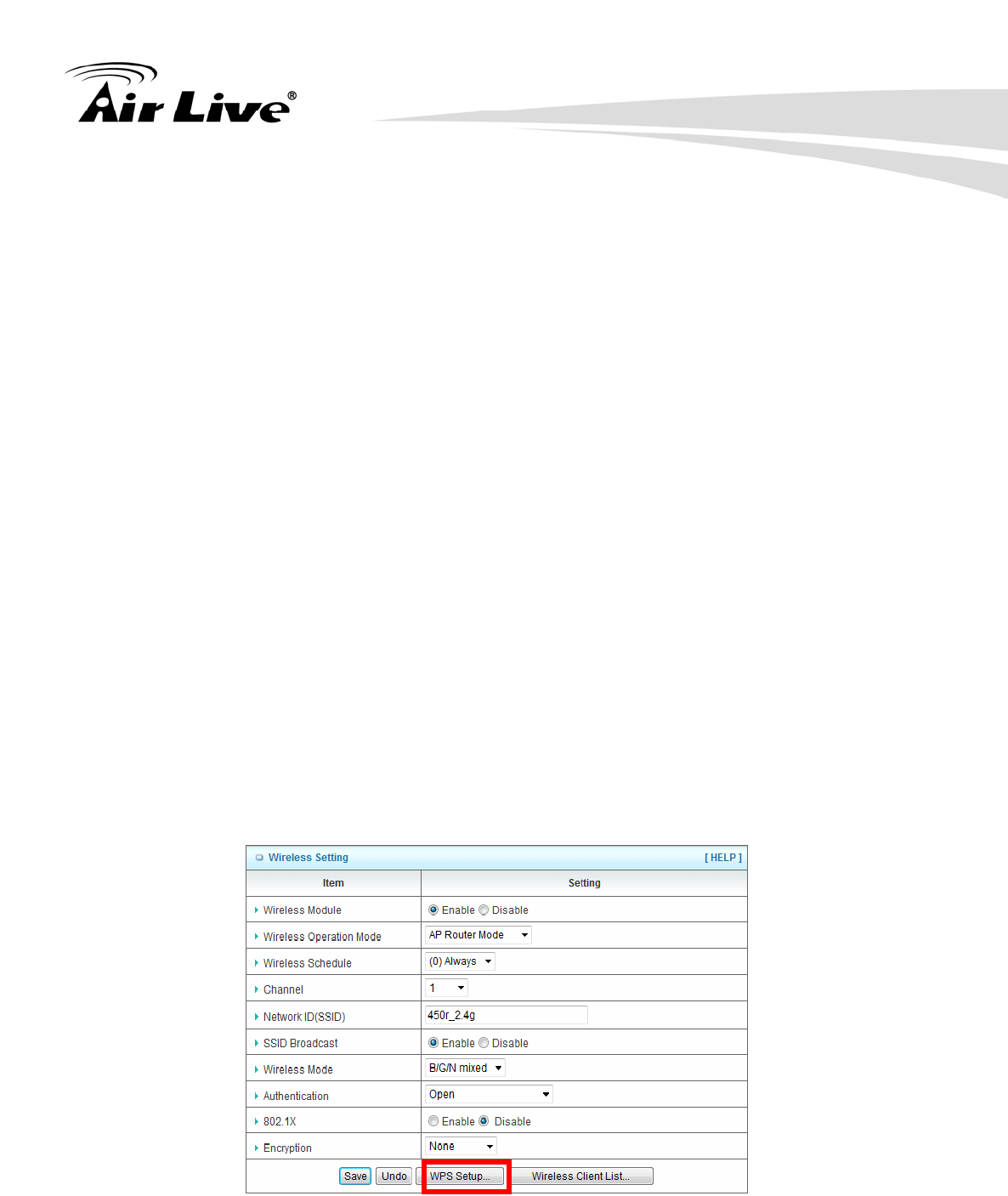
3. Configuration
AirLive N450R User’s Manual
46
Encryption and RADIUS Shared Key.
If you select HEX, you have to fill in 64 hexadecimal (0, 1, 2…8, 9, A, B…F) digits.
If you select ASCII, the length of pre-share key is from 8 to 63.Key value shared
by the RADIUS server and this router. This key value is consistent with the key
value in the RADIUS server.
(F) WPA-PSK2
WPA-PSK2 user AES and TKIP for Same the encryption, the others are same the
WPA-PSK.
(G) WPA2
WPA2 add uses AES and TKIP for encryption, the others are same the WPA.
(H) WPA-PSK/WPA-PSK2
Another encryption options for WPA-PSK-TKIP and WPA-PSK2-AES, the others are same
the WPA-PSK.
(I) WPA/WPA2
Another encryption options for WPA-TKIP and WPA2-AES, the others are same the
WPA.
1. 802.1X
You can enable or disable 802.X function.
2. Encryption
Select the appropriate category. Once you set up that type of encryption, second LAN
PC must enter the same encryption type as the first one.
By pressing “WPS Setup”, you can configure and enable the easy setup feature WPS
(Wi-Fi Protection Setup) for your wireless network.
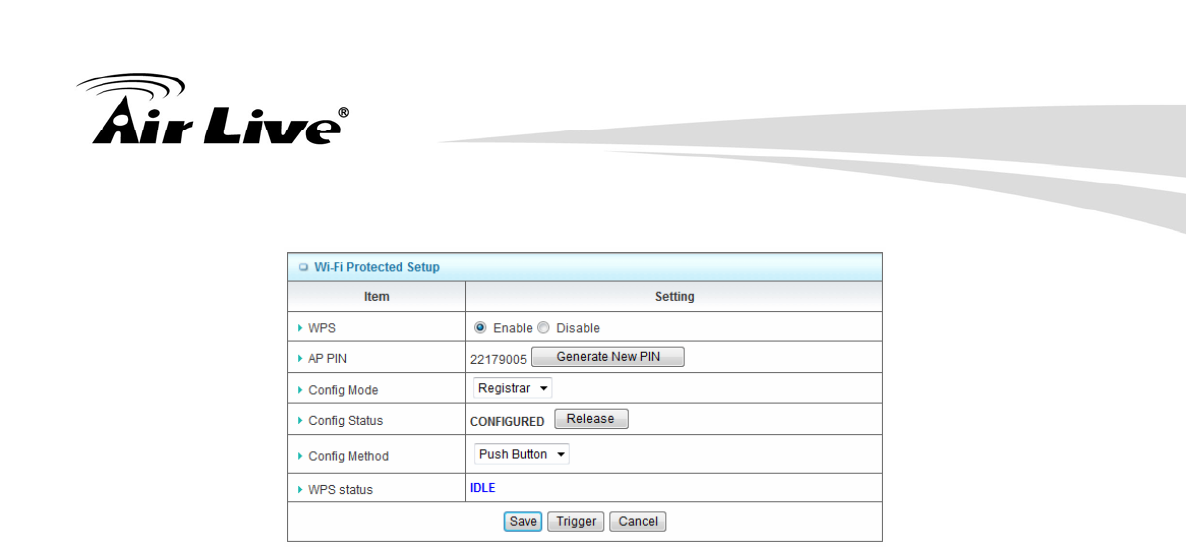
3. Configuration
AirLive N450R User’s Manual
47
1. WPS
You can enable this function by selecting “Enable”. WPS offers a safe and easy way to
allow the wireless clients connected to your wireless network.
2. AP PIN
You can press Generate New Pin to get an AP PIN.
3. Config Mode
Select your config Mode from “Registrar” or “Enrollee”.
4. Config Status
It shows the status of your configuration.
5. Config Method
You can select the Config Method here from “Pin Code” or “Push Button”.
6. WPS status
According to your setting, the status will show “Start Process” or “No Used”.
By pressing “WDS Hybrid Mode” and “WDS Only Mode”, you can connect this device
to another AP via WDS connection.
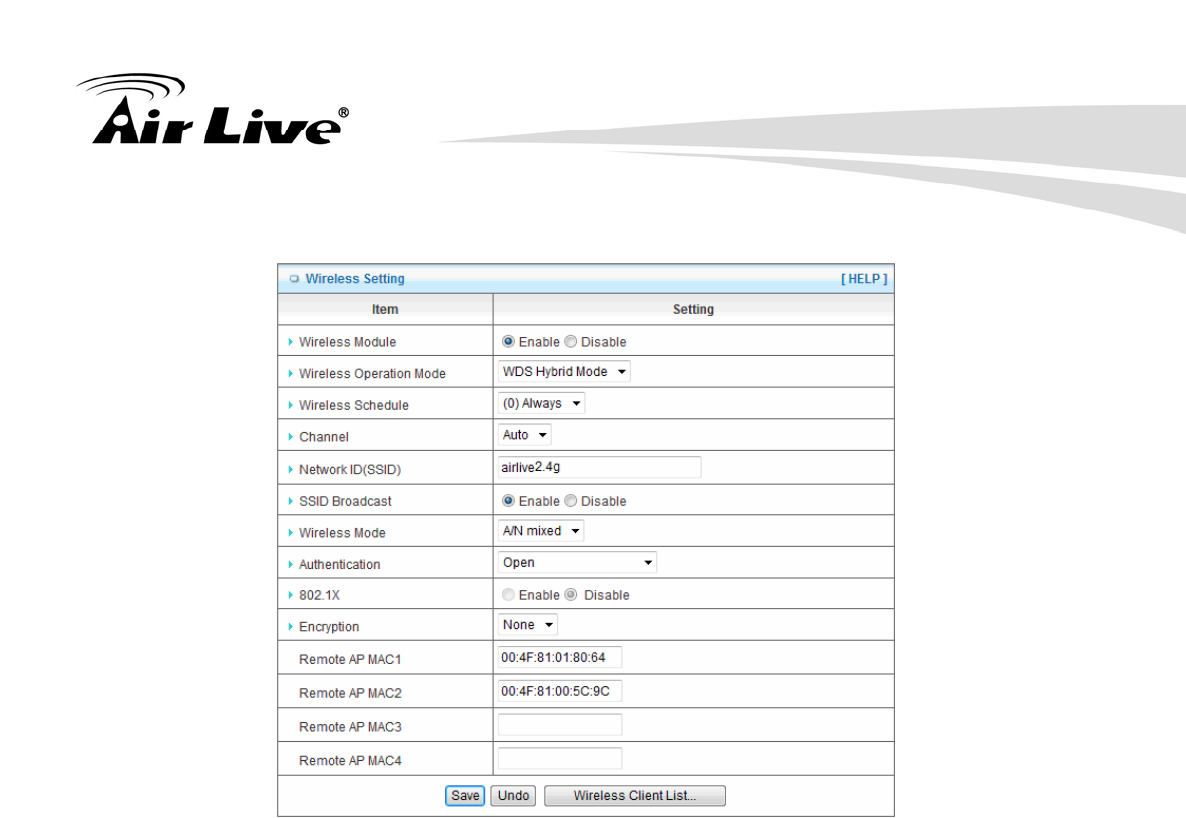
3. Configuration
AirLive N450R User’s Manual
48
WDS Hybrid Mode
1. Wireless Operation Mode W
Choose WDS Hybrid mode.
2. Wireless Schedule
You can limit Wi-Fi functions in a period of time if required.
3. Channel
The radio channel number. The permissible channels depend on the Regulatory
Domain. The factory default setting is as follow: channel 1~11 for North America.
(Channel 1~13 for European (ETSI); channel1~ 14 for Japan).
4. Network ID (SSID)
Network ID is used for identifying the Wireless LAN (WLAN). Client stations can roam
freely over this device and other Access Points that have the same Network ID. (The
factory default setting is “airlive2.4g”)
5. SSID Broadcast
The router will broadcast beacons that have some information, including SSID so that
wireless clients can know how many AP devices by scanning the network. Therefore, if
this setting is configured as “Disable”, the wireless clients cannot find the device from
beacons.
6. Wireless Mode
Choose “B/G mixed”, “B only”, “G only”, “N only”, “G/N mixed” or “B/G/N mixed”.
The factory default setting is “B/G/N mixed”.

3. Configuration
AirLive N450R User’s Manual
49
7. Authentication
You may select one of authentication to secure your wireless network: Open, Shared,
Auto, WPA-PSK, WPA, WPA2-PSK, WPA2, WPA-PSK/WPA2-PSK, or WPA /WPA2.
(A) Open
Open system authentication simply consists of two communications. The first is an
authentication request by the client that contains the station ID (typically the MAC
address). This is followed by an authentication response from the AP/router containing a
success or failure message. An example of when a failure may occur is if the client's MAC
address is explicitly excluded in the AP/router configuration.
(B) Shared
Shared key authentication relies on the fact that both stations taking part in the
authentication process have the same "shared" key or passphrase. The shared key is
manually set on both the client station and the AP/router. Three types of shared key
authentication are available today for home or small office WLAN environments.
(C) Auto
The AP will Select the Open or Shared by the client’s request automatically.
(D) WPA-PSK
Select Encryption and Pre-share Key Mode, if you select HEX, you have to fill in 64
hexadecimal (0, 1, 2…8, 9, A, B…F) digits. If you select ASCII, the length of pre-share key
is from 8 to 63. Fill in the key (e.g. 12345678)
(E) WPA
Check Box was used to switch the function of the WPA. When the WPA function is
enabled, the Wireless user must authenticate to this router first to use the Network
service. RADIUS Server IP address or the 802.1X server’s domain-name. Select
Encryption and RADIUS Shared Key.
If you select HEX, you have to fill in 64 hexadecimal (0, 1, 2…8, 9, A, B…F) digits.
If you select ASCII, the length of pre-share key is from 8 to 63.Key value shared
by the RADIUS server and this router. This key value is consistent with the key
value in the RADIUS server.
(F) WPA-PSK2
WPA-PSK2 user AES and TKIP for Same the encryption, the others are same the
WPA-PSK.
(G) WPA2
WPA2 add uses AES and TKIP for encryption, the others are same the WPA.
(H) WPA-PSK/WPA-PSK2
Another encryption options for WPA-PSK-TKIP and WPA-PSK2-AES, the others are same
the WPA-PSK.
(I) WPA/WPA2
Another encryption options for WPA-TKIP and WPA2-AES, the others are same the
WPA.
8. Encryption
Select the appropriate category. Once you set up that type of encryption, second LAN
PC must enter the same encryption type as the first one.
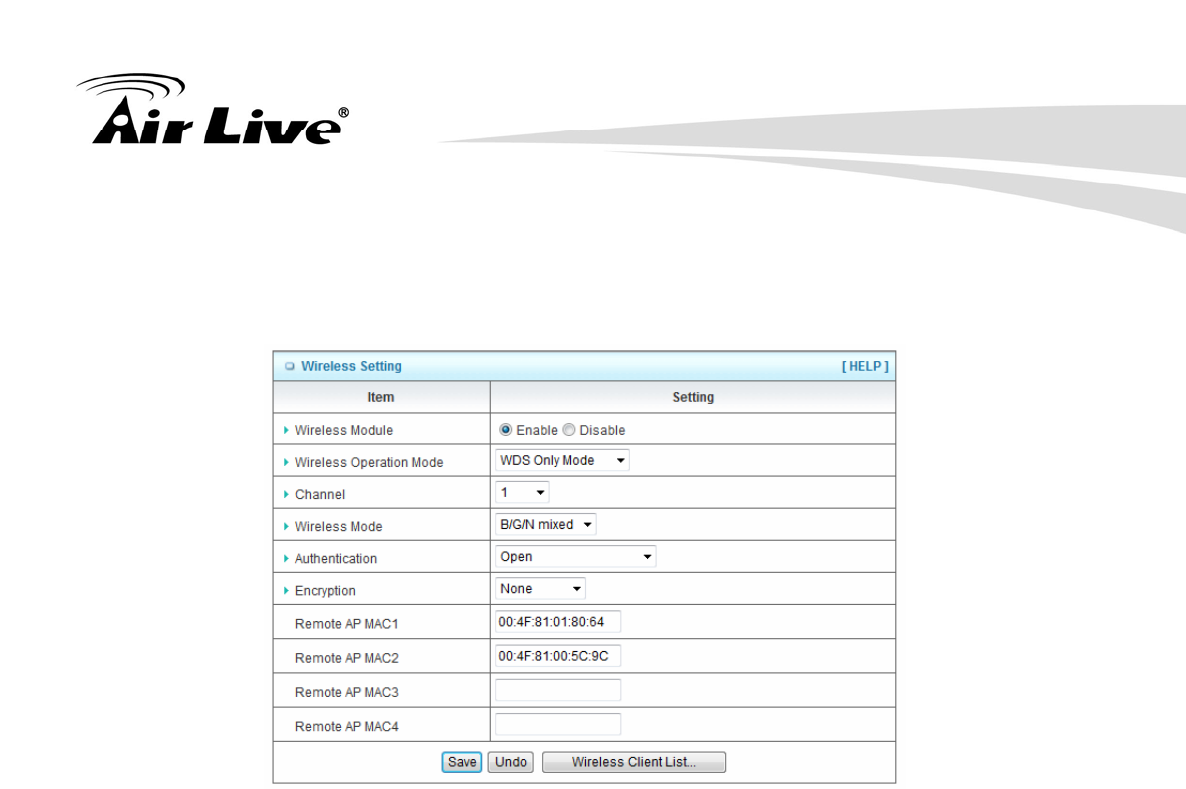
3. Configuration
AirLive N450R User’s Manual
50
9. Remote AP MAC 1~4
Enter the MAC address for remote AP that you want to connect via WDS.
WDS Only Mode
1. Wireless Operation Mode W
Choose WDS Only mode.
2. Wireless Schedule
You can limit Wi-Fi functions in a period of time if required.
3. Channel
The radio channel number. The permissible channels depend on the Regulatory
Domain. The factory default setting is as follow: channel 1~11 for North America.
(Channel 1~13 for European (ETSI); channel1~ 14 for Japan).
4. Wireless Mode
Choose “B/G mixed”, “B only”, “G only”, “N only”, “G/N mixed” or “B/G/N mixed”.
The factory default setting is “B/G/N mixed”.
5. Authentication
You may select one of authentication to secure your wireless network: Open, Shared,
Auto, WPA-PSK, WPA, WPA2-PSK, WPA2, WPA-PSK/WPA2-PSK, or WPA /WPA2.
(A) Open
Open system authentication simply consists of two communications. The first is an
authentication request by the client that contains the station ID (typically the MAC
address). This is followed by an authentication response from the AP/router containing a
success or failure message. An example of when a failure may occur is if the client's MAC
address is explicitly excluded in the AP/router configuration.
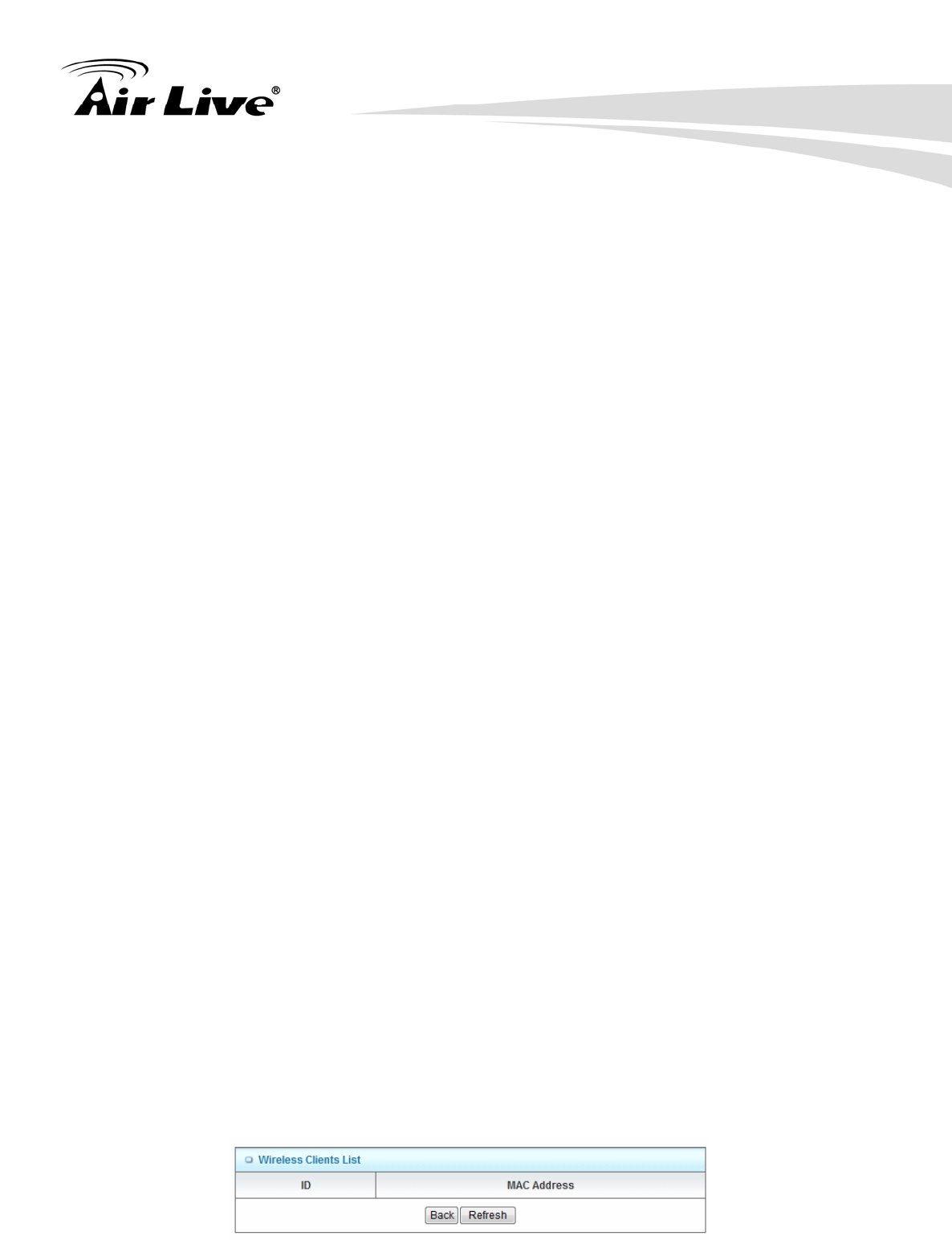
3. Configuration
AirLive N450R User’s Manual
51
(B) Shared
Shared key authentication relies on the fact that both stations taking part in the
authentication process have the same "shared" key or passphrase. The shared key is
manually set on both the client station and the AP/router. Three types of shared key
authentication are available today for home or small office WLAN environments.
(C) Auto
The AP will Select the Open or Shared by the client’s request automatically.
(D) WPA-PSK
Select Encryption and Pre-share Key Mode, if you select HEX, you have to fill in 64
hexadecimal (0, 1, 2…8, 9, A, B…F) digits. If you select ASCII, the length of pre-share key
is from 8 to 63. Fill in the key (e.g. 12345678)
(E) WPA
Check Box was used to switch the function of the WPA. When the WPA function is
enabled, the Wireless user must authenticate to this router first to use the Network
service. RADIUS Server IP address or the 802.1X server’s domain-name. Select
Encryption and RADIUS Shared Key.
If you select HEX, you have to fill in 64 hexadecimal (0, 1, 2…8, 9, A, B…F) digits.
If you select ASCII, the length of pre-share key is from 8 to 63.Key value shared
by the RADIUS server and this router. This key value is consistent with the key
value in the RADIUS server.
(F) WPA-PSK2
WPA-PSK2 user AES and TKIP for Same the encryption, the others are same the
WPA-PSK.
(G) WPA2
WPA2 add uses AES and TKIP for encryption, the others are same the WPA.
(H) WPA-PSK/WPA-PSK2
Another encryption options for WPA-PSK-TKIP and WPA-PSK2-AES, the others are same
the WPA-PSK.
(I) WPA/WPA2
Another encryption options for WPA-TKIP and WPA2-AES, the others are same the
WPA.
6. Encryption
Select the appropriate category. Once you set up that type of encryption, second LAN
PC must enter the same encryption type as the first one.
7. Remote AP MAC 1~4
Enter the MAC address for remote AP that you want to connect via WDS.
Press “Wireless Clients List” and the list of wireless clients will be shown consequently.
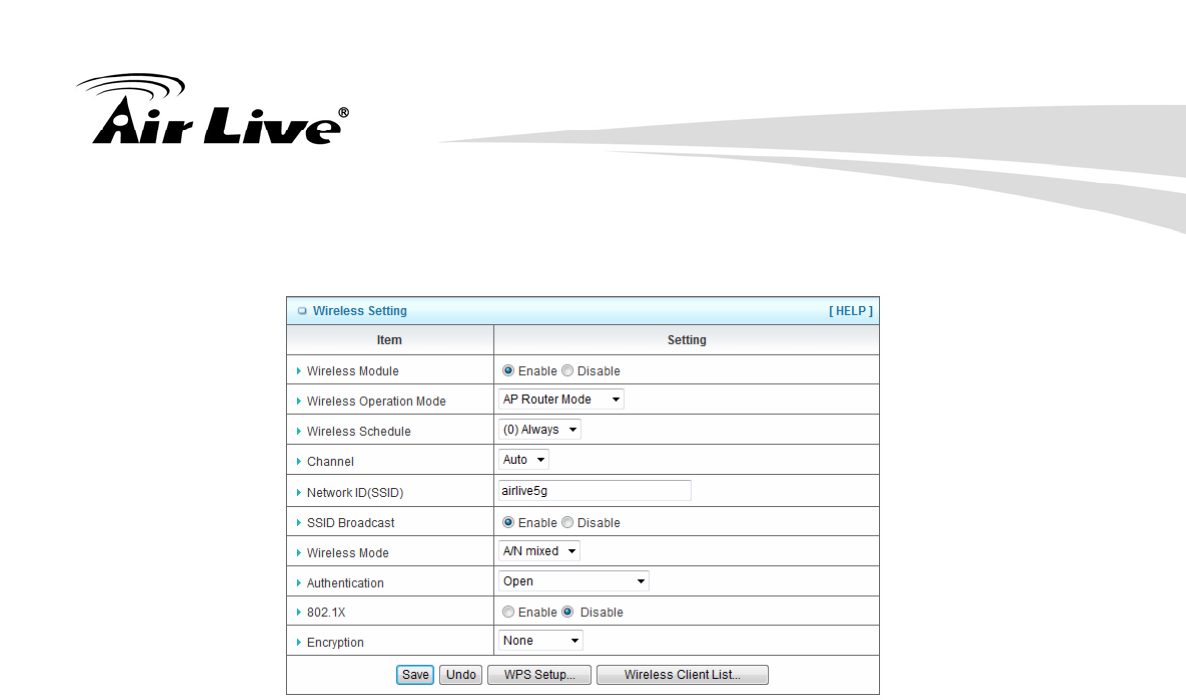
3. Configuration
AirLive N450R User’s Manual
52
3.2.4 Wireless 5G Settings
Here you can configure settings for 5GHz wireless functions.
Wireless settings allow you to set the wireless configuration items.
1. Wireless Module
You can enable or disable wireless function.
2. Wireless Operation Mode
You can select the wireless operation mode such as AP Router, AP Only, and WDS
Hybrid and WDS Only ..etc.
3. Wireless Schedule
You can limit Wi-Fi functions in a period of time if required.
4. Channel
The radio channel number. The permissible channels depend on the Regulatory
Domain.
5. Network ID (SSID)
Network ID is used for identifying the Wireless LAN (WLAN). Client stations can roam
freely over this device and other Access Points that have the same Network ID. (The
factory default setting is “airlive5g”)
6. SSID Broadcast
The router will broadcast beacons that have some information, including SSID so that
wireless clients can know how many AP devices by scanning the network. Therefore, if
this setting is configured as “Disable”, the wireless clients can not find the device from
beacons.
7. Wireless Mode
Choose “A/N mixed”, “A only”, “N only”. The factory default setting is “A/N mixed”.
8. Authentication
You may select one of authentication to secure your wireless network: Open Shared,
Auto, WPA-PSK, WPA, WPA2-PSK, WPA2, WPA-PSK/WPA2-PSK, or WPA /WPA2.

3. Configuration
AirLive N450R User’s Manual
53
(A) Open
Open system authentication simply consists of two communications. The first is an
authentication request by the client that contains the station ID (typically the MAC
address). This is followed by an authentication response from the AP/router containing a
success or failure message. An example of when a failure may occur is if the client's MAC
address is explicitly excluded in the AP/router configuration.
(B) Shared
Shared key authentication relies on the fact that both stations taking part in the
authentication process have the same "shared" key or passphrase. The shared key is
manually set on both the client station and the AP/router. Three types of shared key
authentication are available today for home or small office WLAN environments.
(C) Auto
The AP will Select the Open or Shared by the client’s request automatically.
(D) WPA-PSK
Select Encryption and Pre-share Key Mode, if you select HEX, you have to fill in 64
hexadecimal (0, 1, 2…8, 9, A, B…F) digits. If you select ASCII, the length of pre-share key
is from 8 to 63. Fill in the key (e.g. 12345678)
(E) WPA
Check Box was used to switch the function of the WPA. When the WPA function is
enabled, the Wireless user must authenticate to this router first to use the Network
service. RADIUS Server IP address or the 802.1X server’s domain-name. Select
Encryption and RADIUS Shared Key.
If you select HEX, you have to fill in 64 hexadecimal (0, 1, 2…8, 9, A, B…F) digits.
If you select ASCII, the length of pre-share key is from 8 to 63.Key value shared
by the RADIUS server and this router. This key value is consistent with the key
value in the RADIUS server.
(F) WPA-PSK2
WPA-PSK2 user AES and TKIP for Same the encryption, the others are same the
WPA-PSK.
(G) WPA2
WPA2 add uses AES and TKIP for encryption, the others are same the WPA.
(H) WPA-PSK/WPA-PSK2
Another encryption options for WPA-PSK-TKIP and WPA-PSK2-AES, the others are same
the WPA-PSK.
(I) WPA/WPA2
Another encryption options for WPA-TKIP and WPA2-AES, the others are same the
WPA.
9. 802.1X
You can enable or disable 802.1X function.
10. Encryption type
Select the appropriate category. Once you set up that type of encryption, second LAN
PC must enter the same encryption type as the first one.
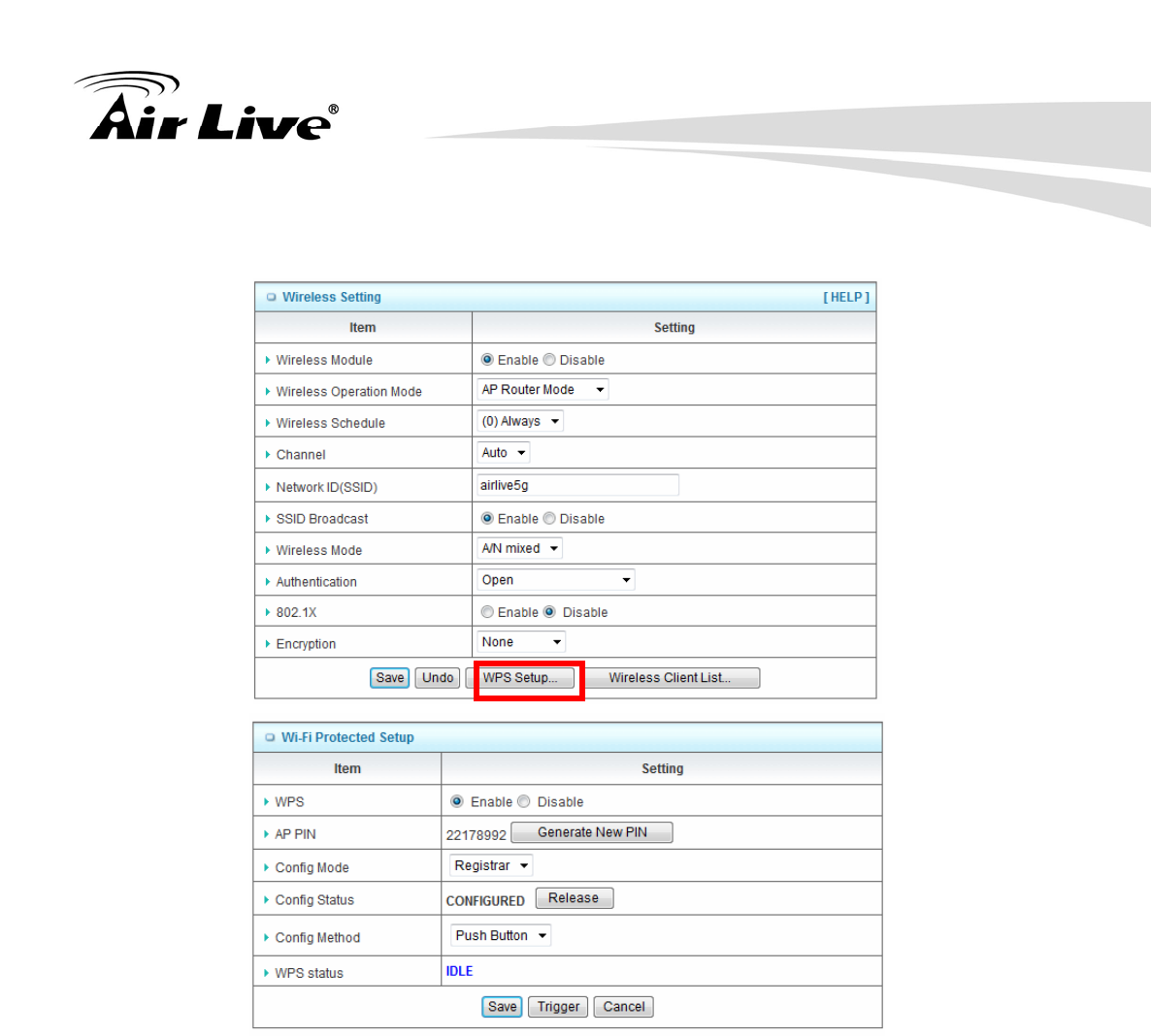
3. Configuration
AirLive N450R User’s Manual
54
By pressing “WPS Setup”, you can configure and enable the easy setup feature WPS
(Wi-Fi Protection Setup) for your wireless network.
1. WPS
You can enable this function by selecting “Enable”. WPS offers a safe and easy way to
allow the wireless clients connected to your wireless network.
2. AP PIN
You can press Generate New Pin to get an AP PIN.
3. Config Mode
Select your config Mode from “Registrar” or “Enrollee”.
4. Config Status
It shows the status of your configuration.
5. Config Method
You can select the Config Method here from “Pin Code” or “Push Button”.
6. WPS status
According to your setting, the status will show “Start Process” or “No used”.
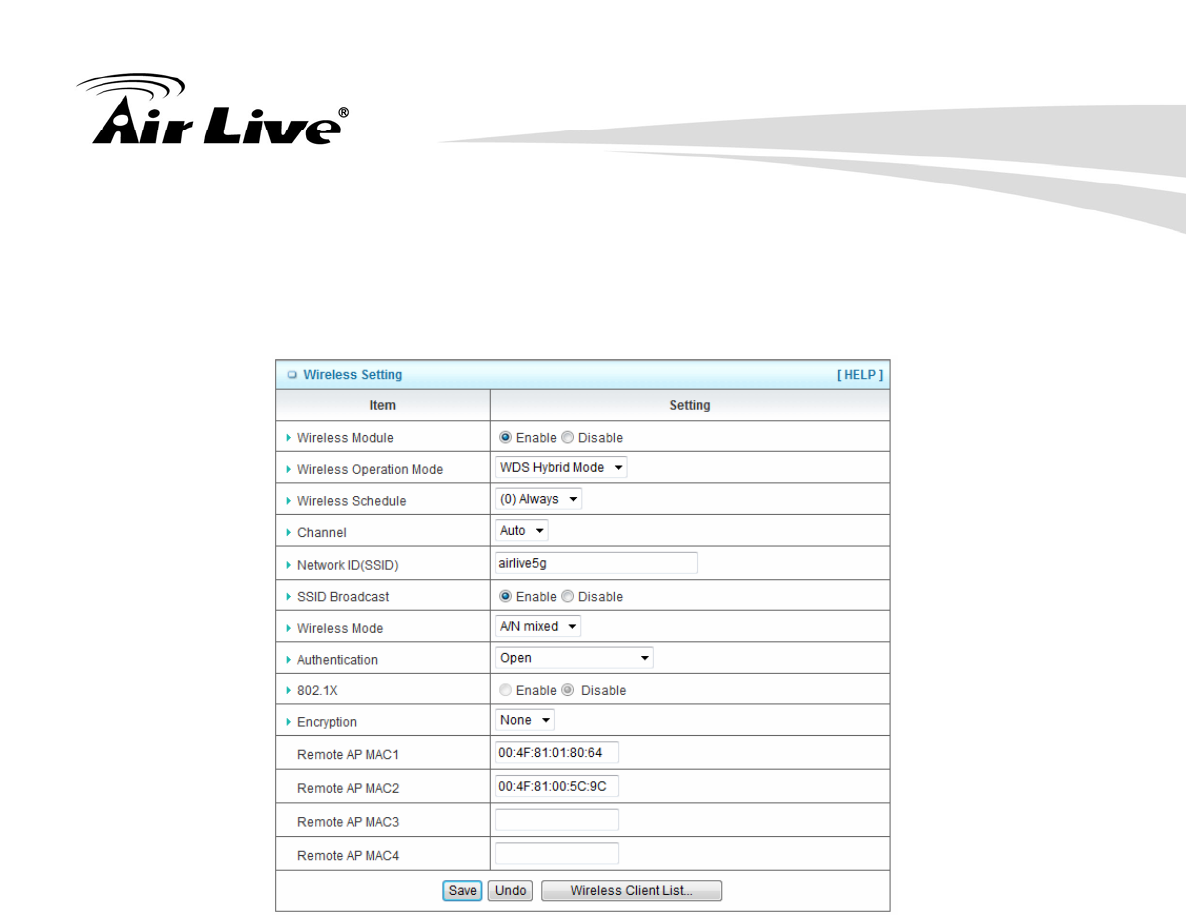
3. Configuration
AirLive N450R User’s Manual
55
By pressing “WDS Hybrid Mode” and “WDS Only Mode”, you can connect this device
to another AP via WDS connection.
WDS Hybrid Mode
1. Wireless Operation Mode W
Choose WDS Hybrid mode.
2. Wireless Schedule
You can limit Wi-Fi functions in a period of time if required.
3. Channel
The radio channel number. The permissible channels depend on the Regulatory
Domain. The factory default setting is as follow: channel 1~11 for North America.
(Channel 1~13 for European (ETSI); channel1~ 14 for Japan).
4. Network ID (SSID)
Network ID is used for identifying the Wireless LAN (WLAN). Client stations can roam
freely over this device and other Access Points that have the same Network ID. (The
factory default setting is “airlive2.4g”)
5. SSID Broadcast
The router will broadcast beacons that have some information, including SSID so that
wireless clients can know how many AP devices by scanning the network. Therefore, if
this setting is configured as “Disable”, the wireless clients cannot find the device from
beacons.

3. Configuration
AirLive N450R User’s Manual
56
6. Wireless Mode
Choose “B/G mixed”, “B only”, “G only”, “N only”, “G/N mixed” or “B/G/N mixed”.
The factory default setting is “B/G/N mixed”.
7. Authentication
You may select one of authentication to secure your wireless network: Open, Shared,
Auto, WPA-PSK, WPA, WPA2-PSK, WPA2, WPA-PSK/WPA2-PSK, or WPA /WPA2.
(A) Open
Open system authentication simply consists of two communications. The first is an
authentication request by the client that contains the station ID (typically the MAC
address). This is followed by an authentication response from the AP/router containing a
success or failure message. An example of when a failure may occur is if the client's MAC
address is explicitly excluded in the AP/router configuration.
(B) Shared
Shared key authentication relies on the fact that both stations taking part in the
authentication process have the same "shared" key or passphrase. The shared key is
manually set on both the client station and the AP/router. Three types of shared key
authentication are available today for home or small office WLAN environments.
(C) Auto
The AP will Select the Open or Shared by the client’s request automatically.
(D) WPA-PSK
Select Encryption and Pre-share Key Mode, if you select HEX, you have to fill in 64
hexadecimal (0, 1, 2…8, 9, A, B…F) digits. If you select ASCII, the length of pre-share key
is from 8 to 63. Fill in the key (e.g. 12345678)
(E) WPA
Check Box was used to switch the function of the WPA. When the WPA function is
enabled, the Wireless user must authenticate to this router first to use the Network
service. RADIUS Server IP address or the 802.1X server’s domain-name. Select
Encryption and RADIUS Shared Key.
If you select HEX, you have to fill in 64 hexadecimal (0, 1, 2…8, 9, A, B…F)
digits.
If you select ASCII, the length of pre-share key is from 8 to 63.Key value shared
by the RADIUS server and this router. This key value is consistent with the key
value in the RADIUS server.
(F) WPA-PSK2
WPA-PSK2 user AES and TKIP for Same the encryption, the others are same the
WPA-PSK.
(G) WPA2
WPA2 add uses AES and TKIP for encryption, the others are same the WPA.
(H) WPA-PSK/WPA-PSK2
Another encryption options for WPA-PSK-TKIP and WPA-PSK2-AES, the others are same
the WPA-PSK.
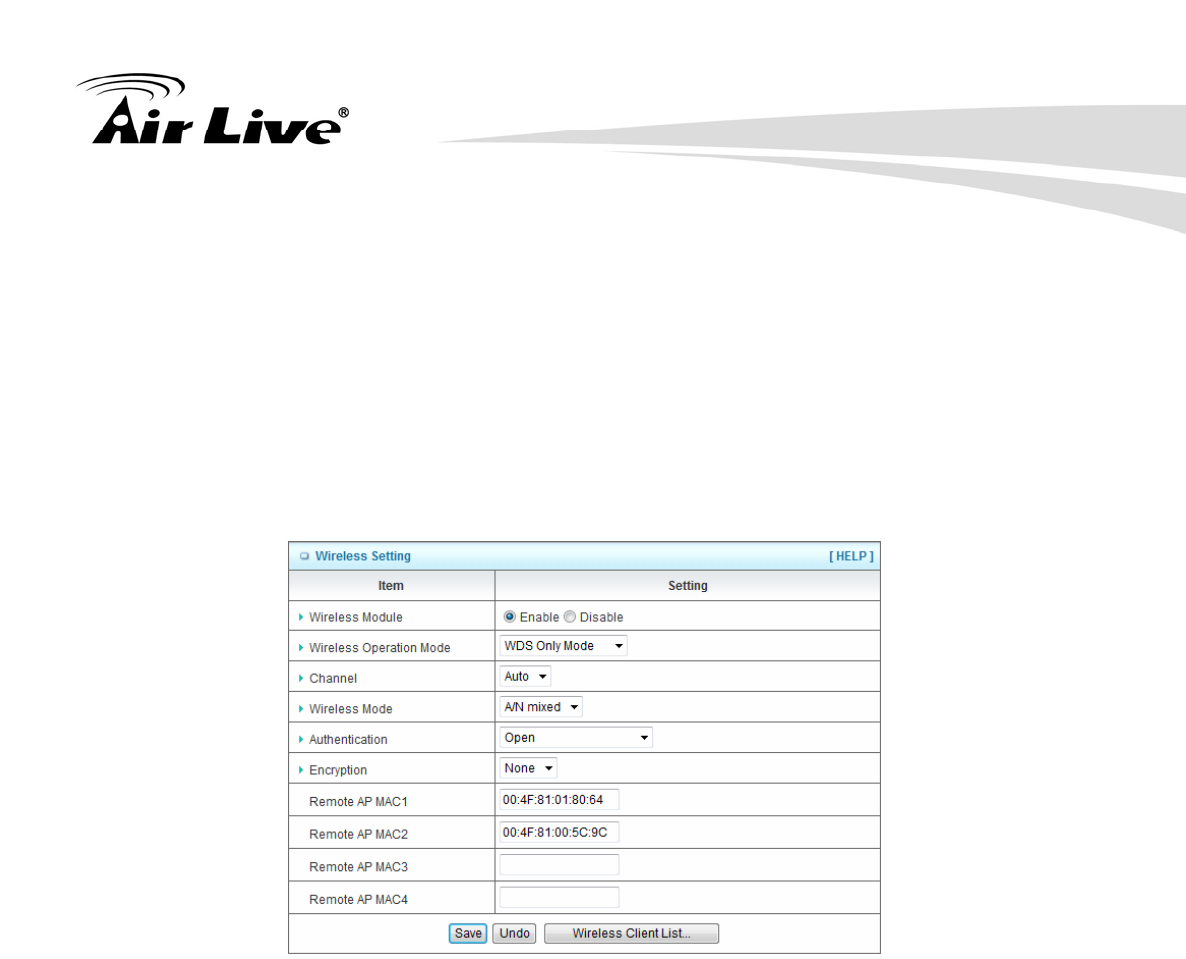
3. Configuration
AirLive N450R User’s Manual
57
(I) WPA/WPA2
Another encryption options for WPA-TKIP and WPA2-AES, the others are same the
WPA.
8. Encryption
Select the appropriate category. Once you set up that type of encryption, second LAN
PC must enter the same encryption type as the first one.
9. Remote AP MAC 1~4
Enter the MAC address for remote AP that you want to connect via WDS.
WDS Only Mode
1. Wireless Operation Mode W
Choose WDS Hybrid mode.
2. Wireless Schedule
You can limit Wi-Fi functions in a period of time if required.
3. Channel
The radio channel number. The permissible channels depend on the Regulatory
Domain. The factory default setting is as follow: channel 1~11 for North America.
(Channel 1~13 for European (ETSI); channel1~ 14 for Japan).
4. Wireless Mode
Choose “B/G mixed”, “B only”, “G only”, “N only”, “G/N mixed” or “B/G/N mixed”.
The factory default setting is “B/G/N mixed”.
5. Authentication
You may select one of authentication to secure your wireless network: Open, Shared,
Auto, WPA-PSK, WPA, WPA2-PSK, WPA2, WPA-PSK/WPA2-PSK, or WPA /WPA2.

3. Configuration
AirLive N450R User’s Manual
58
(A) Open
Open system authentication simply consists of two communications. The first is an
authentication request by the client that contains the station ID (typically the MAC
address). This is followed by an authentication response from the AP/router containing a
success or failure message. An example of when a failure may occur is if the client's MAC
address is explicitly excluded in the AP/router configuration.
(B) Shared
Shared key authentication relies on the fact that both stations taking part in the
authentication process have the same "shared" key or passphrase. The shared key is
manually set on both the client station and the AP/router. Three types of shared key
authentication are available today for home or small office WLAN environments.
(C) Auto
The AP will Select the Open or Shared by the client’s request automatically.
(D) WPA-PSK
Select Encryption and Pre-share Key Mode, if you select HEX, you have to fill in 64
hexadecimal (0, 1, 2…8, 9, A, B…F) digits. If you select ASCII, the length of pre-share key
is from 8 to 63. Fill in the key (e.g. 12345678)
(E) WPA
Check Box was used to switch the function of the WPA. When the WPA function is
enabled, the Wireless user must authenticate to this router first to use the Network
service. RADIUS Server IP address or the 802.1X server’s domain-name. Select
Encryption and RADIUS Shared Key.
If you select HEX, you have to fill in 64 hexadecimal (0, 1, 2…8, 9, A, B…F) digits.
If you select ASCII, the length of pre-share key is from 8 to 63.Key value shared
by the RADIUS server and this router. This key value is consistent with the key
value in the RADIUS server.
(F) WPA-PSK2
WPA-PSK2 user AES and TKIP for Same the encryption, the others are same the
WPA-PSK.
(G) WPA2
WPA2 add uses AES and TKIP for encryption, the others are same the WPA.
(H) WPA-PSK/WPA-PSK2
Another encryption options for WPA-PSK-TKIP and WPA-PSK2-AES, the others are same
the WPA-PSK.
(I) WPA/WPA2
Another encryption options for WPA-TKIP and WPA2-AES, the others are same the
WPA.
6. Encryption
Select the appropriate category. Once you set up that type of encryption, second LAN
PC must enter the same encryption type as the first one.
7. Remote AP MAC 1~4
Enter the MAC address for remote AP that you want to connect via WDS.
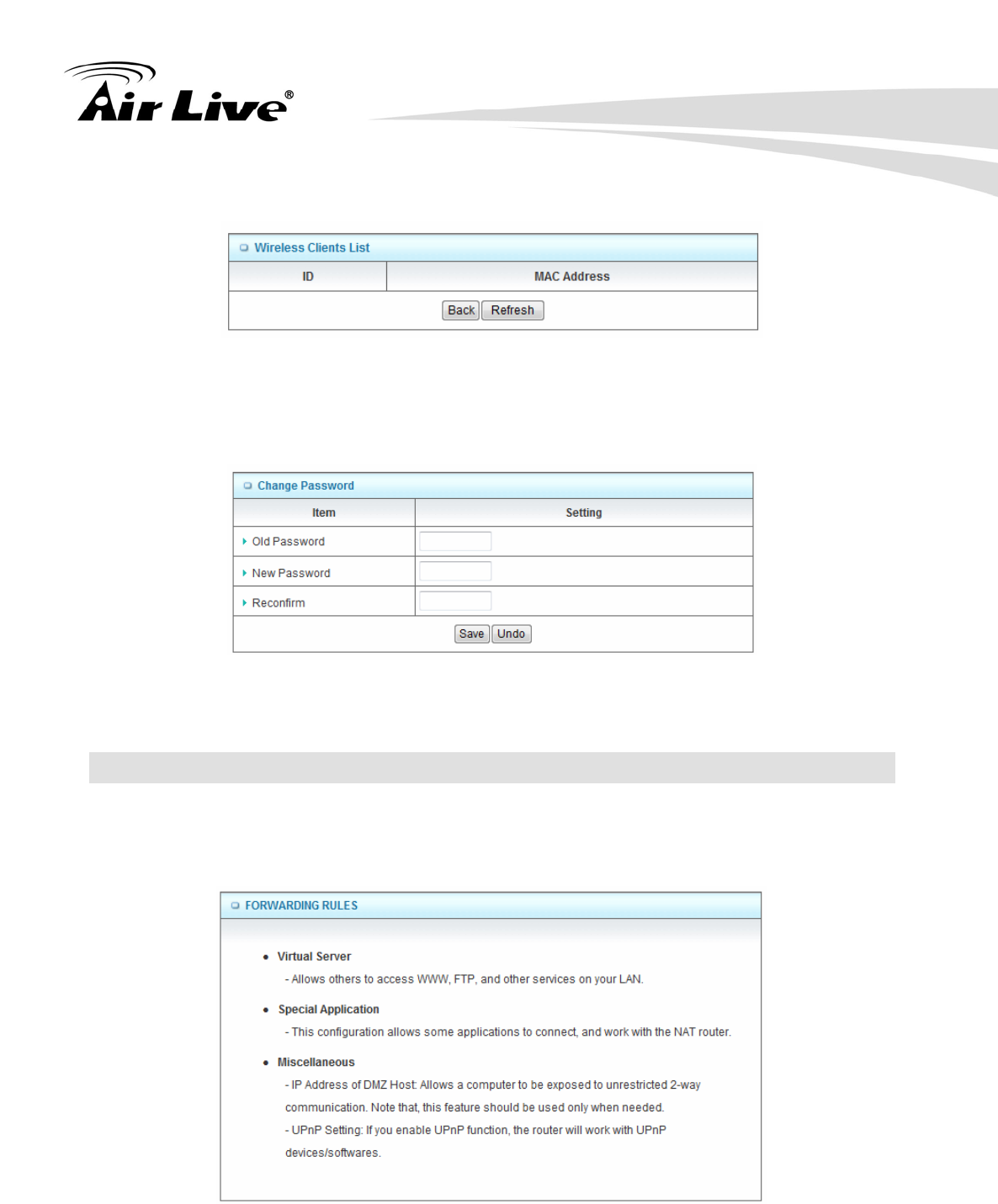
3. Configuration
AirLive N450R User’s Manual
59
Press “Wireless Clients List” and the list of wireless clients will be shown consequently.
3.2.5 Change Password
You can change the System Password here. We strongly recommend you to change the
system password for security reason.
Click on “Save” to store your settings or click “Undo” to give up the changes.
3.3 Forwarding Rules
There are three options: Virtual Server, Special Application and Miscellaneous.
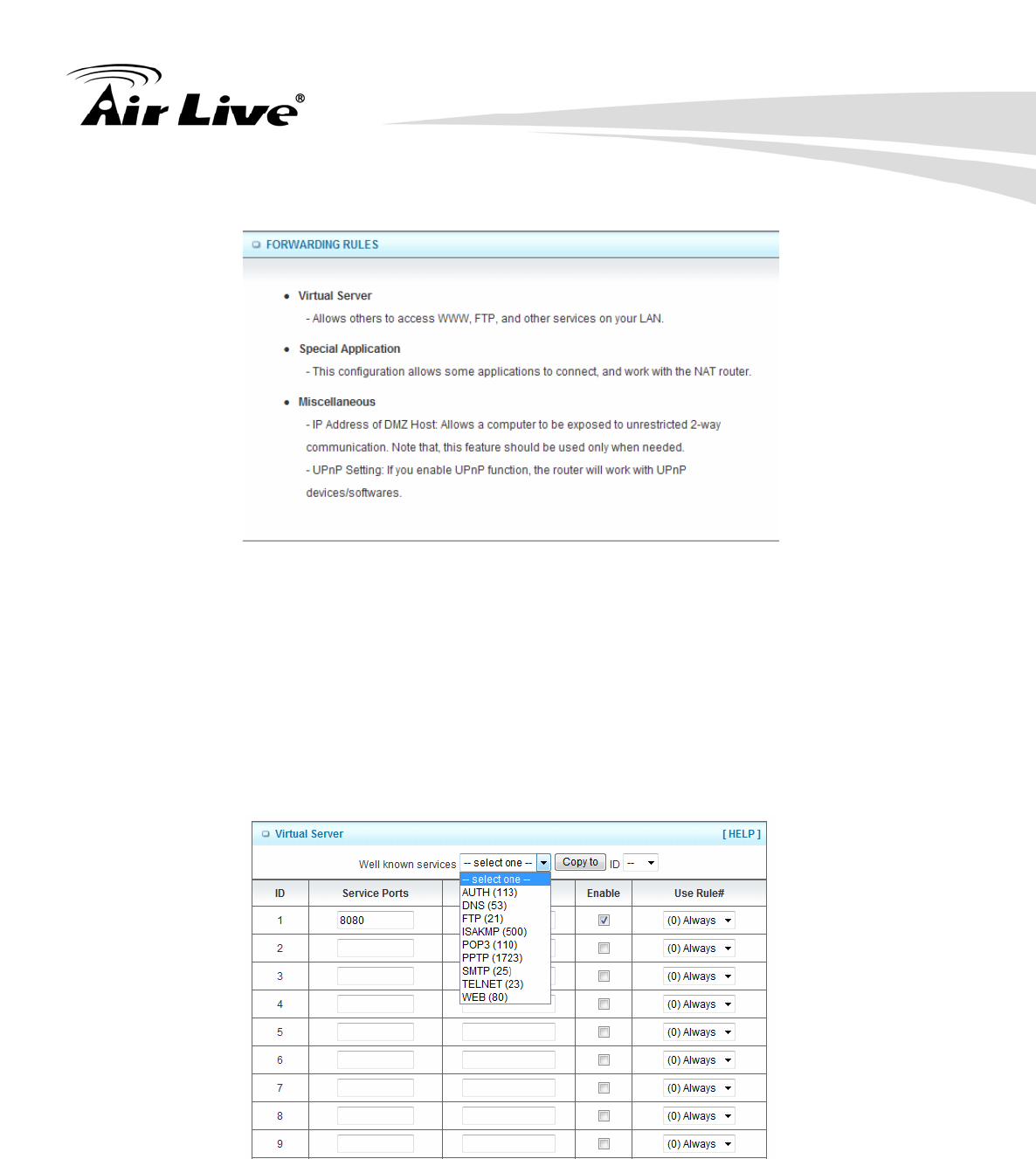
3. Configuration
AirLive N450R User’s Manual
60
3.3.1 Virtual Server
This product’s NAT firewall filters out unrecognized packets to protect your Intranet, so all
hosts behind this product are invisible to the outside world. If you wish, you can make
some of them accessible by enabling the Virtual Server Mapping.
A virtual server is defined as a Service Port, and all requests to this port will be redirected
to the computer specified by the Server IP. Virtual Server can work with Scheduling
Rules, and give user more flexibility on Access control. For the details, please refer to
Scheduling Rule.
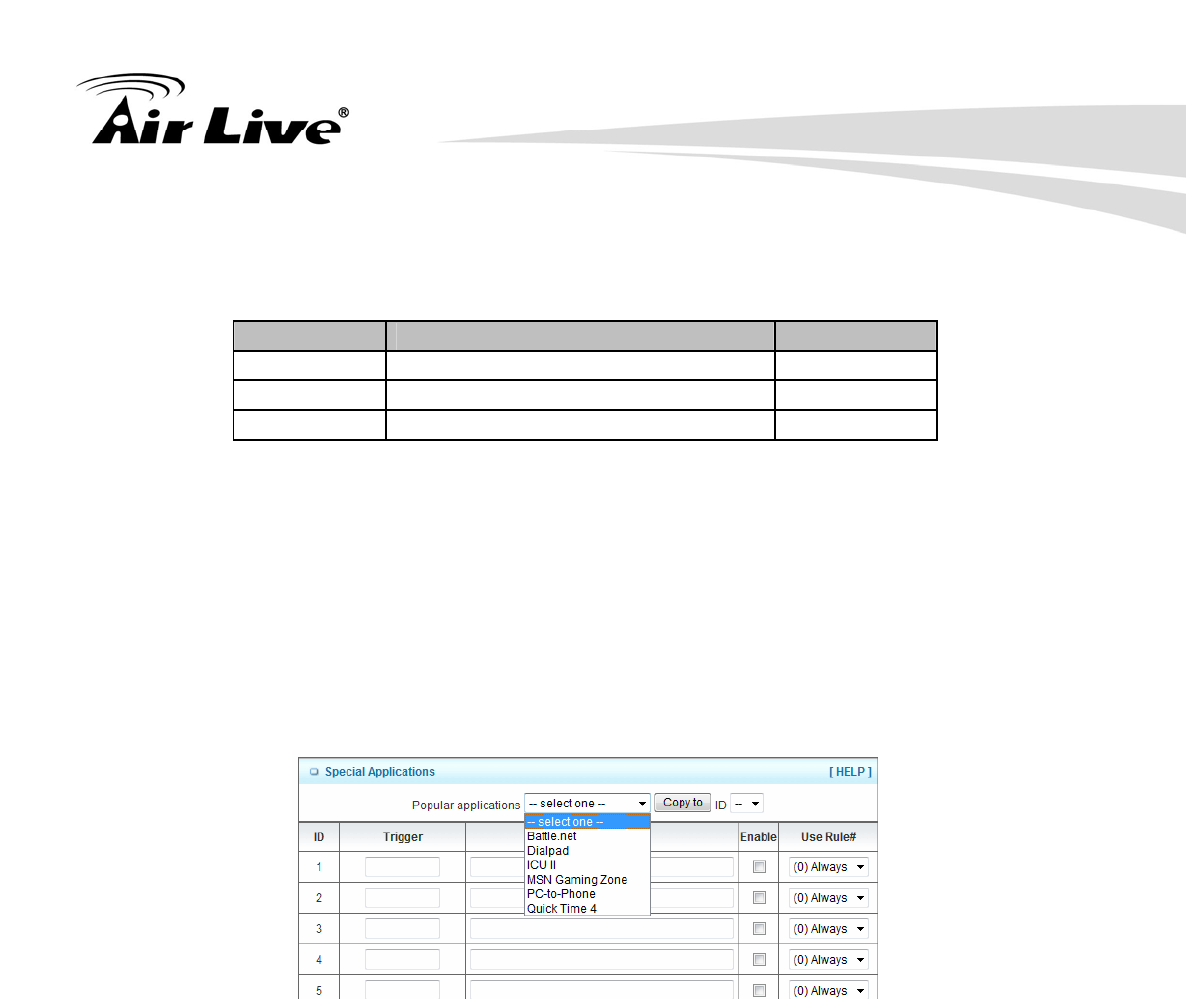
3. Configuration
AirLive N450R User’s Manual
61
For example, if you have an FTP server (port 21) at 192.168.1.1, a Web server (port 80) at
192.168.1.2, and a VPN server at 192.168.1.6, then you need to specify the following
virtual server mapping table: Service Port
Server IP Enable
21 192.168.1.1 V
80 192.168.1.2 V
1723 192.168.1.6 V
Afterwards, click on “Save” to store your settings or click “Undo” to give up the changes.
3.3.2 Special AP
Some applications require multiple connections, like Internet games, Video conferencing,
Internet telephony, etc. Because of the firewall function, these applications cannot work
with a pure NAT router. The Special Applications feature allows some of these
applications to work with this product. If the mechanism of Special Applications fails to
make an application work, try setting your computer as the DMZ host instead.
1. Trigger
The outbound port number issued by the application.
2. Incoming Ports
When the trigger packet is detected, the inbound packets sent to the specified port
numbers are allowed to pass through the firewall.
3. Enable
Check the checkbox to activate each of rule. This device provides some predefined
settings. Select your application and click “Copy to” to add the predefined setting to
your list. Click on “Save” to store your settings or click “Undo” to give up the changes.
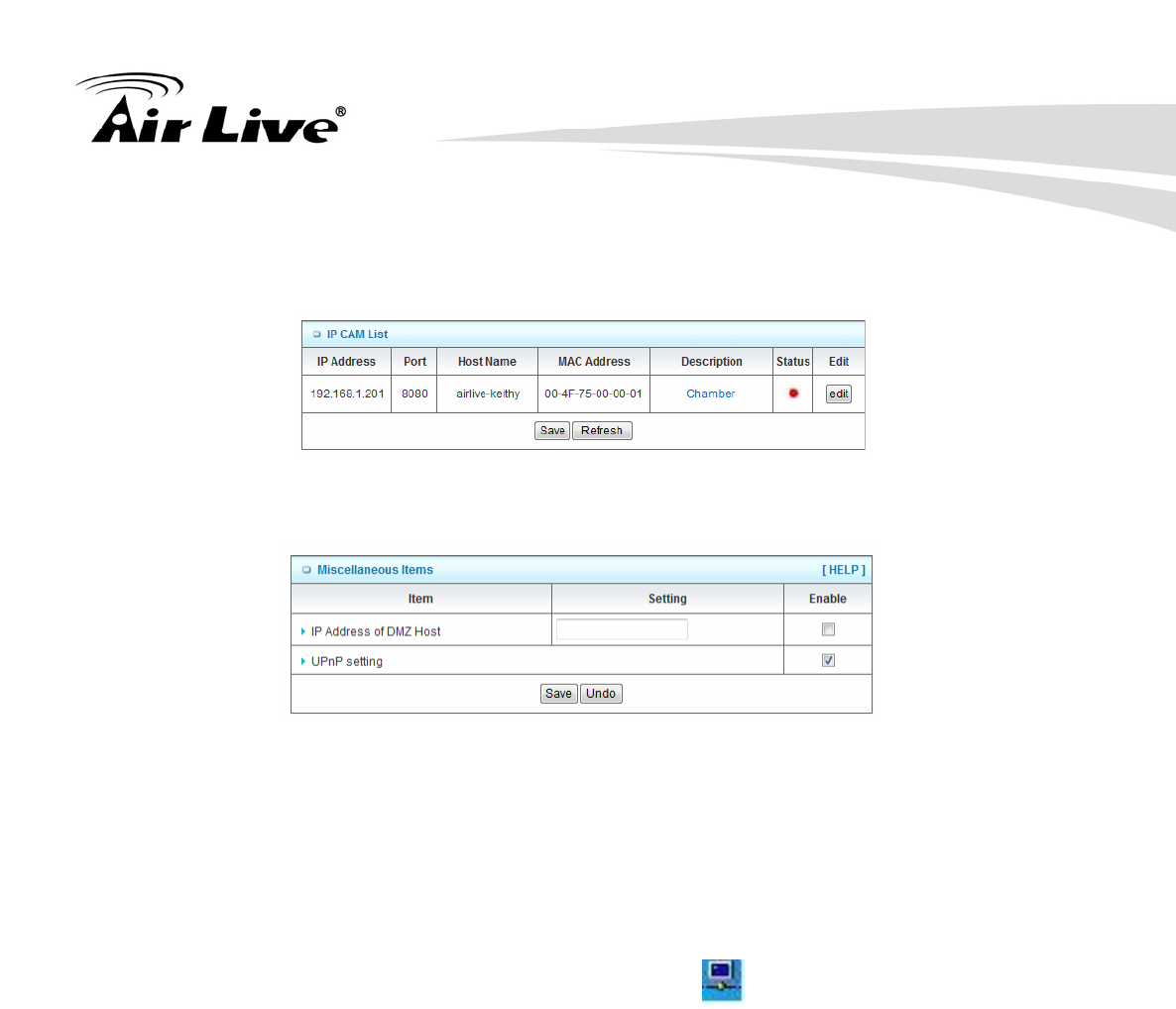
3. Configuration
AirLive N450R User’s Manual
62
3.3.3 IP CAM
After you plug AirLive IP Camera into PnP Router, please check the IP CAM table list as
following.
3.3.4 Miscellaneous
1. IP Address of DMZ Host
DMZ (Demilitarized Zone) Host is a host without the protection of firewall. It allows a
computer to be exposed to unrestricted 2-way communication for Internet games,
Video conferencing, Internet telephony and other special applications.
2. UPnP Setting
The device supports the UPnP function. If the OS of your client computer supports
this function, and you enabled it, like Windows XP, you can see the following icon
when the client computer gets IP from the device.
Click on “Save” to store your settings or click “Undo” to give up the changes.
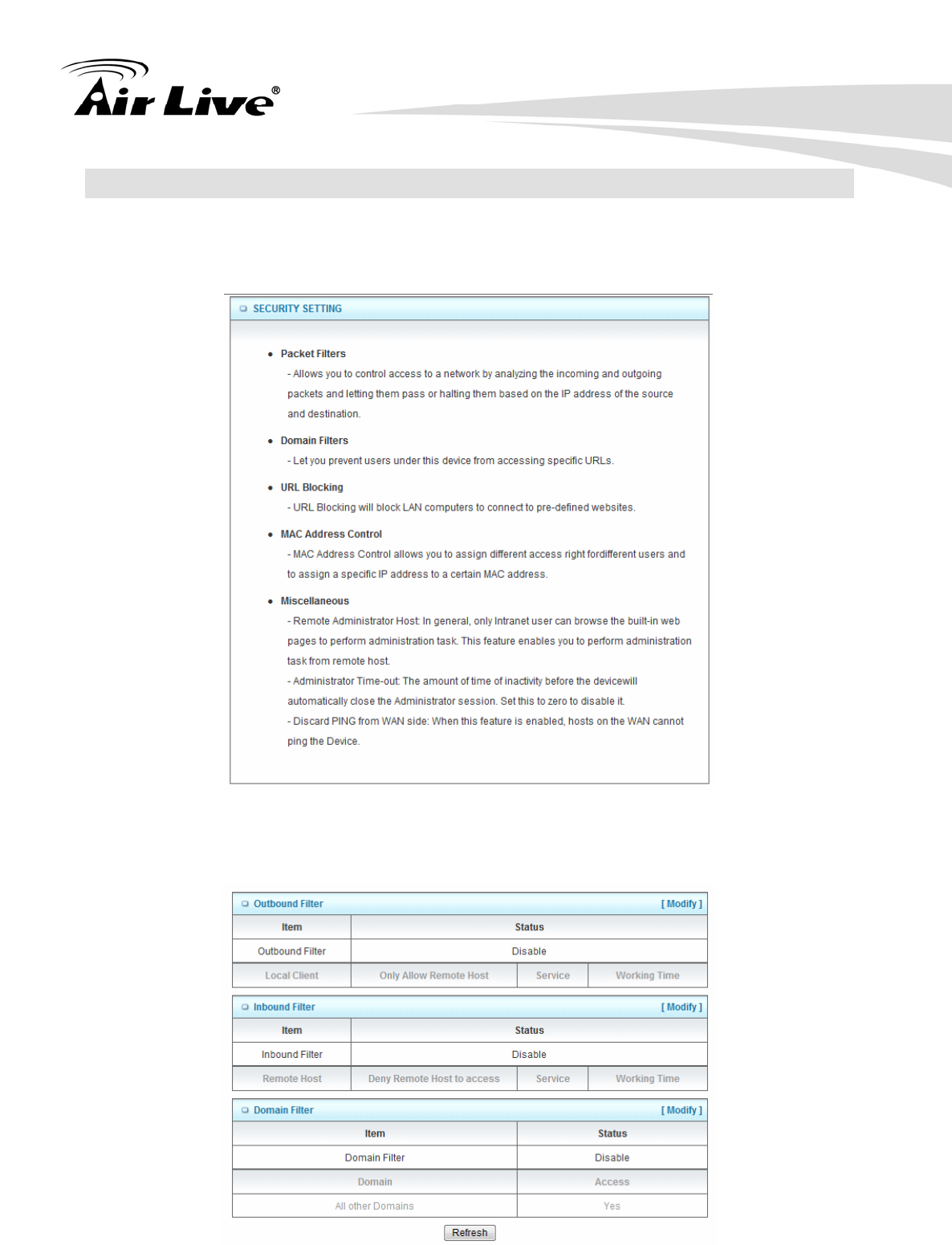
3. Configuration
AirLive N450R User’s Manual
63
3.4 Security Setting
The security setting includes Packet Filter, Domain Filter, URL Blocking, MAC
Address Control, L2TP/PPTP Client, and Miscellaneous.
3.4.1 Status
You can see the security log on the status page as following,
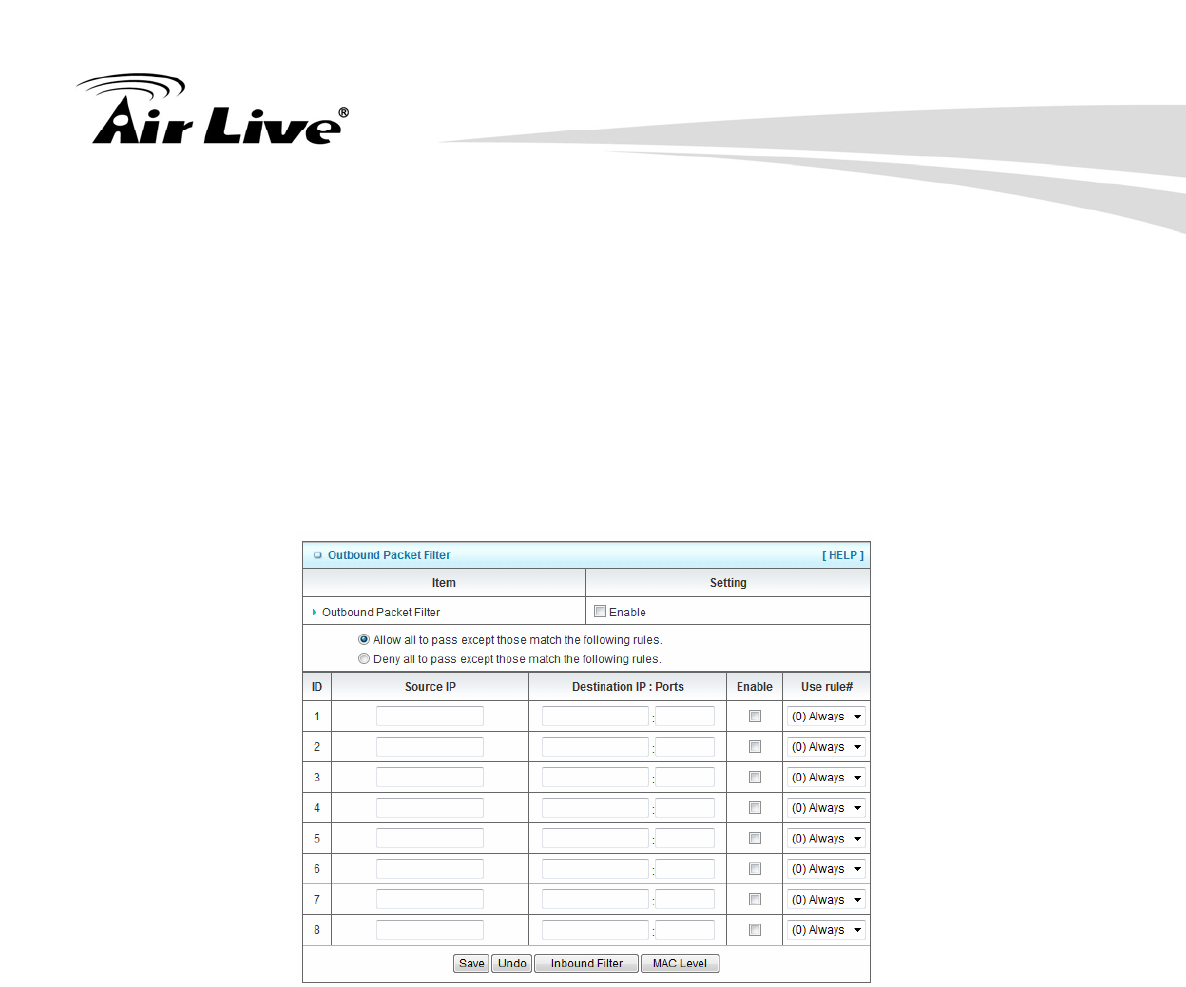
3. Configuration
AirLive N450R User’s Manual
64
3.4.2 Packet Filters
Packet Filter includes both outbound filter and inbound filter. And they have same way to
setting.
Packet Filter enables you to control what packets are allowed to pass the router.
Outbound filter applies on all outbound packets. However, inbound filter applies on
packets that destined to Virtual Servers or DMZ host only. You can select one of the two
filtering policies:
1. Allow all to pass except those match the specified rules
2. Deny all to pass except those match the specified rules
You can specify 8 rules for each direction: inbound or outbound. For each rule, you can
define the following:
Source IP address
Destination IP address
Destination port
Enable or Disable
Use Rule#
For source or destination IP address, you can define a single IP address (4.3.2.1) or a
range of IP addresses (4.3.2.1-4.3.2.254). An empty implies all IP addresses.
For source or destination port, you can define a single port (80) or a range of ports
(1000-1999). Add prefix "T" or "U" to specify TCP or UDP protocol. For example, T80, U53,
U2000-2999, No prefix indicates both TCP and UDP are defined. An empty implies all port
addresses. Packet Filter can work with Scheduling Rules, and give user more flexibility
on Access control. For Detail, please refer to Scheduling Rule.
Each rule can be enabled or disabled individually.
Click on “Save” to store your settings or click “Undo” to give up the changes.
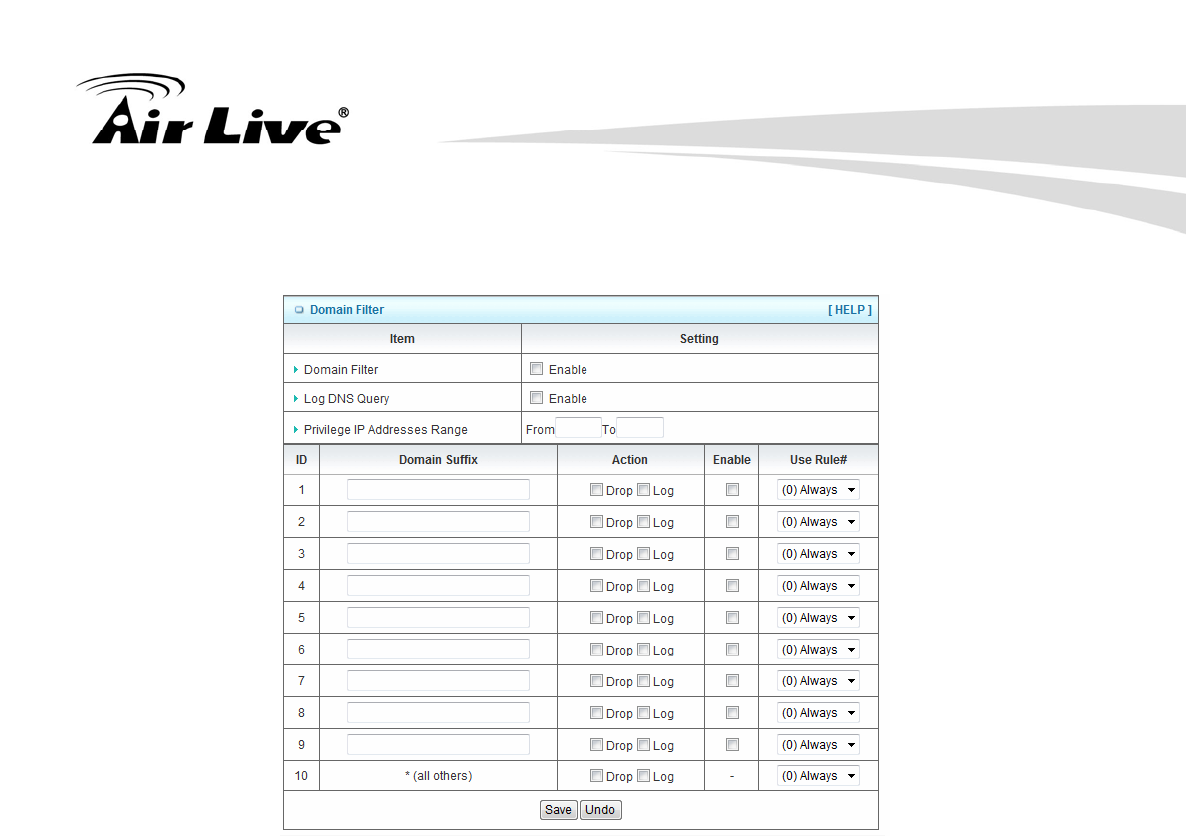
3. Configuration
AirLive N450R User’s Manual
65
3.4.3 Domain Fitters
Domain Filter prevents users under this device from accessing specific URLs.
1. Domain Filter
Check if you want to enable Domain Filter.
2. Log DNS Query
Check if you want to log the action when someone accesses the specific URLs.
3. Privilege IP Address Range
Setting a group of hosts and privilege these hosts to access network without
restriction.
4. Domain Suffix
A suffix of URL can be restricted, for example, ".com", "xxx.com".
5. Action
When someone is accessing the URL met the domain-suffix, what kind of action you
want.
Check “Drop” to block the access. Check “Log” to log this access.
6. Enable
Check to enable each rule.
Click on “Save” to store your settings or click “Undo” to give up the changes.
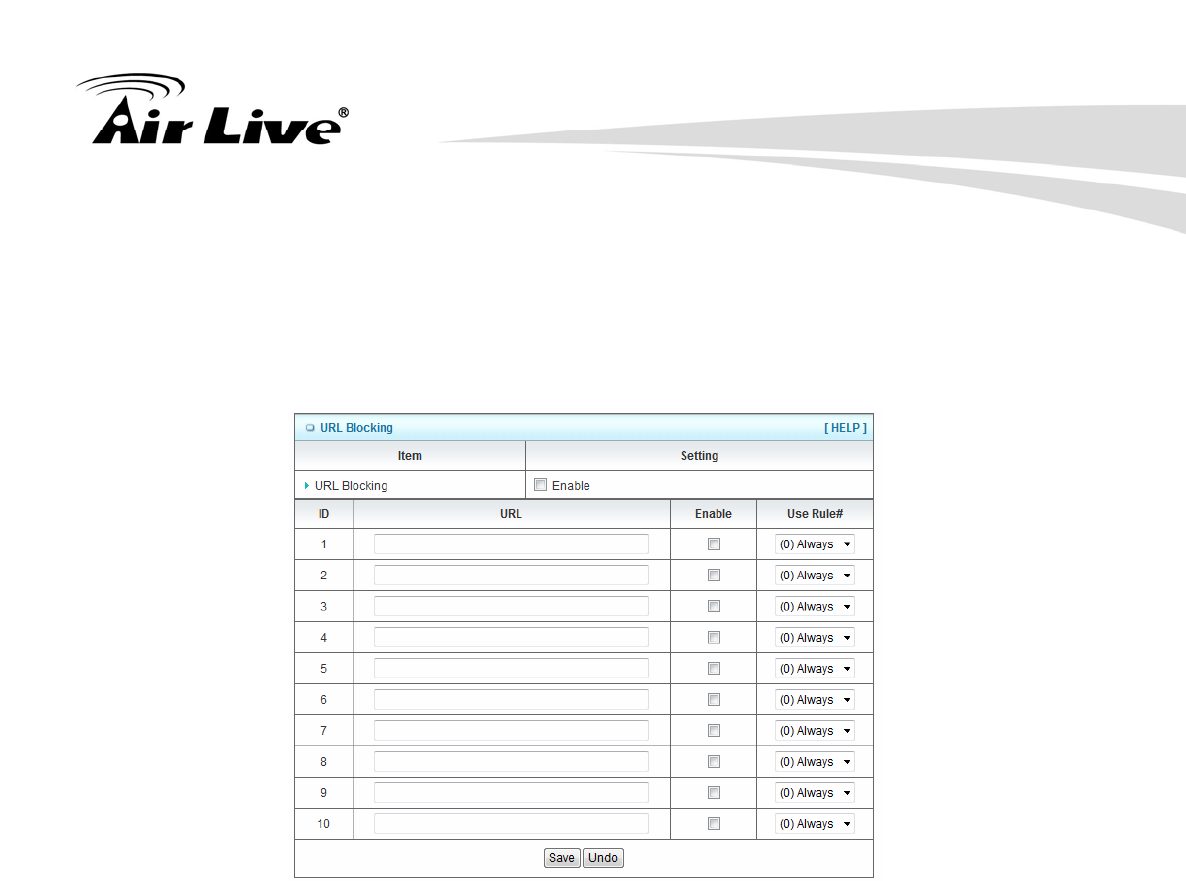
3. Configuration
AirLive N450R User’s Manual
66
3.4.4 URL Blocking
URL Blocking will block LAN computers to connect with pre-define Websites. The major
difference between “Domain filter” and “URL Blocking” is Domain filter requires user to
input suffix (like .com or .org, etc), while URL Blocking requires user to input a keyword
only. In other words, Domain filter can block specific website, while URL Blocking can
block hundreds of websites by simply a keyword.
1. URL Blocking
Check if you want to enable URL Blocking.
2. URL
If any part of the Website's URL matches the pre-defined word, the connection will be
blocked.
For example, you can use pre-defined word "sex" to block all websites if their URLs
contain pre-defined word "sex".
3. Enable
Check to enable each rule.
4. Use Rule#
You can set a schedule rule for each of rule.
Click on “Save” to store your settings or click “Undo” to give up the changes.
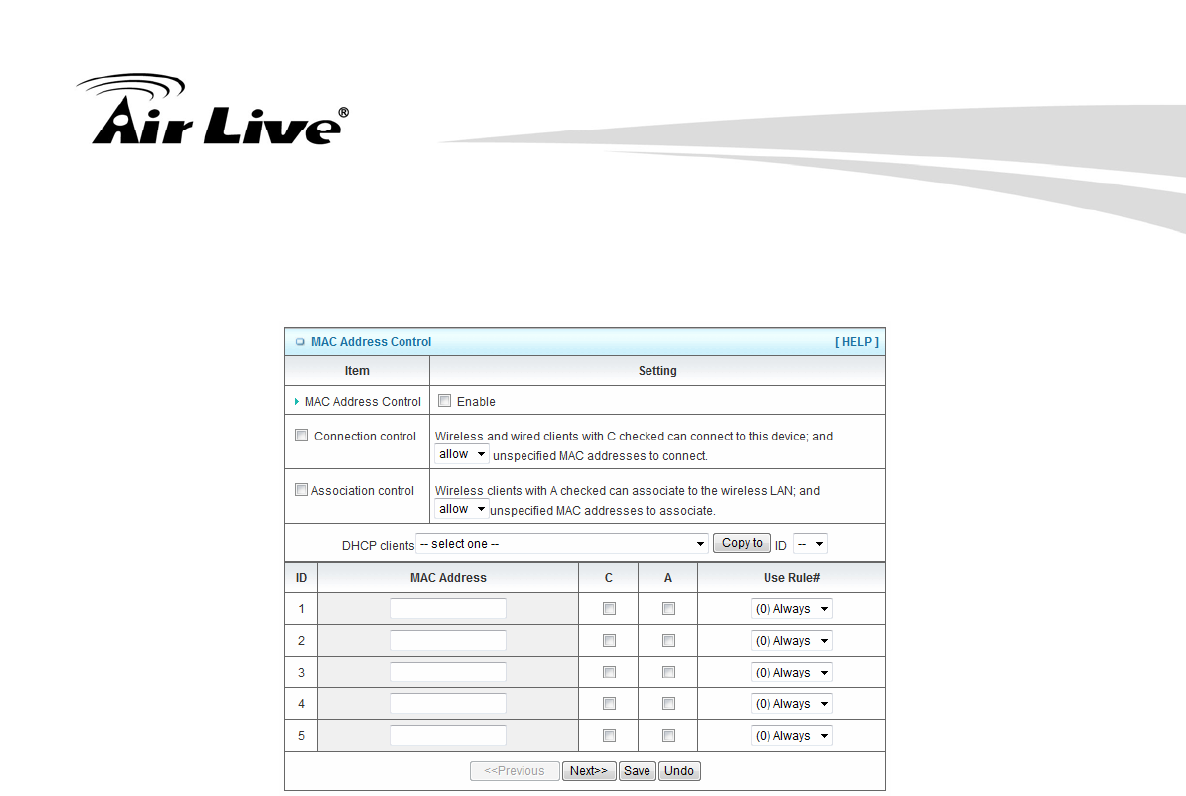
3. Configuration
AirLive N450R User’s Manual
67
3.4.5 MAC Control
MAC Address Control allows you to assign different access right for different users and to
assign a specific IP address to a certain MAC address.
1. MAC Address Control
Check “Enable” to enable the “MAC Address Control”. All of the settings in this
page will take effect only when “Enable” is checked.
2. Connection control
Check "Connection control" to enable the controlling of which wired and wireless
clients can connect with this device. If a client is denied to connect with this device,
it means the client can't access to the Internet either. Choose "allow" or "deny" to
allow or deny the clients, whose MAC addresses are not in the "Control table"
(please see below), to connect with this device.
3. Association control
Check "Association control" to enable the controlling of which wireless client can
associate to the wireless LAN. If a client is denied to associate to the wireless LAN,
it means the client can't send or receive any data via this device. Choose "allow"
or "deny" to allow or deny the clients, whose MAC addresses are not in the
"Control table", to associate to the wireless LAN.
Click on “Save” to store your settings or click “Undo” to give up the changes.
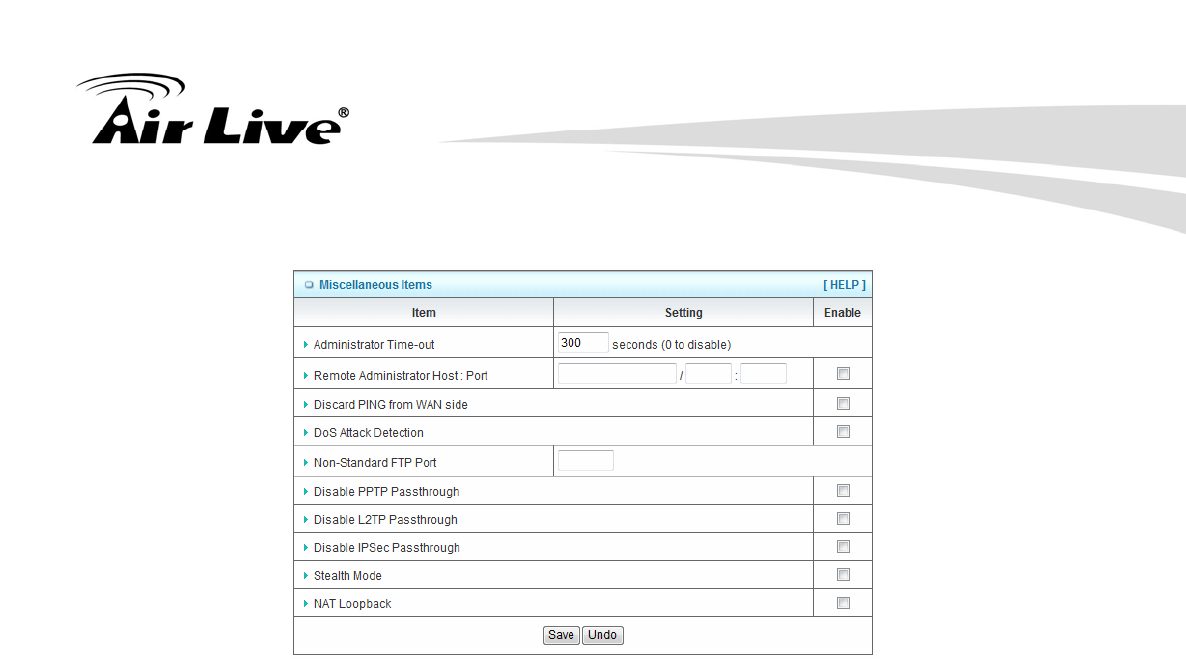
3. Configuration
AirLive N450R User’s Manual
68
3.4.6 Miscellaneous
1. Administrator Time-out
The time of no activity to logout automatically, you may set it to zero to disable this
feature.
2. Remote Administrator Host/Port
In general, only Intranet user can browse the built-in web pages to perform
administration task. This feature enables you to perform administration task from
remote host. If this feature is enabled, only the specified IP address can perform
remote administration. If the specified IP address is 0.0.0.0, any host can connect
with this product to perform administration task. You can use subnet mask bits "/nn"
notation to specified a group of trusted IP addresses for example, "10.1.2.0/24".
NOTE: When Remote Administration is enabled, the web server port will be shifted to 80.
You can change web server port to other port, too.
3. Discard PING from WAN side
When this feature is enabled, any host on the WAN cannot ping this product.
4. DoS Attack Detection
When this feature is enabled, the router will detect and log the DoS attack comes
from the Internet. Currently, the router can detect the following DoS attack: SYN
Attack, WinNuke, Port Scan, Ping of Death, Land Attack etc.
5. Non-Standard FTP port
If you want to access a WAN FTP server which doesn’t use port 21, you need to
indicate the port number that WAN FTP uses.
6. Disable PPTP passthrough
The PPTP passthrough is enabled by default. You can disable here.
7. Disable L2TP passthrough
The L2TP passthrough is enabled by default. You can disable here.
8. Disable IPSec passthrough
The IPSec passthrough is enabled by default. You can disable here.
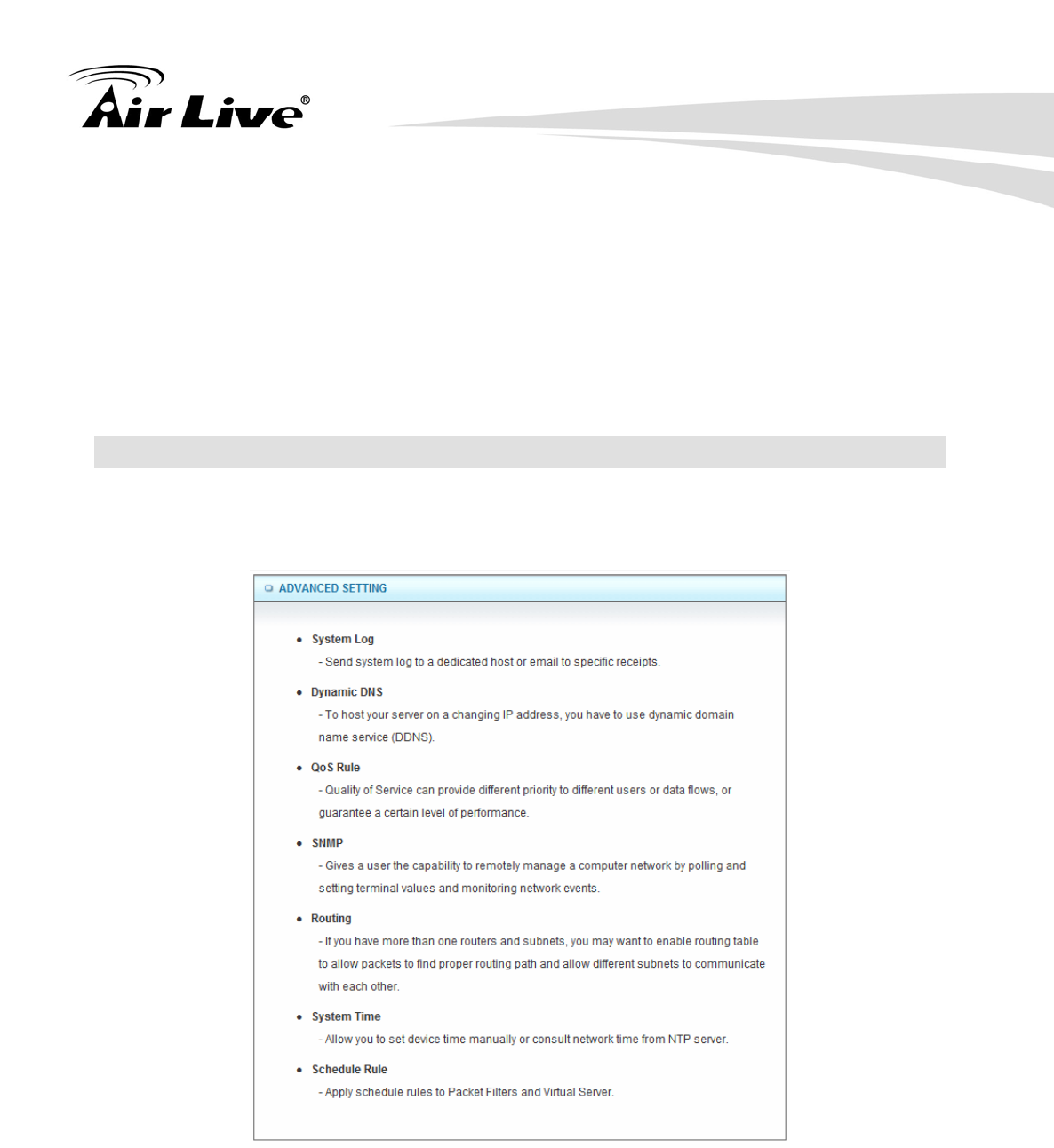
3. Configuration
AirLive N450R User’s Manual
69
9. Stealth Mode
If enable this option, router will become “hidden” if someone uses port scan utility to
scan available ports on this router.
10. NAT Loopback
If enable this option, local hosts can access local virtual server via WAN IP address of
this router.
Click on “Save” to store your settings or click “Undo” to give up the changes.
3.5 Advanced Setting
The Advanced Setting includes System Log, Dynamic DNS, QoS, SNMP, Routing,
System Time, Schedule Rule, IPv6, and VLAN settings.
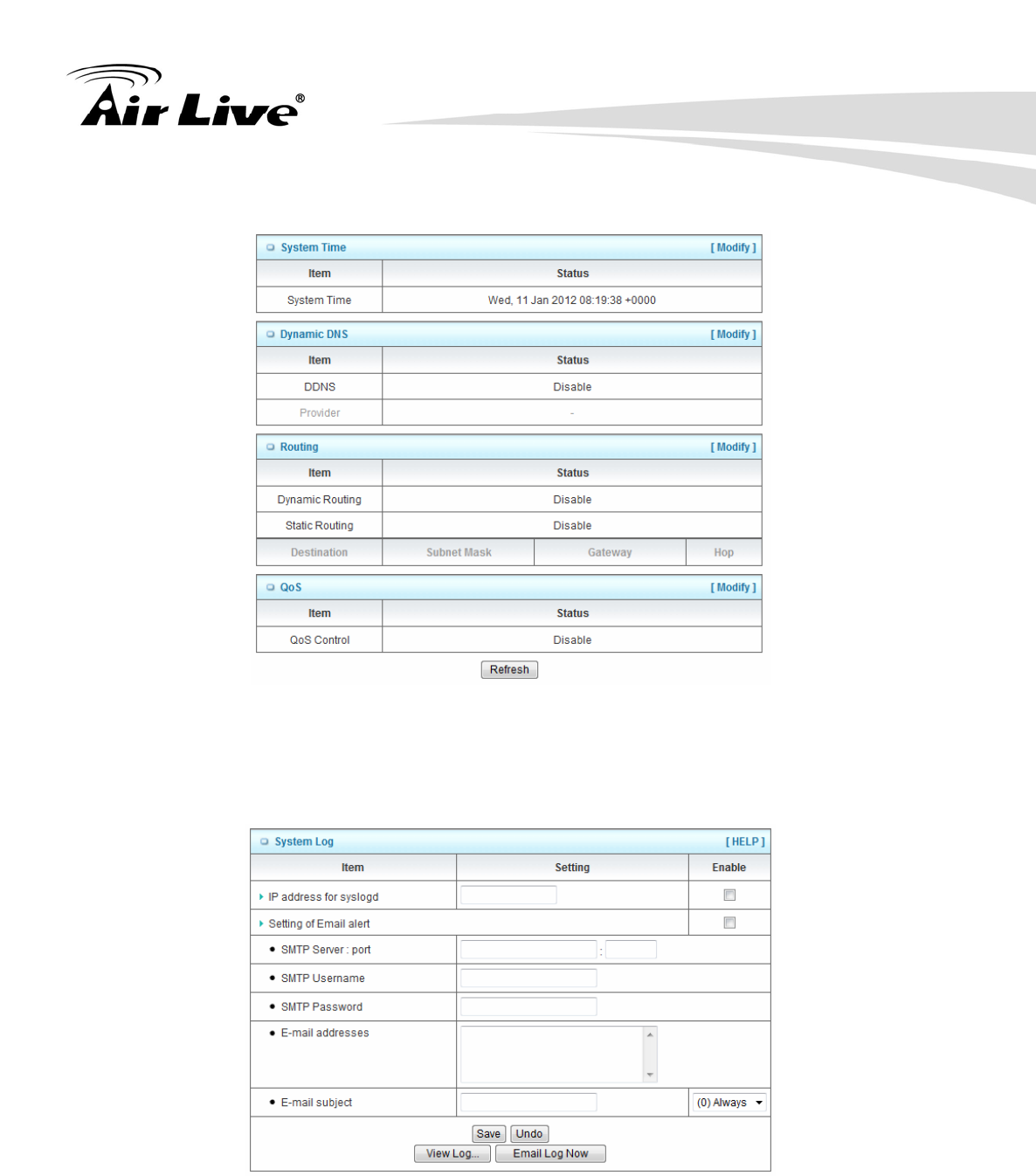
3. Configuration
AirLive N450R User’s Manual
70
3.5.1 Status
3.5.2 System Log
This page supports two methods to export system logs to specific destination by
means of syslog (UDP) and SMTP (TCP). The items you have to setup including:
1. IP Address for Sys log
Host IP of destination where sys log will be sent to. Check Enable to enable this
function.
2. Setting of E-mail Alert
Check if you want to enable Email alert (send syslog via email).
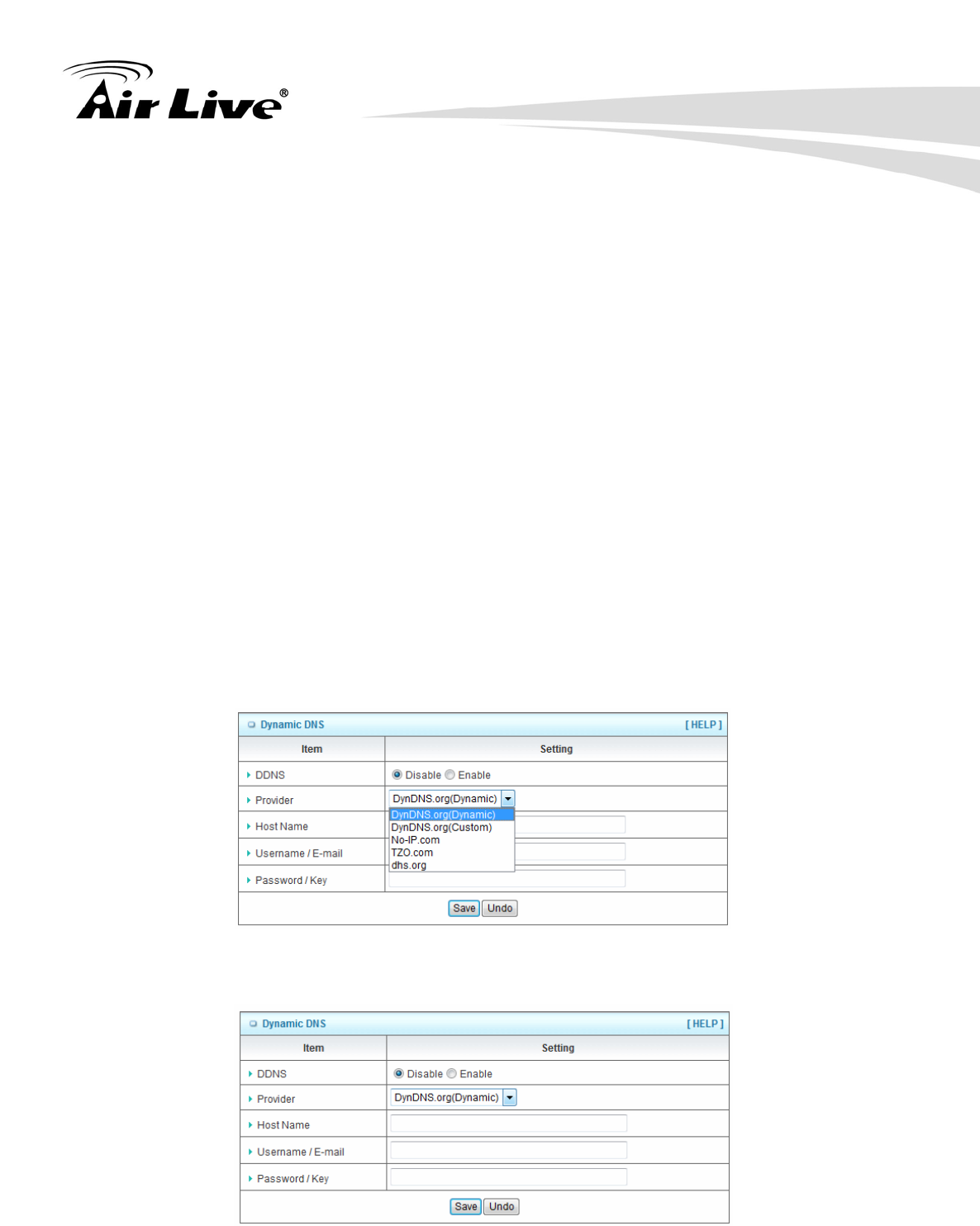
3. Configuration
AirLive N450R User’s Manual
71
3. SMTP Server:Port
Input the SMTP server IP and port, which are connected with ':'. If you do not specify
port number, the default value is 25.
For example, "mail.your_url.com" or "192.168.1.100:26".
4. SMTP Username
Input username of your account on this SMTP server.
5. SMTP Password
Input password of your account on this SMTP server.
6. E-mail address
The recipients who will receive these logs, you can assign more than 1 recipient,
using ';' or ',' to separate these email addresses.
7. E-mail Subject
The subject of email alert, this setting is optional.
Click on “Save” to store your settings or click “Undo” to give up the changes.
3.5.2 Dynamic DNS
To host your server on a changing IP address, you have to use dynamic domain name
service (DDNS). So that anyone wishing to reach your host only needs to know the name
of it. Dynamic DNS will map the name of your host to your current IP address, which
changes each time you connect your Internet service provider.
Before you enable Dynamic DNS, you need to register an account on one of these
Dynamic DNS servers that we list in Provider field.
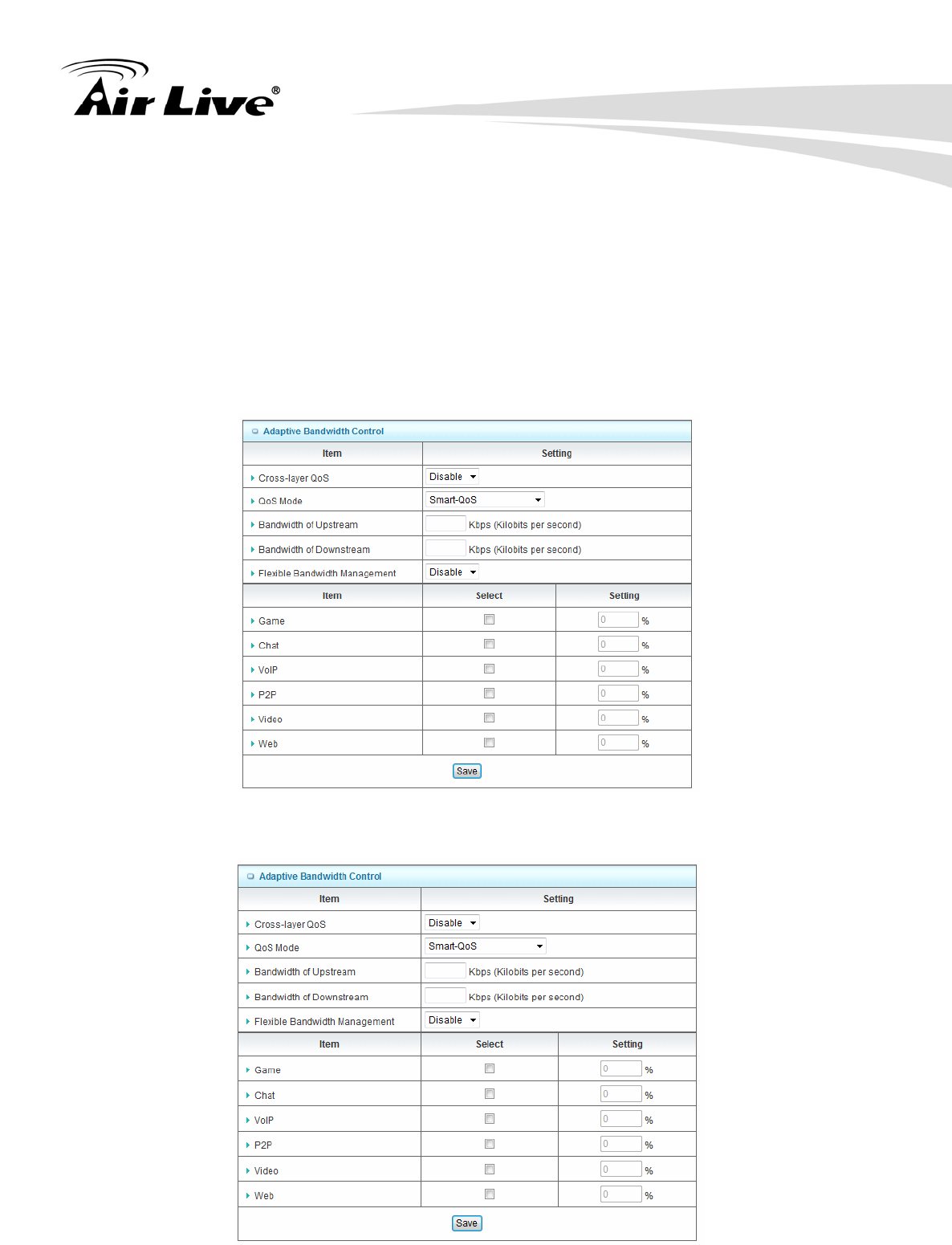
3. Configuration
AirLive N450R User’s Manual
72
To enable Dynamic DNS click the check box next to Enable in the DDNS field. Next you
have to enter the appropriate information about your Dynamic DNS Serve .Provider, Host
Name, Username/E-mail, and Password/Key. You can get this information when you
register an account on a Dynamic DNS server.
Click on “Save” to store your settings or click “Undo” to give up the changes.
3.5.3 QoS
Quality of Service is the ability to provide different priority to different applications, users,
or data flows, or to guarantee a certain level of performance to a data flow.
(A) Smart QoS
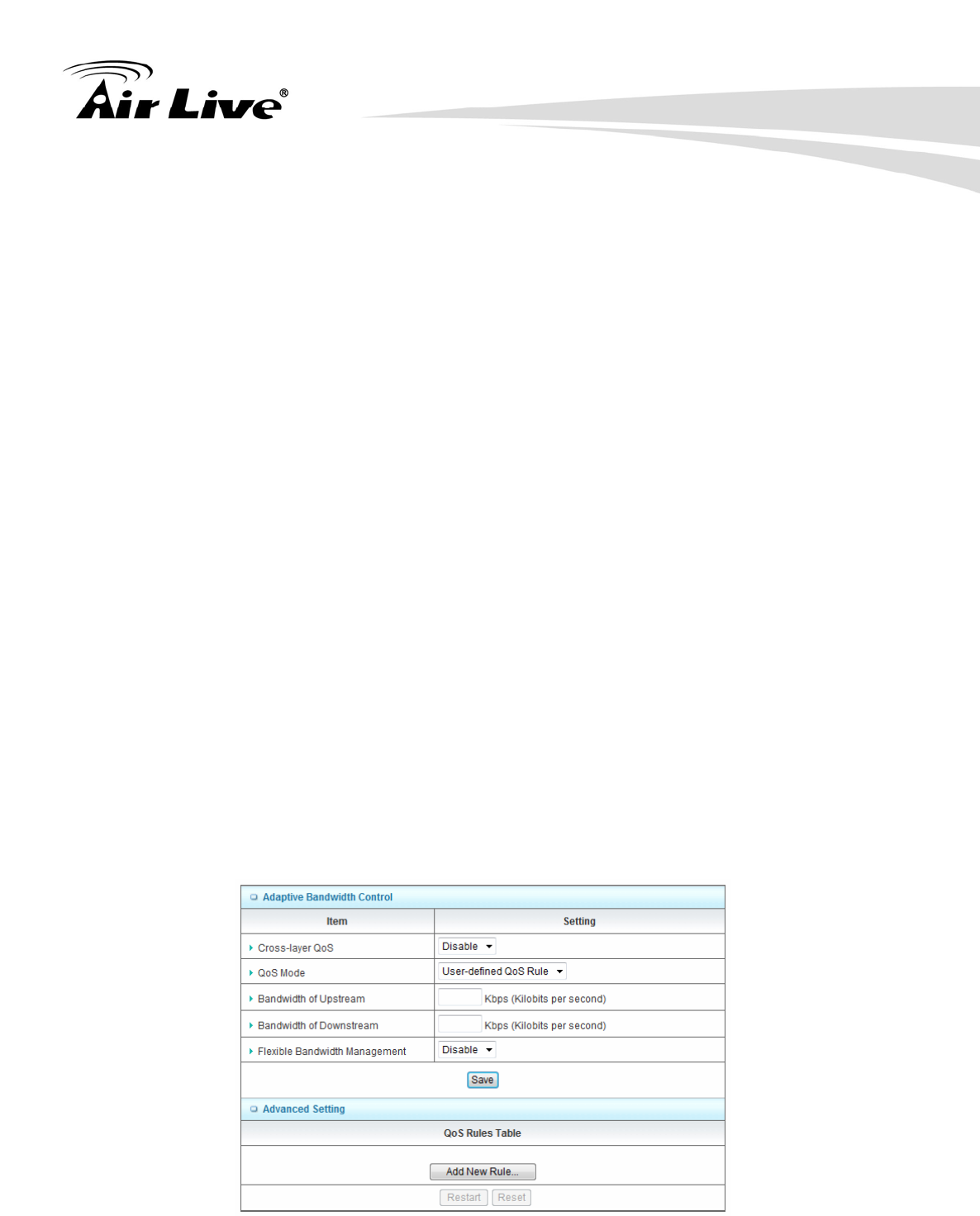
3. Configuration
AirLive N450R User’s Manual
73
1. Cross-layer QoS
You can select enable/disable the QoS control
2. QoS Mode
You can select Smart-QoS or User defined QoS rule for your own QoS control
3. Bandwidth of upstream / bandwidth of Downstream
You can input the value of maximize of upstream and downstream bandwidth from
your ISP
4. Enable Flexible Bandwidth management
If you enable this management, system will share the bandwidth of those selected
applications to other applications if user do not run those selected application, for
example, If you select Game/ VoIP/ Video 3 applications for higher priority in your
system, then the system will automatically reserve 10% of bandwidth to other
application, and share the rest of bandwidth (100-10)/3=30% each to
Game/VoIP/Video, so if user do not play a game, then the system will flexible share
the 30% of bandwidth to other application.
5. Example for Smart-QoS with FBM enable
Mr. Wang selects Game/ VoIP/ Video 3 applications for higher priority in his system,
the system will automatically reserve 10% of minimum rate of bandwidth to other
application, and share the rest minimum rate of bandwidth (100-10)/3=30% each to
Game/VoIP/Video. If Mr. Wang’s son plays on-line game in the morning, the total
bandwidth will all reserve to his son. By the evening, when Mr. Wang back home and
wants to watch IPTV, then he will get the same priority with his son, and share the
bandwidth.
6. Disable Flexible Bandwidth Management
If you disable this management, system will allow you to input percentage of
bandwidth manually.
(B) User defined QoS Rule
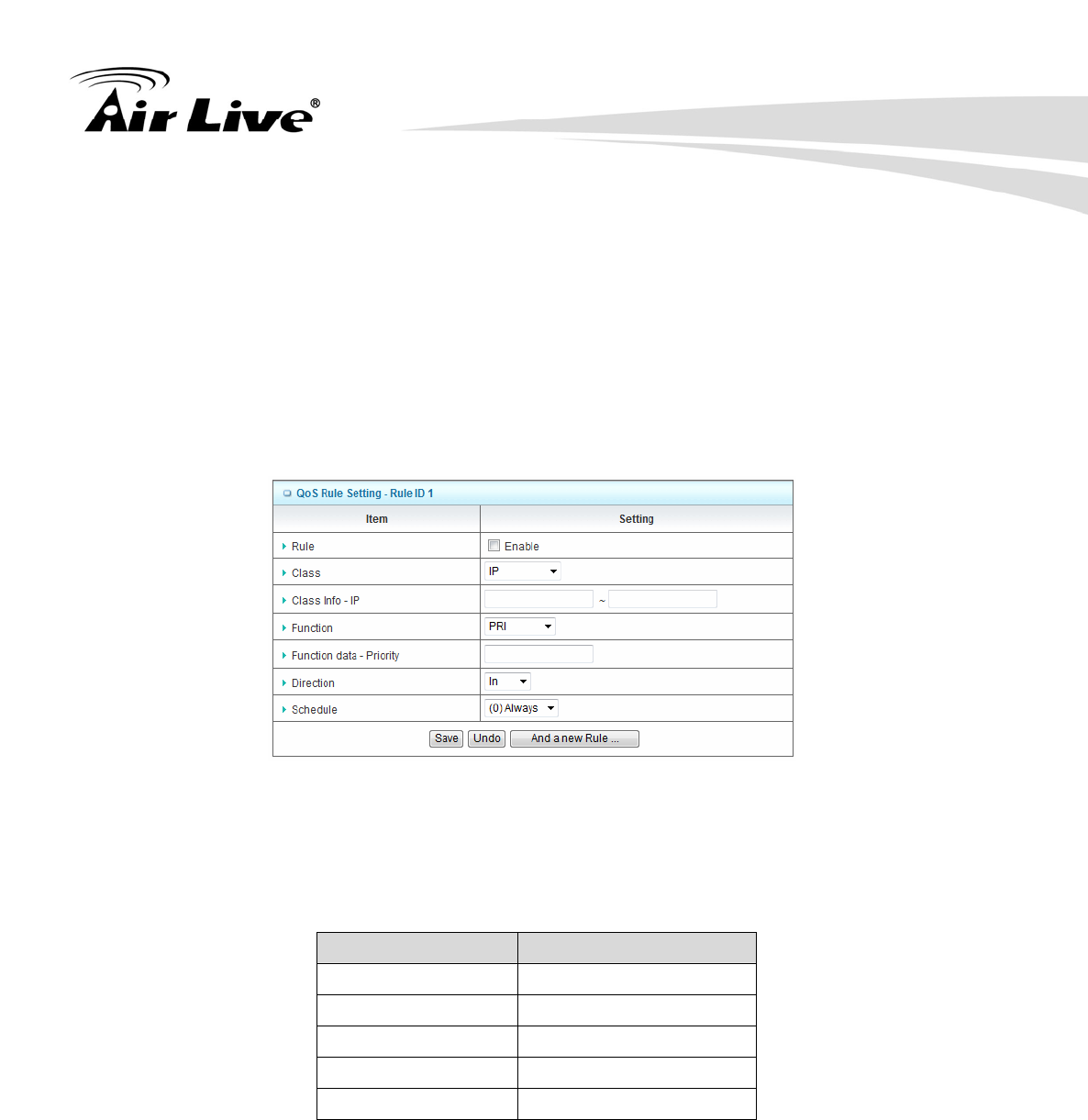
3. Configuration
AirLive N450R User’s Manual
74
1. Cross-layer QoS
You can enable/disable this QoS system.
2. QoS Mode
You can select User defined QoS rule for your own QoS control
3. Bandwidth of upstream / bandwidth of Downstream
You can input the value of maximize of upstream and downstream bandwidth from
your ISP
4. Advance setting
You can press the button of ‘Add New Rule’ to create a new QoS rule.
5. Create a QoS Rule
You can enable the rule, and select QoS class type as below.
Class: You can create your own QoS rule by different classes as below.
Class Description
IP IP address base
N TCP port
UDPPORT UDP port
MAC MAC base
DSCP DSCP base
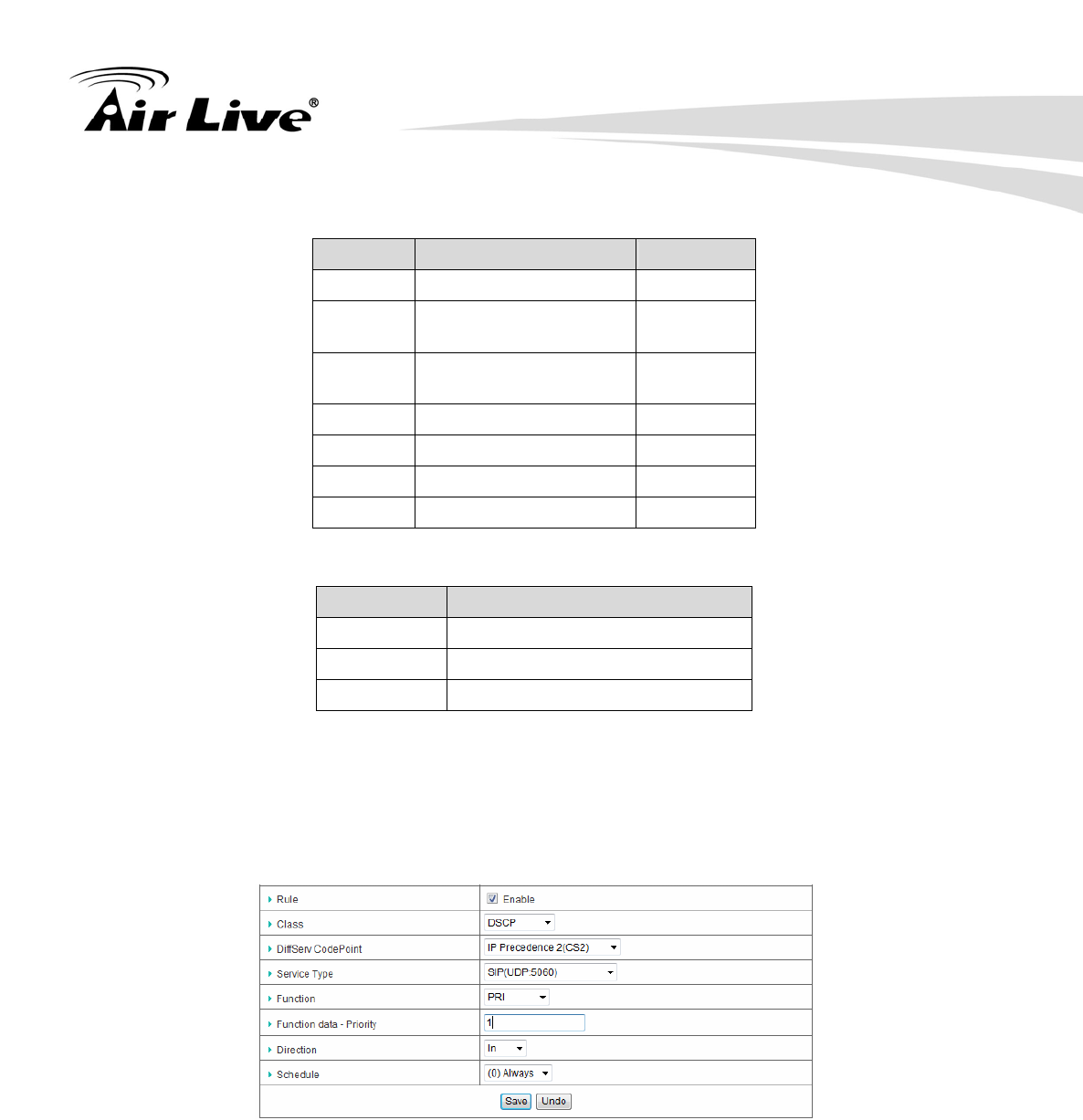
3. Configuration
AirLive N450R User’s Manual
75
Function: You can set your own function value to enable your QoS rule as below.
Function Description Data
PRI Priority 1~6
MAXR Maximum bandwidth
Rate KBps/MBps
MINR Minimum bandwidth
Rate KBps/MBps
SESSION Connection session number
DROP Drop packet None
LOG Log event None
ALERT Alert event None
Direction: You can select inbound/ outbound for your direction.
Direction
IN inbond
OUT outbond
BOTH inbond & outbond
6. DSCP setting: You can set your own DSCP value here.
DiffServ Code Point: you can select code value.
Service Type: You can select their service type.
Function: PRI
Function data- Priority: 1~6
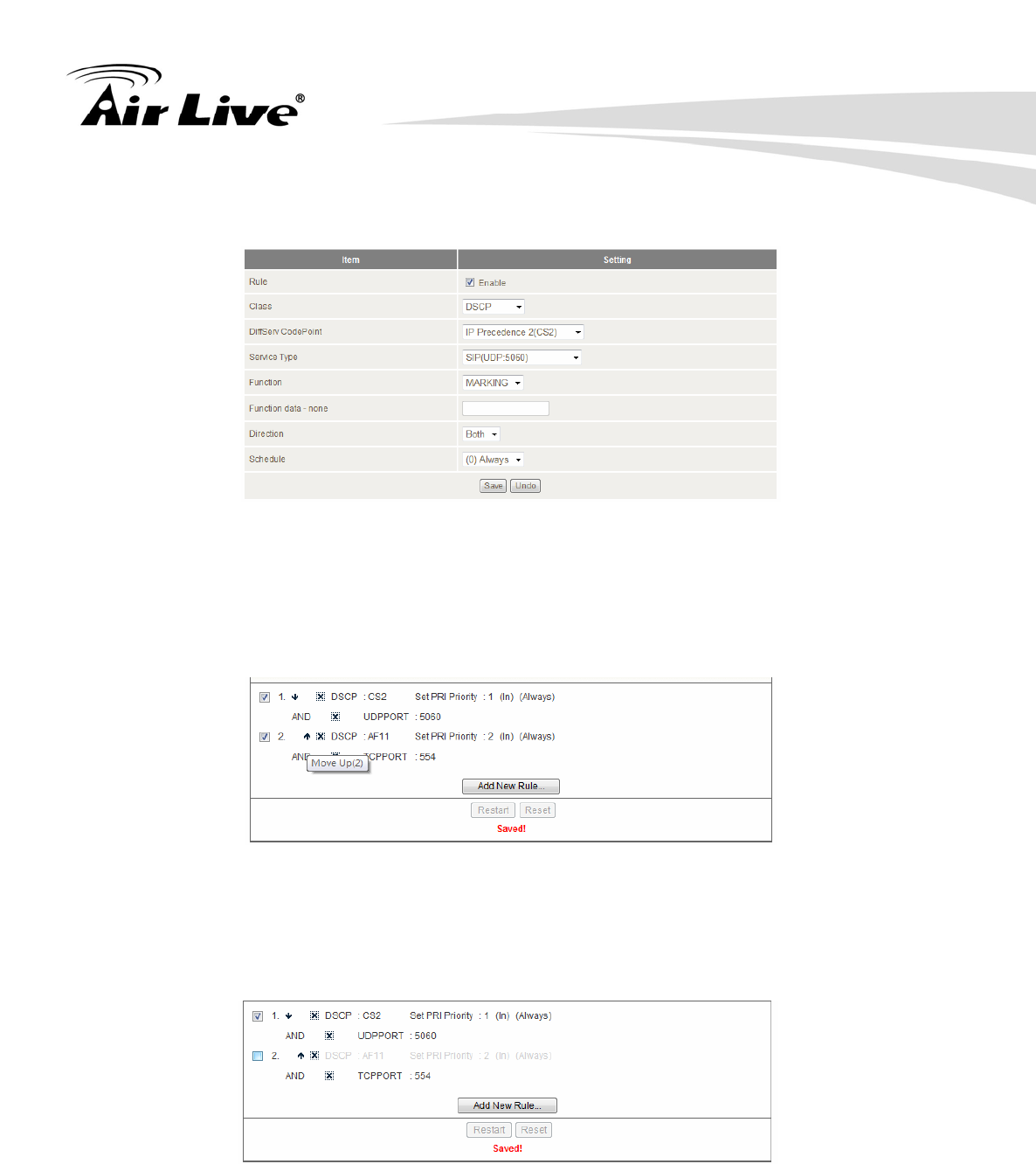
3. Configuration
AirLive N450R User’s Manual
76
DSCP marking
You can add your inbound / outbound packets a DCSP marking,
For example
Please mark CS3 when an packet in/ out via UDP port 5060.Once you saved the QoS rule,
system will show you the rule as below, you can add another new rule accordingly.
System will show you all your QoS rule as below
NOTE: You can move up or down the priority of all rules by pointing the ‘↑’or ’↓’ if you want
to change the priority.
NOTE: You can unmark any rule if you do not want it enable now.
Provide different priority to different users or data flows, or guarantee a certain level of
performance.
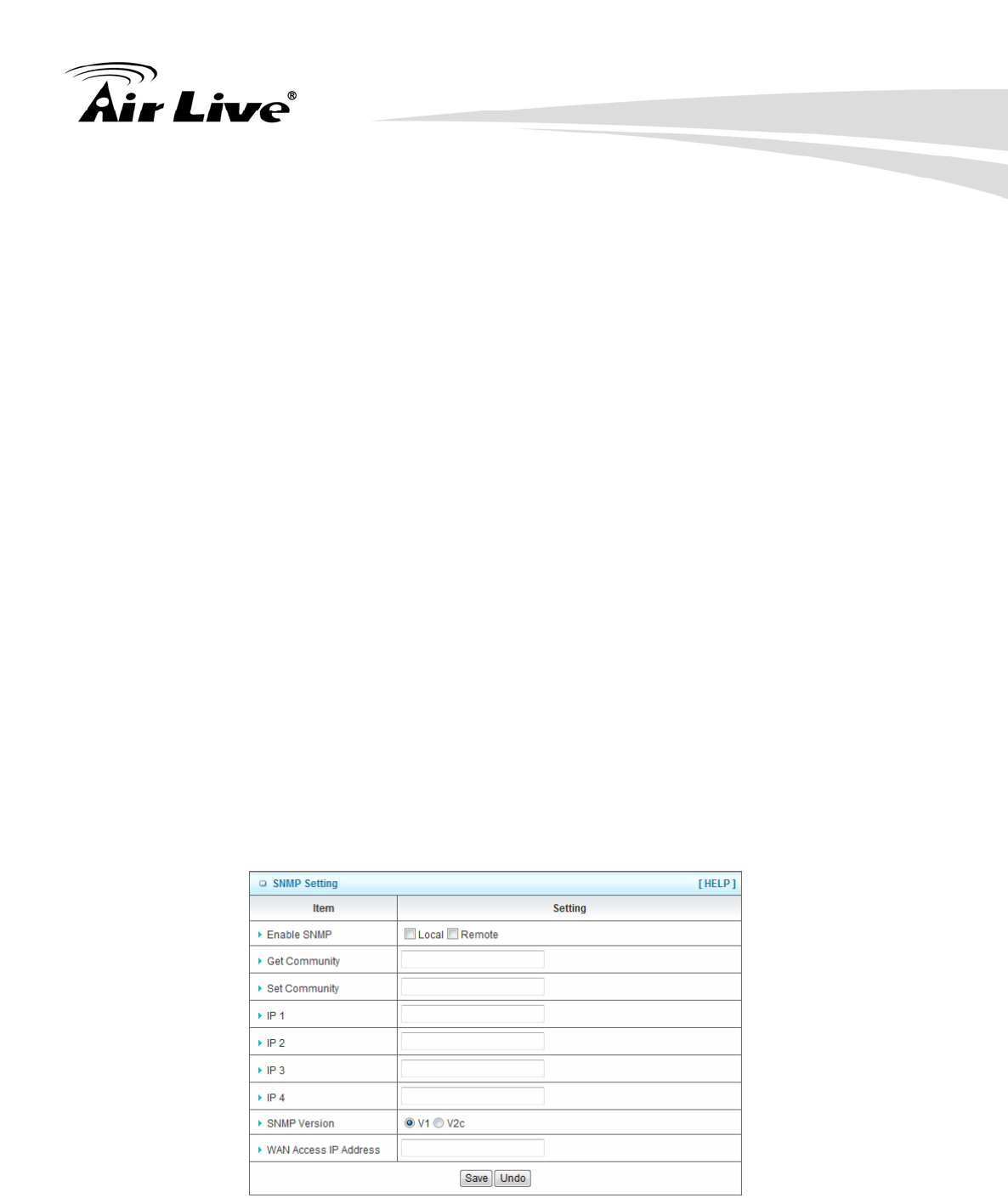
3. Configuration
AirLive N450R User’s Manual
77
1. QOS Control
Check Enable to enable this function.
2. Bandwidth of Upstream
Set the limitation of upstream bandwidth
3. Local IP : Ports
Define the Local IP address and ports of packets
4. Remote IP : Ports
Define the Remote IP address and ports of packets
5. QoS Priority
This defines the priority level of the current Policy Configuration. Packets associated
with this policy will be serviced based upon the priority level set. For critical
applications High or Normal level is recommended. For non-critical applications select
a Low level.
6. Enable
Check to enable the corresponding QOS rule.
7. User Rule#
The QoS rule can work with Scheduling Rule number#. Please refer to the Section
3.1.4.7 Schedule Rule.
Click on “Save” to store your settings or click “Undo” to give up the changes.
3.5.4 SNMP
In brief, SNMP, the Simple Network Management Protocol, is a protocol designed to give
a user the capability to remotely manage a computer network by polling and setting
terminal values and monitoring network events.
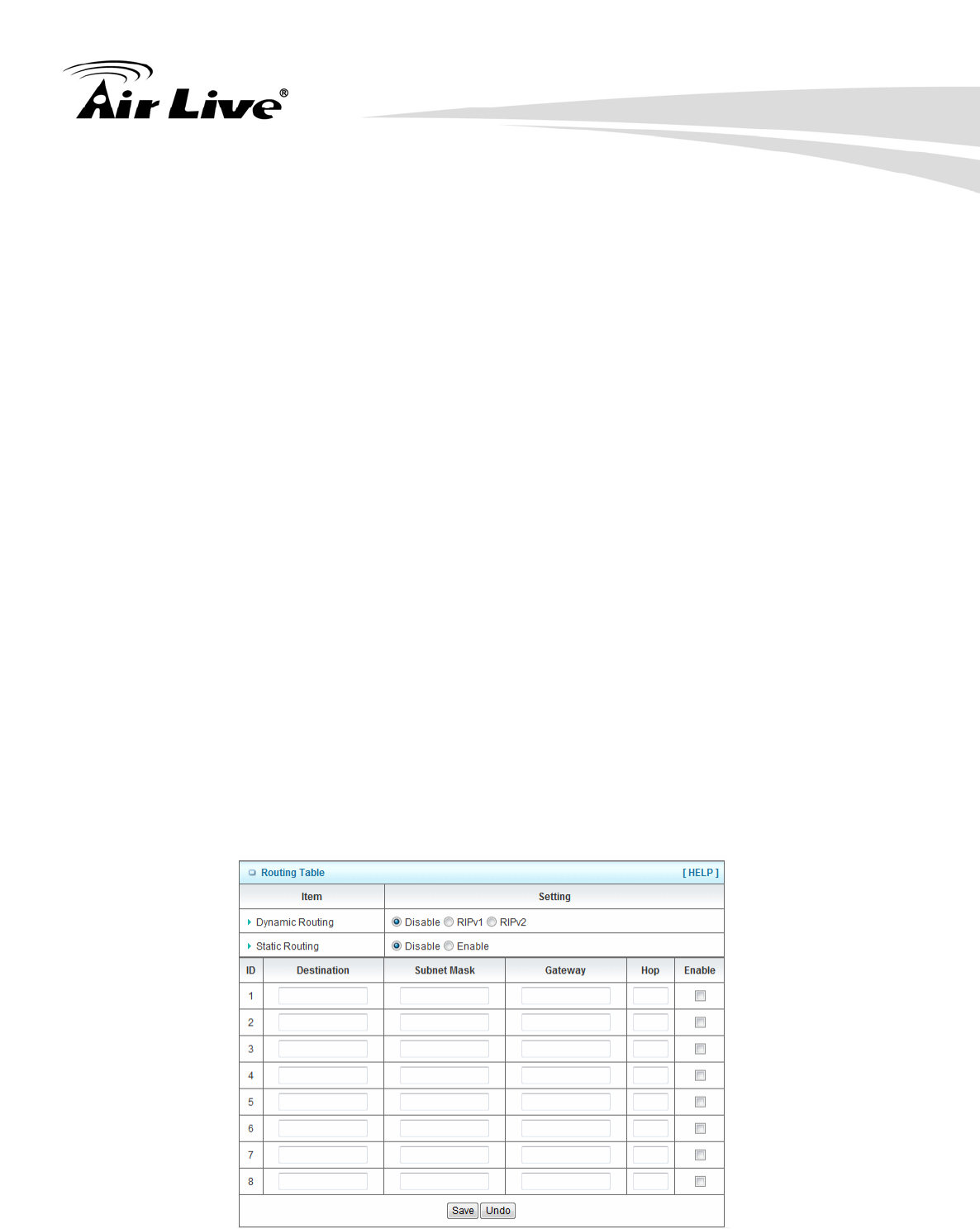
3. Configuration
AirLive N450R User’s Manual
78
1. Enable SNMP
You must check “Local”, “Remote” or both to enable SNMP function. If “Local” is
checked, this device will response request from LAN. If “Remote” is checked, this
device will response request from WAN.
2. Get Community
The community of GetRequest that this device will respond.
3. Set Community
The community of SetRequest that this device will accept.
4. IP 1, IP 2, IP 3, IP 4
Enter the IP addresses of your SNMP Management PCs. User has to configure to
where this device should send SNMP Trap message.
5. SNMP Version
Select proper SNMP Version that your SNMP Management software supports.
6. WAN Access IP Address
If you want to limit the remote SNMP access to specific computer, please enter the
PC’s IP address. The default value is 0.0.0.0, and it means that any internet
connected computer can get some information of the device with SNMP protocol.
Click on “Save” to store your settings or click “Undo” to give up the changes.
3.5.5 Routing
If you have more than one routers and subnets, you will need to enable routing table to
allow packets to find proper routing path and allow different subnets to communicate with
each other. The routing table allows you to determine which physical interface address to
use for outgoing IP data grams.
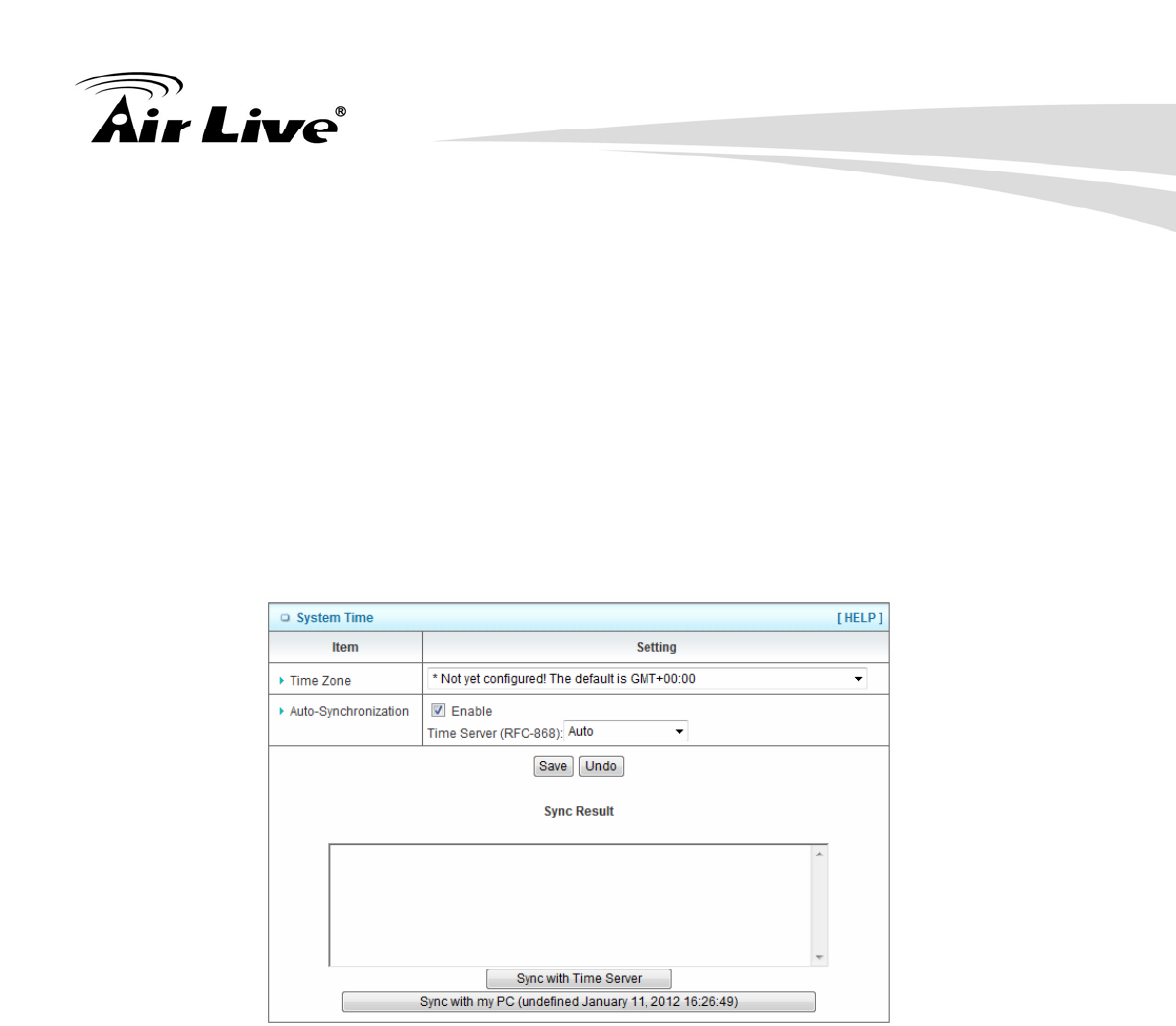
3. Configuration
AirLive N450R User’s Manual
79
1. Dynamic Routing
Routing Information Protocol (RIP) will exchange information about destinations for
computing routes throughout the network. Please select RIPv2 only if you have
different subnet in your network. Otherwise, please select RIPv1 if you need this
protocol.
2. Static Routing
For static routing, you can specify up to 8 routing rules. You can enter the destination
IP address, subnet mask, gateway, and hop for each routing rule, and then enable
or disable the rule by checking or un-checking the Enable checkbox.
Click on “Save” to store your settings or click “Undo” to give up the changes.
3.5.6 System Time
1. Time Zone
Select a time zone where this device locates.
2. Auto-Synchronization
Check the “Enable” checkbox to enable this function. Besides, you can select a NTP
time server to consult UTC time.
3. Sync with Time Server
Click on the button if you want to set Date and Time by NTP Protocol manually.
4. Sync with my PC
Click on the button if you want to set Date and Time using PC’s Date and Time
manually.
.Click on “Save” to store your settings or click “Undo” to give up the changes.
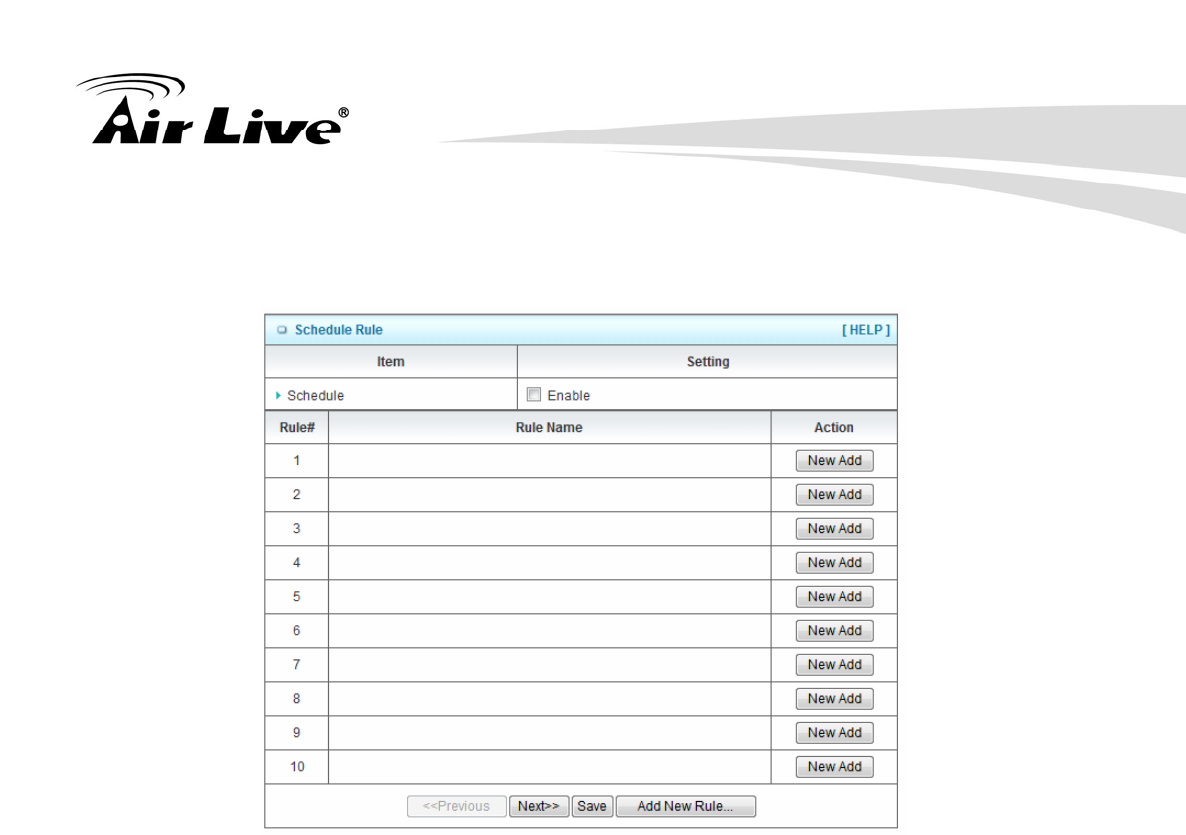
3. Configuration
AirLive N450R User’s Manual
80
3.5.7 Scheduling
You can set the schedule time to decide which service will be turned on or off.
1. Schedule
Check to enable the schedule rule settings.
2. Add New Rule
To create a schedule rule, click the “Add New Rule” button. You can edit the Name
of Rule, Policy, and set the schedule time (Week day, Start Time, and End Time).
The following example configures “ftp time” as everyday 14:10 to 16:20.
Click on “Save” to store your settings or click “Undo” to give up the changes.
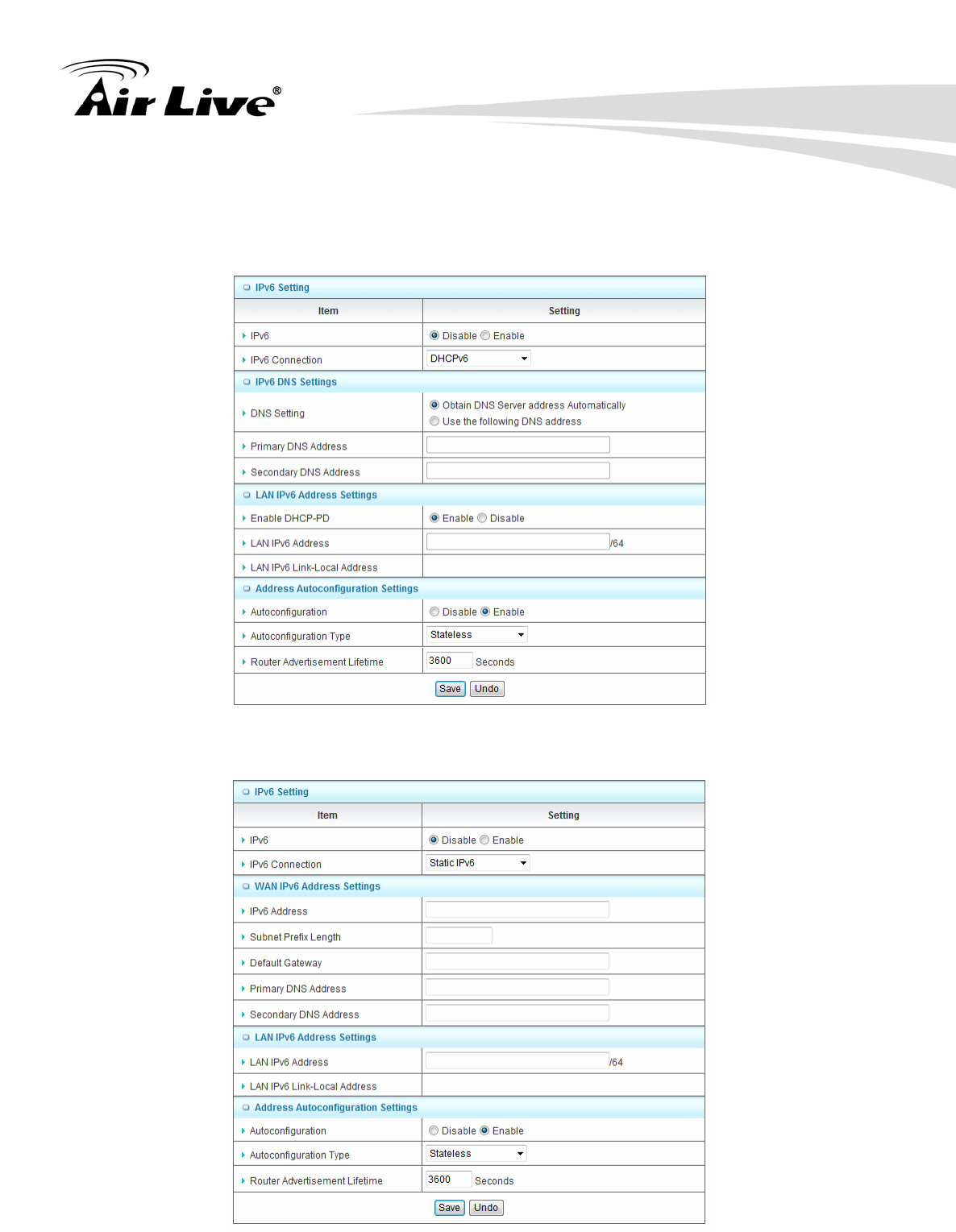
3. Configuration
AirLive N450R User’s Manual
81
3.5.8 IPv6
This device supports several IPv6 applications. You can choose Static IPv6, DHCPv6,
PPPoEv6, 6to4, and IPv6 in IPv4 tunnel according to your requirements.
(A) Static IPv6
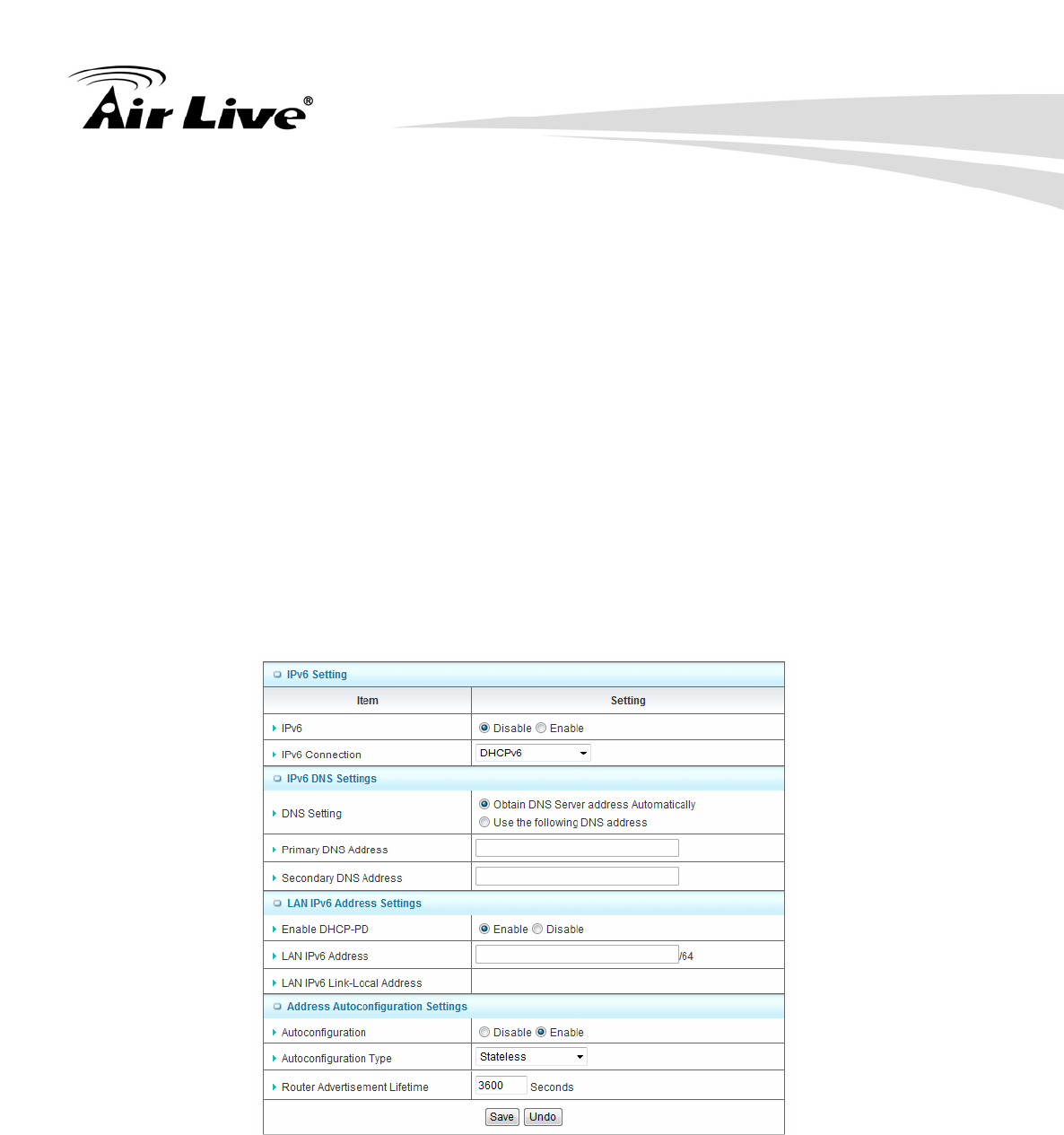
3. Configuration
AirLive N450R User’s Manual
82
1. IPv6
Disable or enable the IPv6 functions.
2. IPv6 Connection
You can choose Static IPv6 from the list.
3. WAN IPv6 address settings
You can add IPv6 address / subnet prefix length / default Gateway / Primary DNS
address and secondary DNS address.
4. LAN IPv6 address settings
You can add LAN IPv6 address, and IPv6 Link-Local address will be showed
automatically.
5. Address auto configuration setting
Disable or enable this auto configuration setting. You may set stateless or
stateful( Dynamic IPv6), and also check if need to send Router advertisement
messages periodically.
(B) DHCPv6
1. IPv6 DNS settings
You may obtain IPv6 DNS automatically or set DNS address manually for Primary
DNS address and secondary DNS address.
2. LAN IPv6 address settings
You can add LAN IPv6 address, and IPv6 Link-Local address will be showed
automatically.
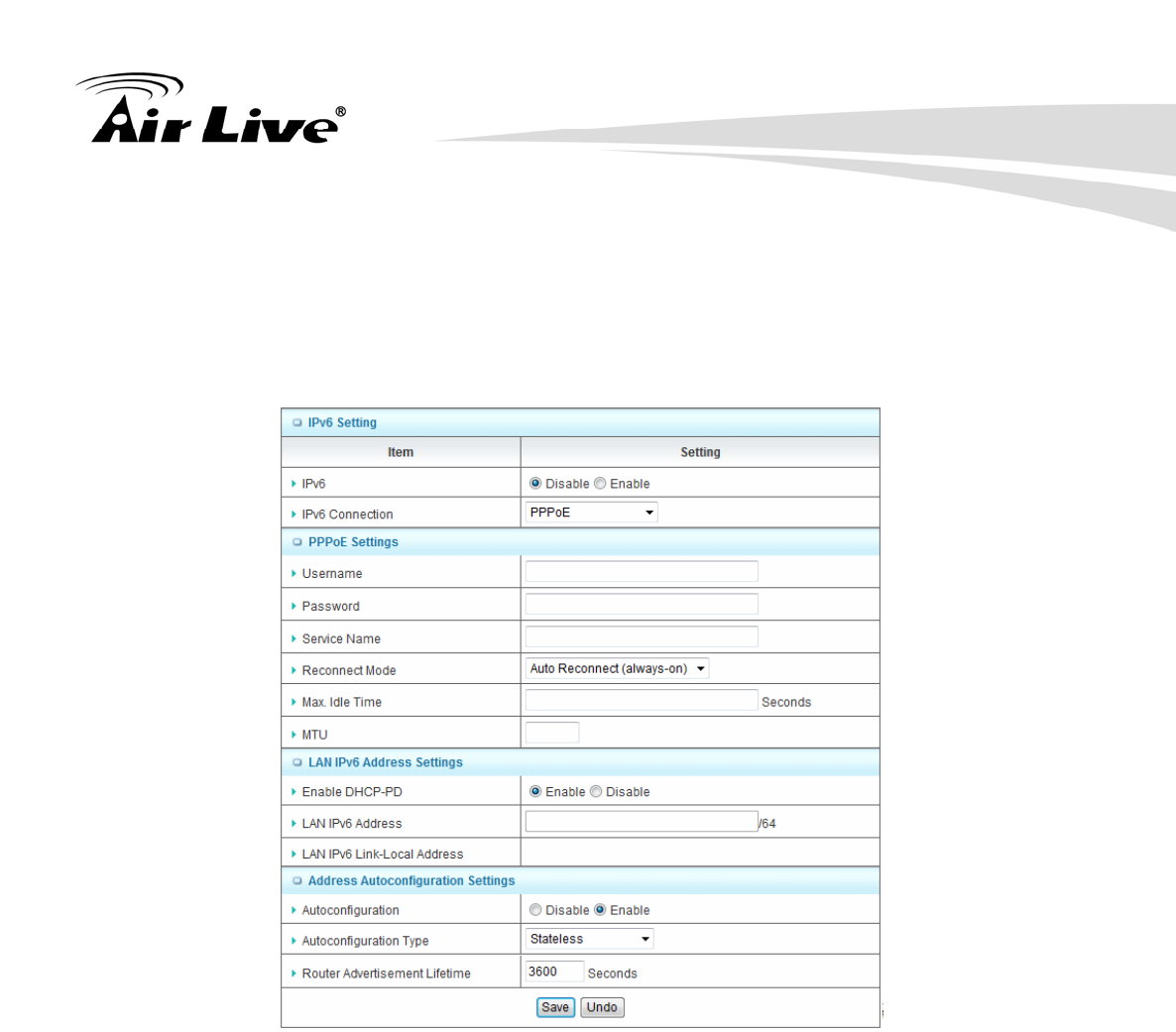
3. Configuration
AirLive N450R User’s Manual
83
3. Address auto configuration setting
Disable or enable this auto configuration setting. You may set stateless or stateful
( Dynamic IPv6), and also check if need to send Router advertisement messages
periodically.
(C) PPPoEv6
1. PPPoE settings
You need to type username and password of PPPoE connection. The service name
is only required when ISP asks you to input it. MTU is 1492 by default.
2. LAN IPv6 address settings
You can add LAN IPv6 address, and IPv6 Link-Local address will be showed
automatically.
3. Address auto configuration setting
Disable or enable this auto configuration setting. You may set stateless or stateful
( Dynamic IPv6), and also check if need to send Router advertisement messages
periodically.
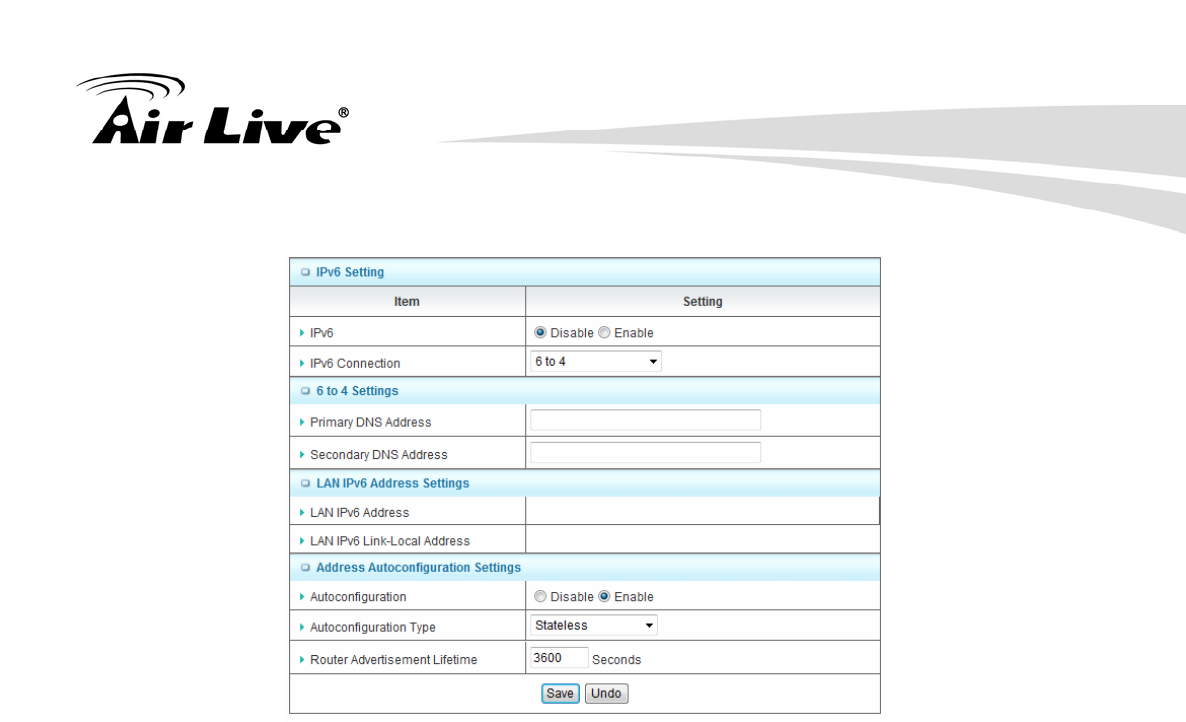
3. Configuration
AirLive N450R User’s Manual
84
(D) 6 to 4
1. IPv6 DNS settings
The 6 to 4 address will be showed automatically when WAN gets a public IPv4
address. You may set DNS address manually for Primary DNS address and
secondary DNS address.
2. LAN IPv6 address settings
You can add LAN IPv6 address, and IPv6 Link-Local address will be showed
automatically.
3. Address auto configuration setting
Disable or enable this auto configuration setting. You may set stateless or stateful
(Dynamic IPv6), and also check if need to send Router advertisement messages
periodically.
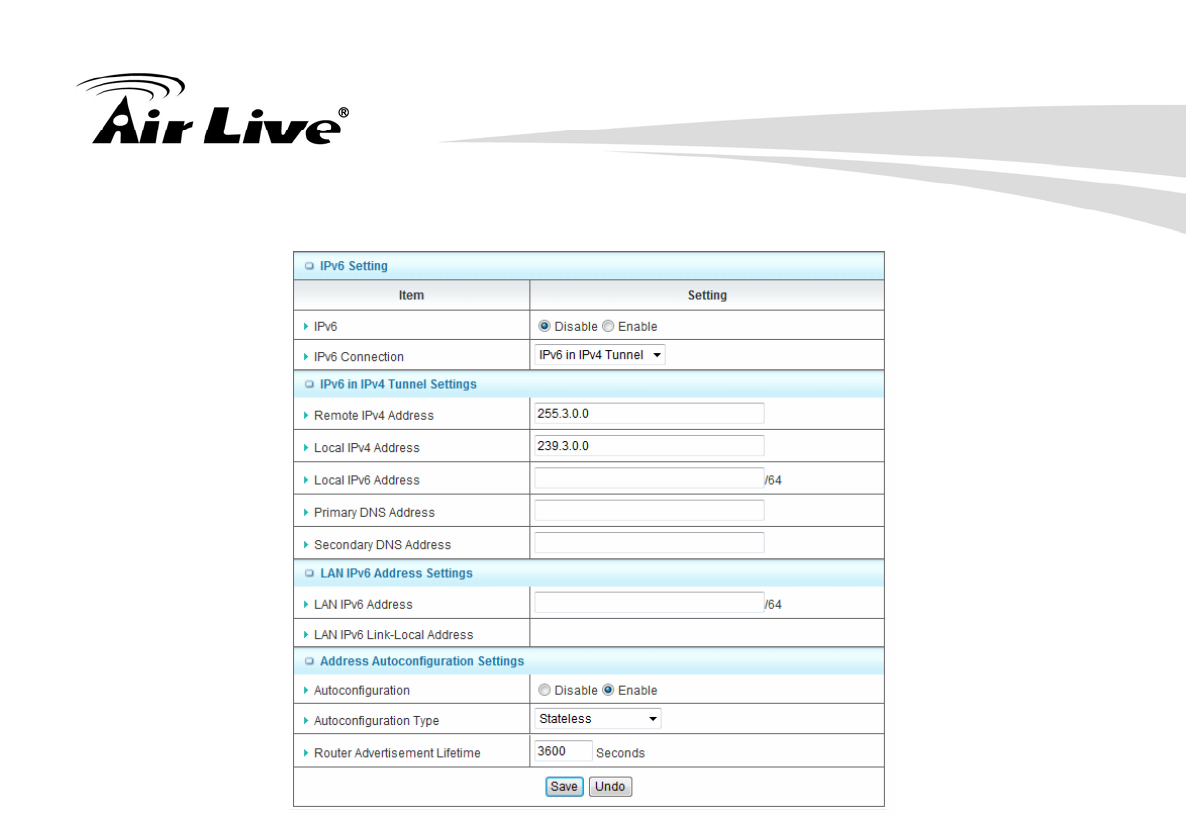
3. Configuration
AirLive N450R User’s Manual
85
(E) IPv6 in IPv4 Tunnel
1. IPv6 address in IPv4 Tunnel settings
You may add remote / local IPv4 address and local IPv6 address, and then set DNS
address manually for Primary DNS address and secondary DNS address.
2. LAN IPv6 address settings
You can add LAN IPv6 address, and IPv6 Link-Local address will be showed
automatically.
3. Address auto configuration setting
Disable or enable this auto configuration setting. You may set stateless or stateful
(Dynamic IPv6), and also check if need to send Router advertisement messages
periodically.
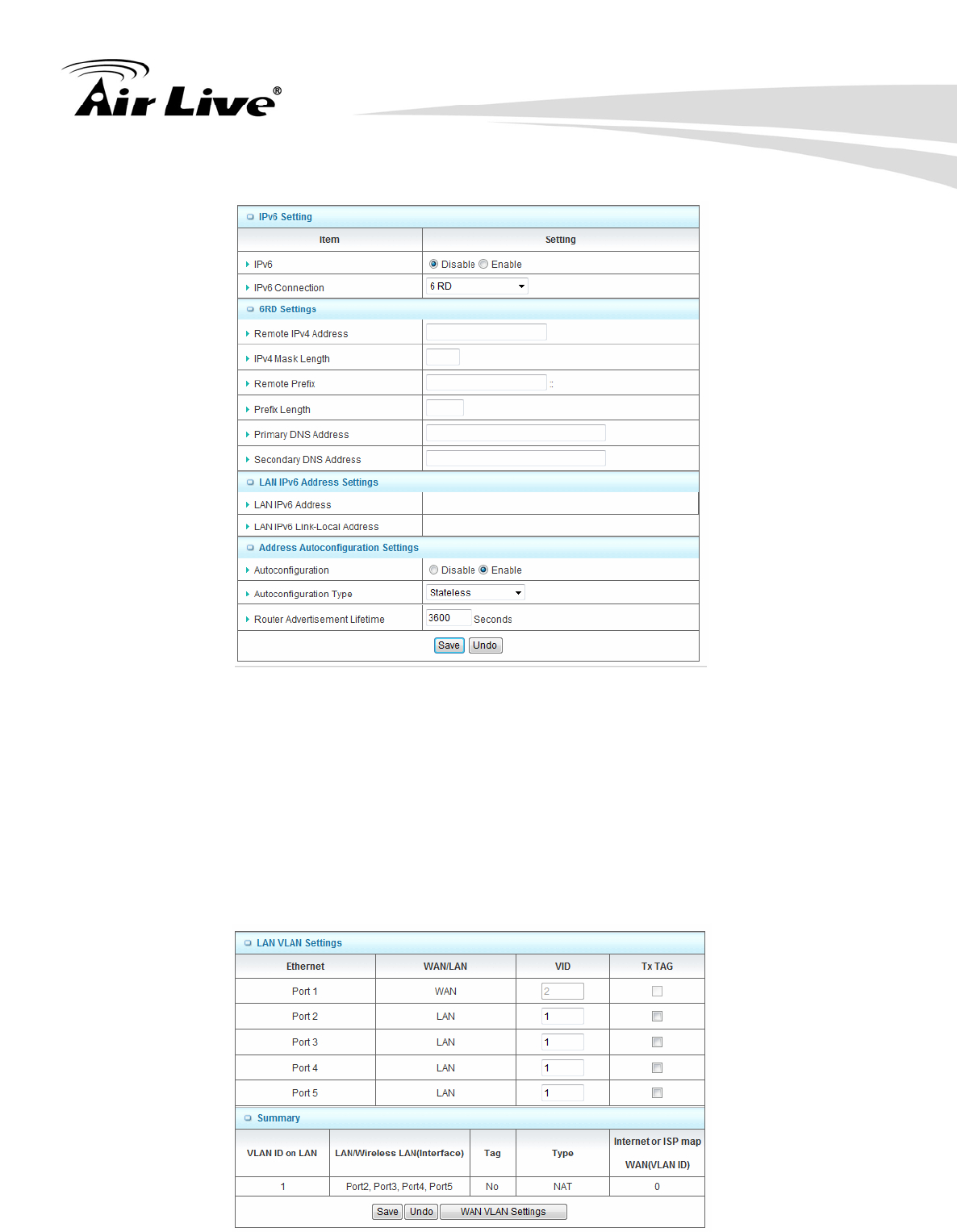
3. Configuration
AirLive N450R User’s Manual
86
(F) 6 RD
3.5.9 VLAN
The VLAN function allows you to divide local network into different “virtual LAN”. In some
cases, ISP may need router to support “VLAN tag” for certain kinds of services (e.g. IPTV)
to work properly.
There are four LAN ports with this router, so you can have up to 4 VLAN if required. Those
four LAN ports belong to one VLAN by default. If you want to divide them into different
VLAN, you just need to assign different “VID” for them. If ISP requests a “VLAN Tag” with
your outgoing data, please remember to check the checkbox of “Tx TAG”.
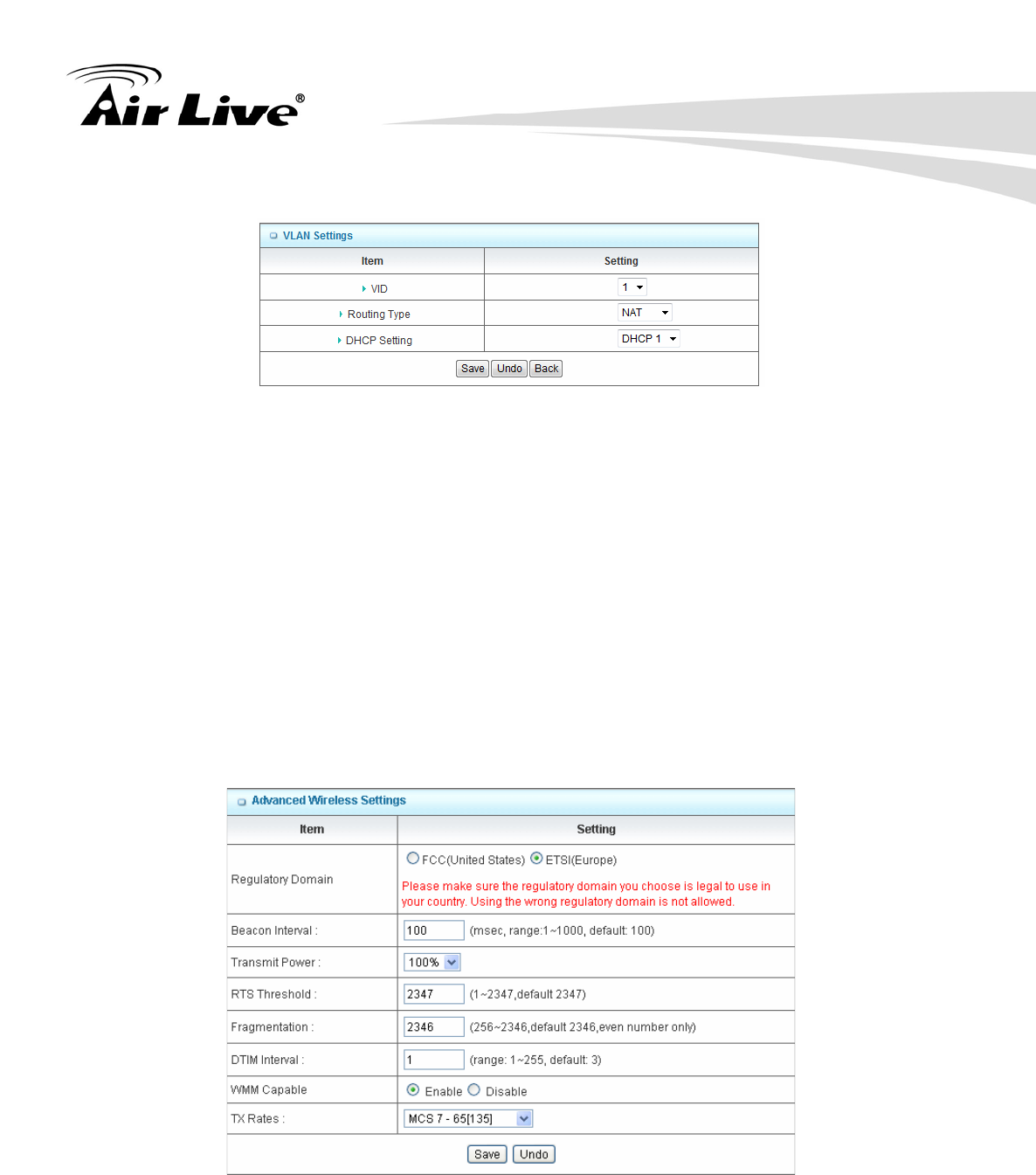
3. Configuration
AirLive N450R User’s Manual
87
For detailed configuration of VLAN, please press button “VLAN Settings” to continue.
1. VID
Select which VID you want to configure.
2. LAN Status and DHCP Select
Tthere are two options: NAT or Bridge.
If choose NAT
The NAT function is activated, and you can select one of DHCP server
configurations to apply to this VID.
If choose Bridge
The NAT function is deactivated, and WAN traffic will be transferred to local LAN
port which has same VID.
3.5.10 Advanced Wireless Settings
1. Regulatory Domian
The legal frequency and channels varies between countries. Please select one
which is allowed in your country.

3. Configuration
AirLive N450R User’s Manual
88
2. Beacon Interval
The device broadcasts beacon frames regularly to announce its existence. The
beacon Interval specifies how often beacon frames are transmitted in time unit of
milliseconds. The default value is 100, and a valid value should be between 1 and
1000.
3. Transmit Power
4. RTS Threshold
RTS/CTS frames are used to gain control of the medium for transmission. Any unicast
(data or control) frames larger than specified RTS threshold must be transmitted
following the RTS/CTS handshake exchange mechanism. The RTS threshold should
have a value between 256-2347 bytes, with a default of 2347. It is recommended that
this value does not deviate from the default too much.
5. Fragmentation
When the size of a unicast frame exceeds the fragmentation threshold, it will be
fragmented before the transmission. It should have a value of 256-2346 bytes, with a
default of 2346. If you experience a high packet error rate, you should slightly
decrease the Fragmentation Threshold.
6. DTIM interval
The AIRMAX5 buffers packets for stations that operate in the power-saving mode.
The Delivery Traffic Indication Message (DTIM) informs such power-conserving
stations that there are packets waiting to be received by them. The DTIM interval
specifies how often the beacon frame should contain DTIMs. It should have a value
between 1 to 255, with a default value of 3.
7. WMM Capable
Enable or disable WMM Capable.
8. TX Rates
You can adjust the transmit output power of the N450R. The higher the output power,
the larger coverage N450R can deliver. However, it is advised that you use just
enough output power so it will not create excessive interference for the environment.
Also, using too much power at close distance can create serious performance drop
due to signal distortion.
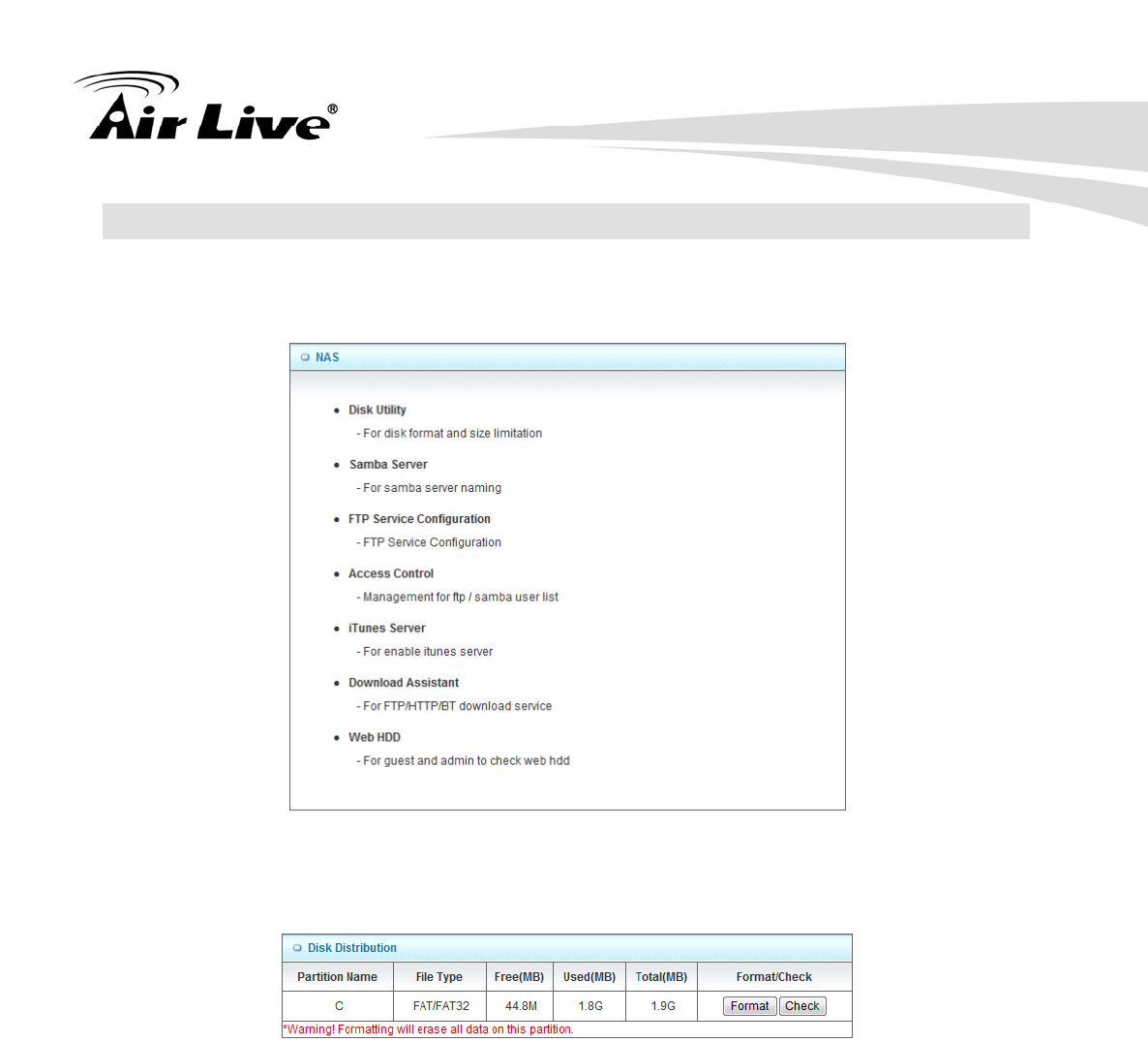
3. Configuration
AirLive N450R User’s Manual
89
3.6 NAS
With NAS function on this device, you can share your USB drive or USB HDD via network
easily. There are Disk Utility, Samba Server, FTP Service Configuration, Access
Control, iTunes Server, Download Assistant and Web HDD options.
3.6.1 Disk Utility
1. Format
This utility would format the certain partition.
Please be noted! This action will clear all your data in this partition. You will not be able to
recover it any more.
2. Check
This utility could help you check the partition, find the lost files, try to fix some problems.
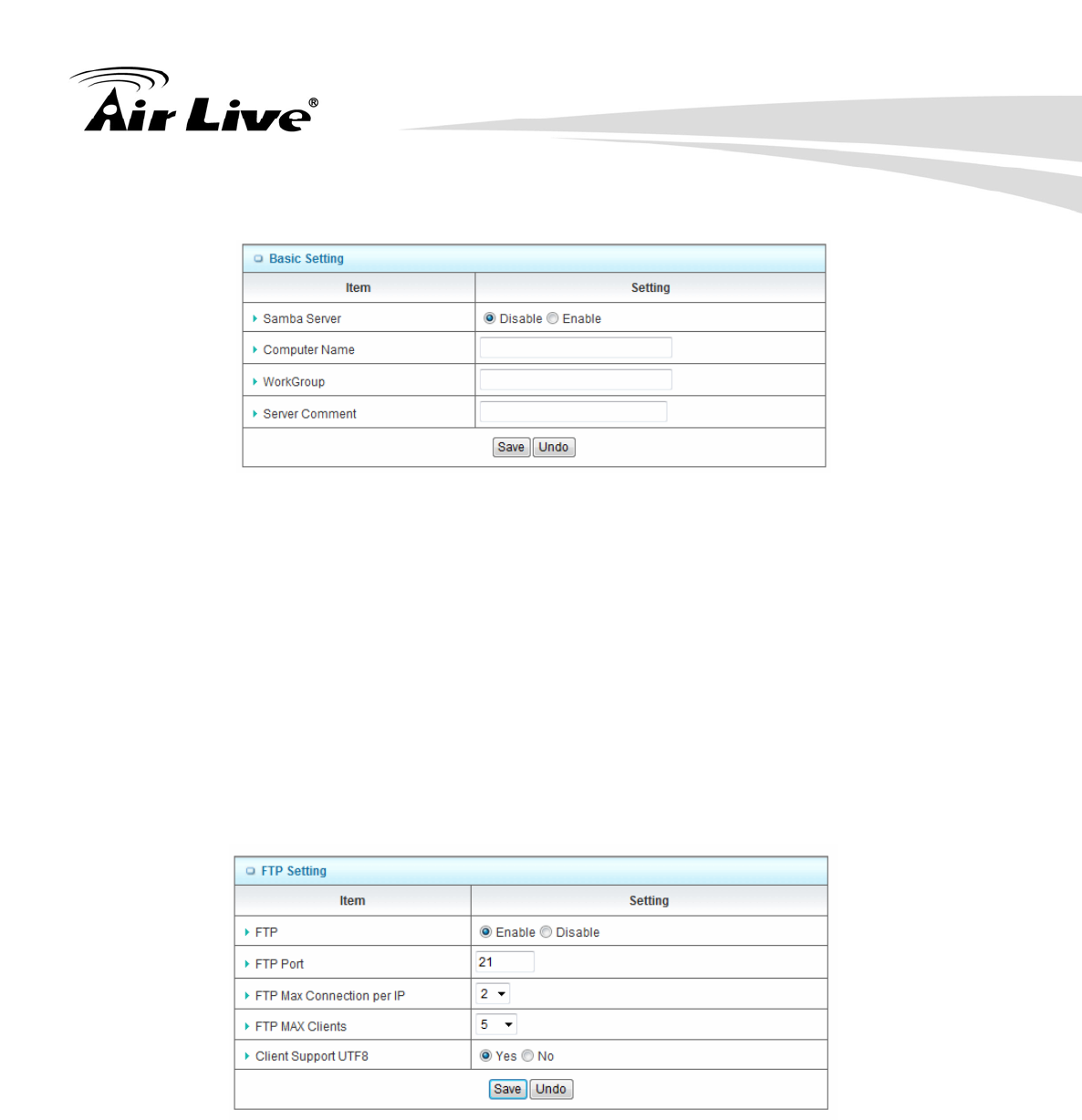
3. Configuration
AirLive N450R User’s Manual
90
3.6.2 Samba Server
These settings are for Samba Server (Windows My Network Places).
1. Samba Server
Enable or Disable Samba server functions.
2. Computer Name
The name that is showed on the windows network neighbors search result.
3. WorkGroup
This name MUST be the same as your computer, or you could not search this device
via windows.
4. Server Comment
Just a comment for recognize.
3.6.3 FTP Service Configuration
These settings are for FTP service.
1. FTP
Enable or disable functions of FTP server on this device.
2. FTP Port
The default port is 21, but sometimes you might want to hide your FTP service by
changing it. We have the ability to receive the request on non-standard FTP port, but
please be noted, some NAT router could not support non-standard FTP port, that
means some of your clients might have to use passive mode to get file.
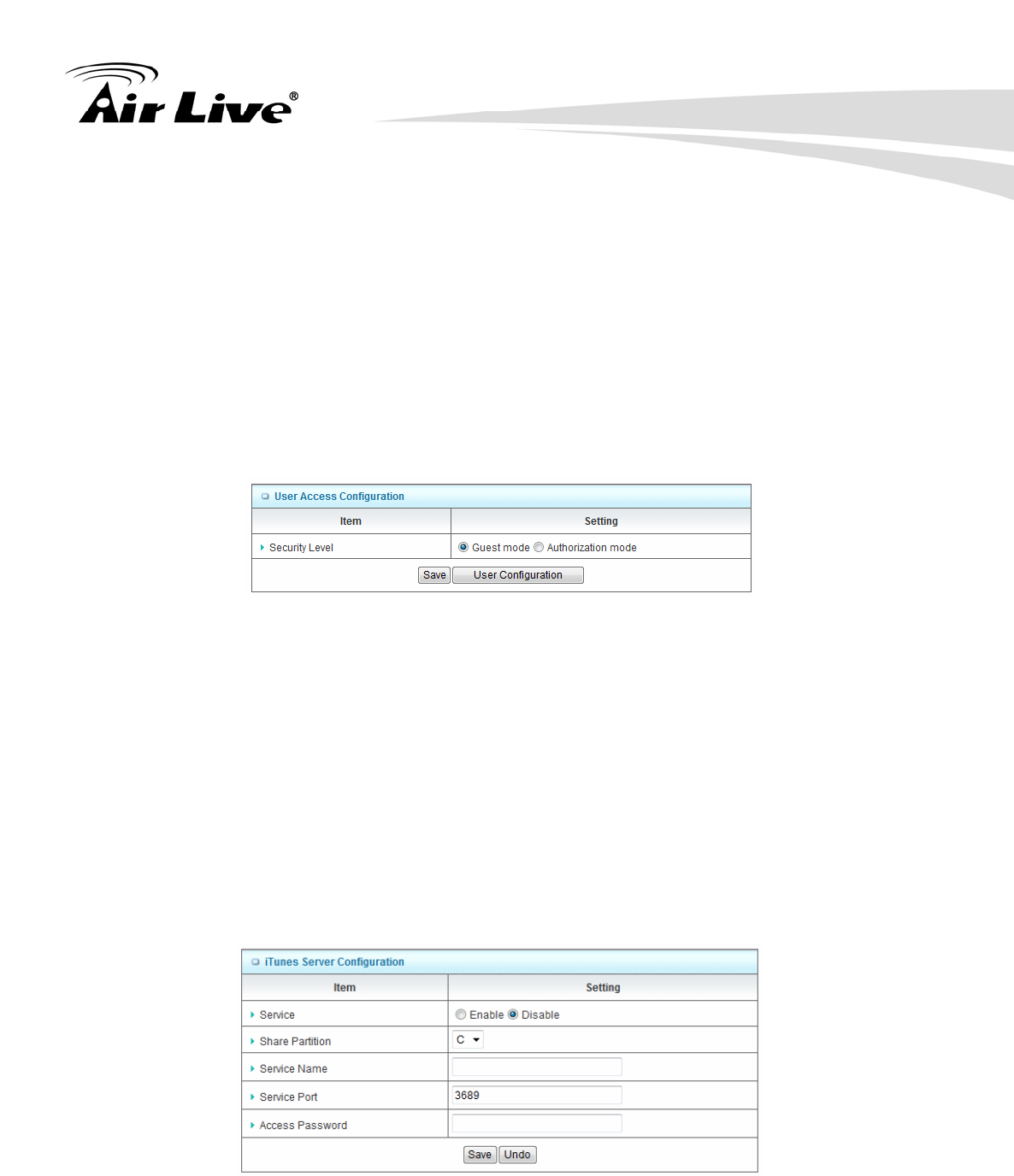
3. Configuration
AirLive N450R User’s Manual
91
3. FTP Max Connection per IP
You can limit the maximum number of FTP connection for each client.
4. FTP MAX Clients
You can indicate how many FTP clients can access the FTP service on this device at
the same time.
5. Client Support UTF8
This option is used when your FTP client could support UTF8. Usually, the default
value “No” is okay for most clients.
3.6.4 Access Control
The default setting is “Guest mode”, all clients could access as anonymous users. If you
want to control the permission, change to “Authorization mode” and save it, then go to
“User Configuration”.
In this page, you can manage the user account.
Key in the user name and password then press “Add” could let you add a new user.
If you want to delete an account, select it and click “Delete” button.
3.6.5 iTunes Server
This function could enable the built-in iTunes Server to support iTunes which is a media
player released by Apple.
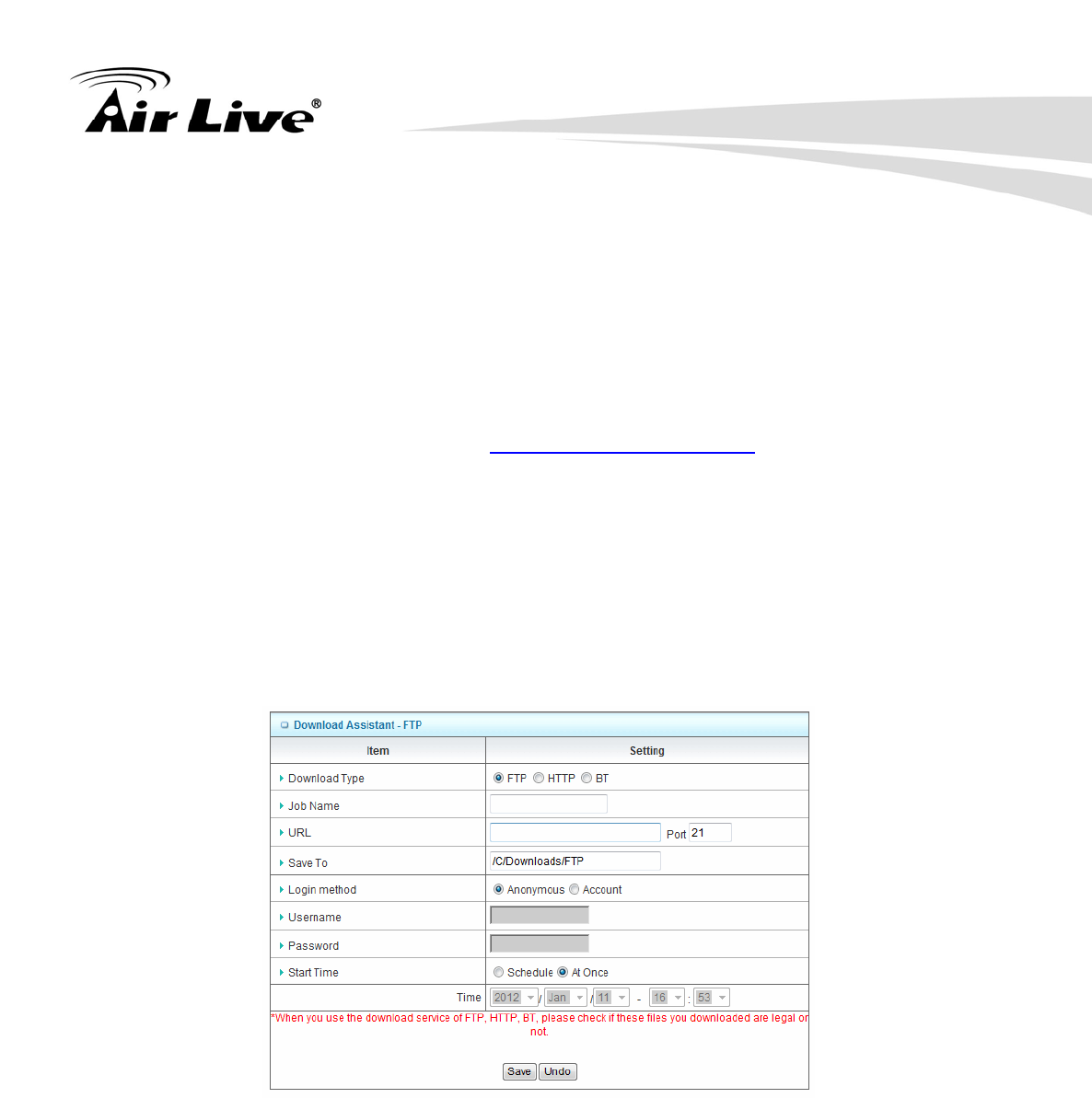
3. Configuration
AirLive N450R User’s Manual
92
1. Service
Enable or disable this function.
2. Share Partition
Select which partition on USB drive that you want to share.
3. Server Name
The name of this server, it will be shown on the iTunes.
4. Service Port
The TCP port for WEB management interface, for example, if the default value is 3689,
then your iTunes server URL will be http://This_Device_IP:3689
5. Access Password
The password for iTunes Server WEB management interface.
3.6.6 Download Assistant
With Download Assistant, you don’t need to turn the computer all day on to wait for
download to be finished. This device will help you download files from remote FTP server
or HTTP server automatically. You can also choose BT for P2P file download.
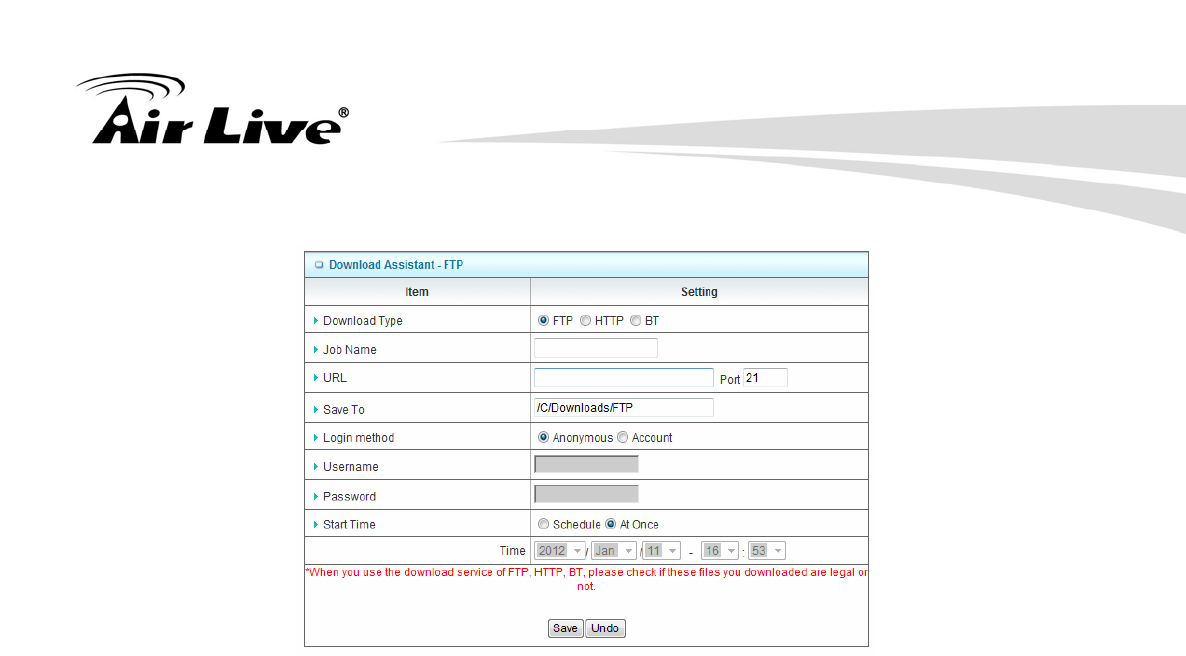
3. Configuration
AirLive N450R User’s Manual
93
(A) FTP
1. Job Name
It’s for you to remember the job easily, and the device would use this name to info you
when the job is done.
2. URL
The URL for the file you want to download. You have to use this format:
IP/path/file, you don’t have to add protocol part such like “ftp://”.
3. Save To
The destination path on USB disk that you want to save files.Default value is
/C/Download/FT
4. Login method
Anonymous, you can access this site without any authentication Account; you have to
enter the username and password to login.
5. Start Time
Schedule: this device will start FTP download on the time that you specified. The
schedule job that is saved could be check on Status page by selecting “View
Scheduled Download Status”.
At Once: the FTP download would be started immediately.
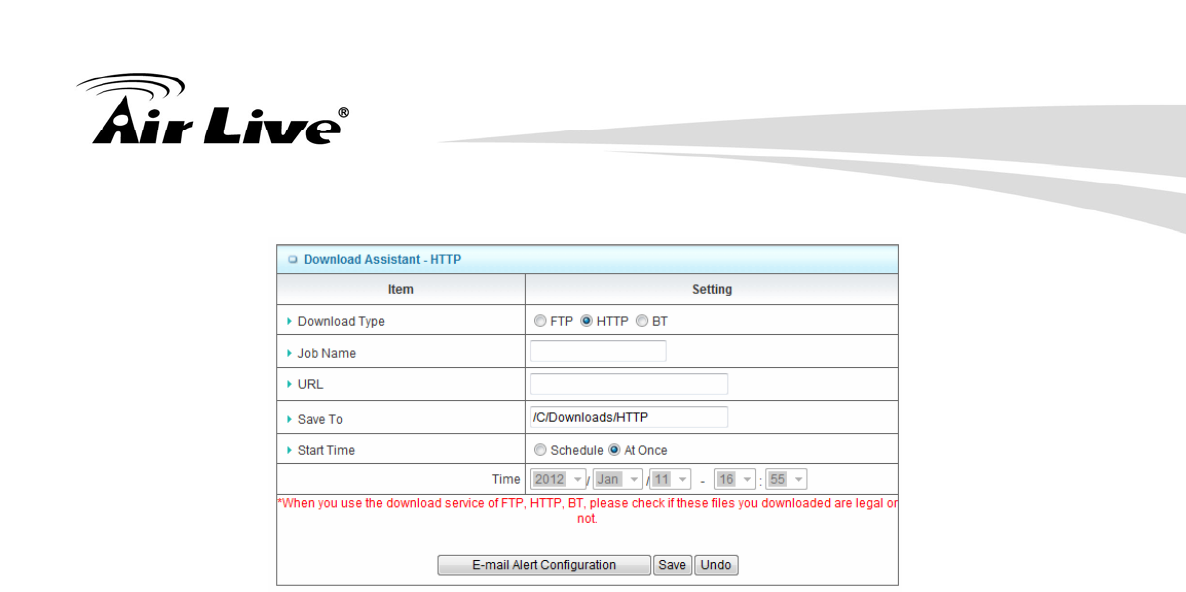
3. Configuration
AirLive N450R User’s Manual
94
(B) HTTP
1. Job Name
It’s for you to remember the job easily, and the device would use this name to info you
when the job is done.
2. URL
The URL for the file you want to download.
You have to use this format:
IP/path/file, you don’t have to add protocol part such like “http://”.
3. Save To
The destination path on USB disk that you want to save files.
Default value is /C/Download/HTTP
4. Start Time
Schedule: this device will start FTP download on the time that you specified. The
schedule job that is saved could be check on Status page by selecting “View
Scheduled Download Status”.At Once: the FTP download would be started
immediately.
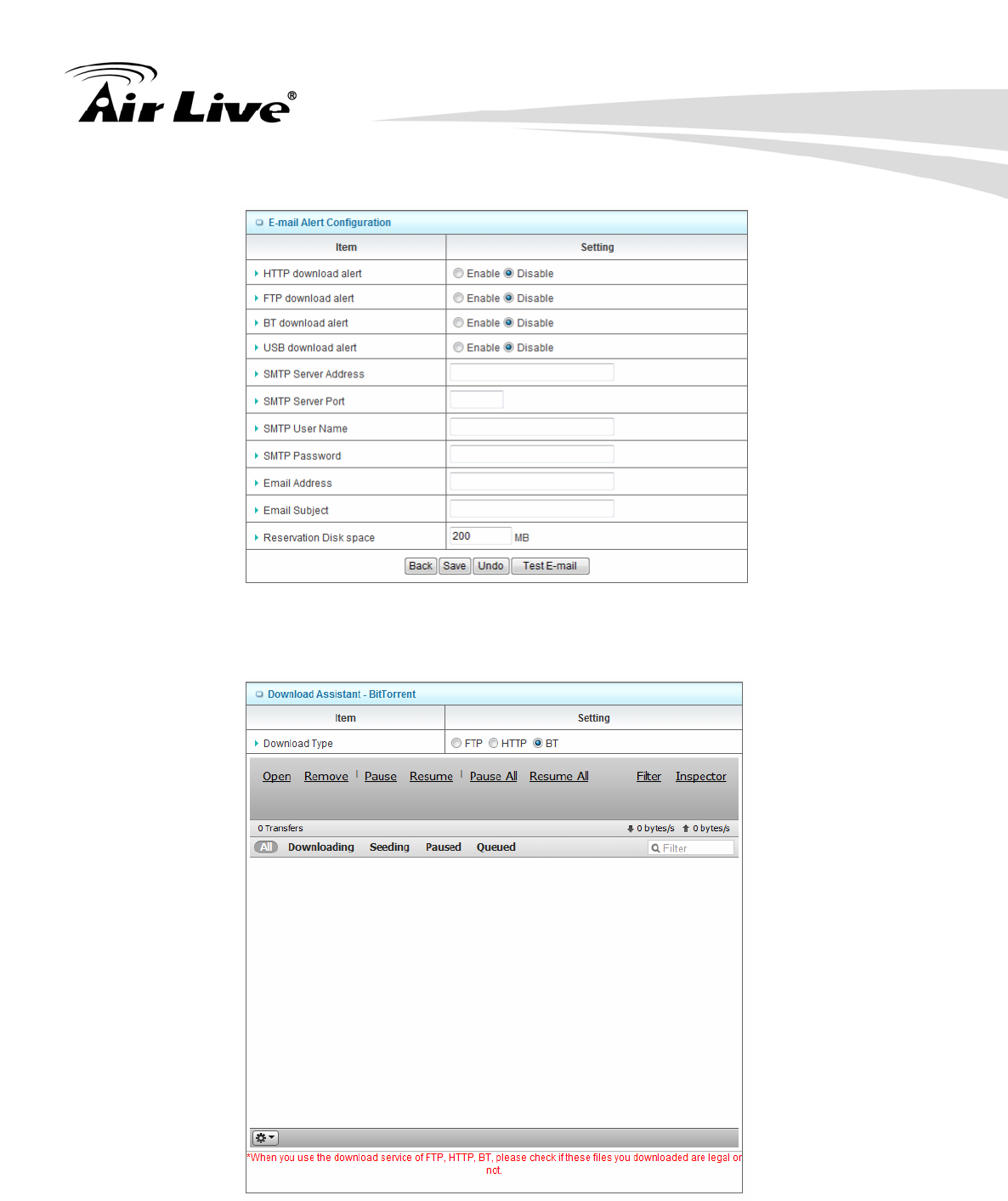
3. Configuration
AirLive N450R User’s Manual
95
By pressing “E-mail Alert Configuration”,
(C) BT (Bit Torrent)
You can download file by using BT (Bit Torrent).
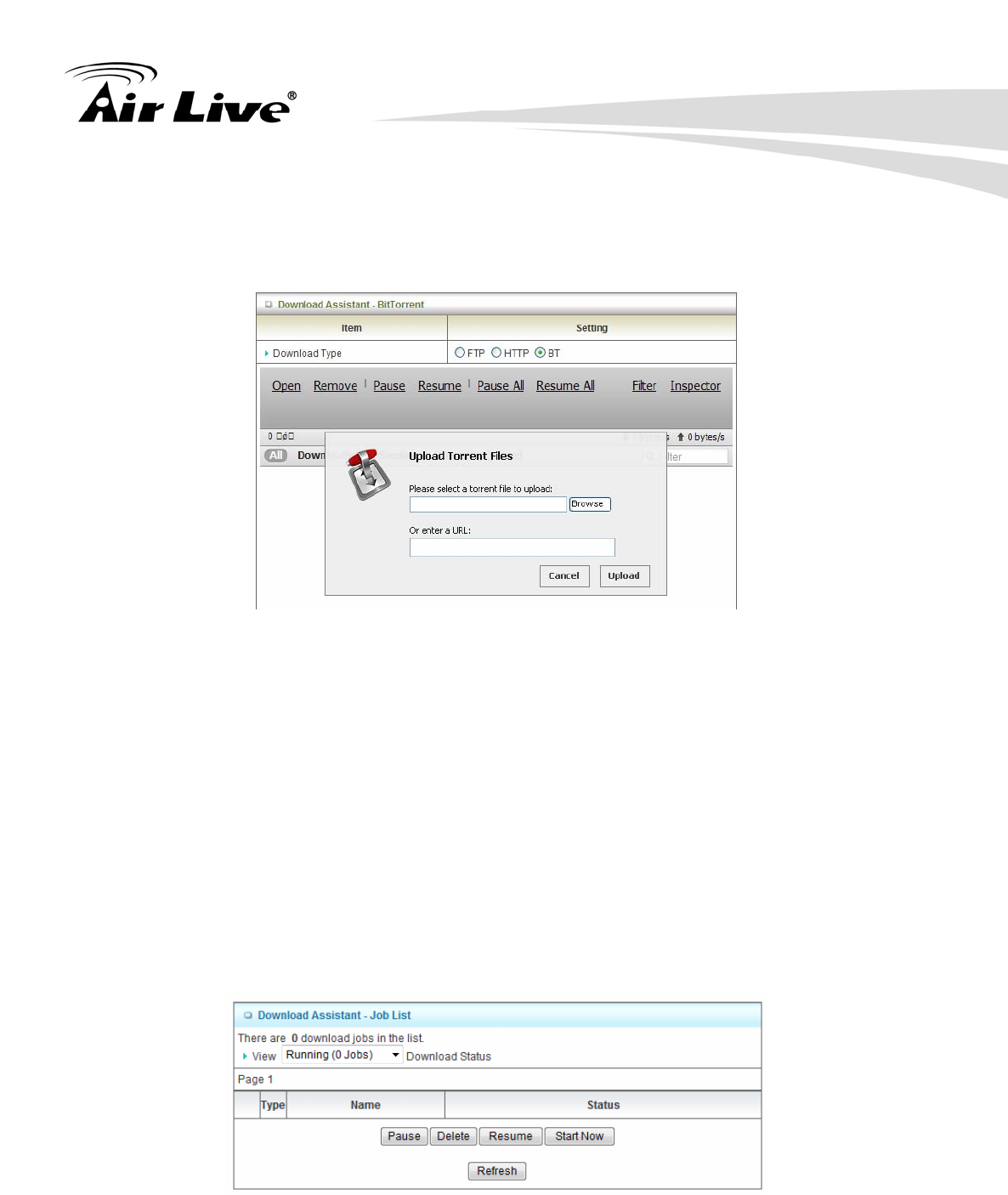
3. Configuration
AirLive N450R User’s Manual
96
Start BT download
First, you have to get a seed file, which we called “torrent”. Then click the “Open” link on
UI, it would pop up a sub menu to let you upload.
Or, if your torrent file could be downloading from network, you could just enter a URL.
BT download status
After you upload the torrent, download job would be started immediately.
The device could support 3 concurrent download jobs, other jobs would wait in job queue.
If one of the three running job is done, the next new job would be started.
At this page, you could see the download process and the bandwidth.
Stop, Resume and Remove seed
Select any job on the list, and click right button of mouse, you could see a menu with
several actions you could do. You could Stop (Pause), Resume, or Remove a job with this
sub menu.
3.6.7 Download Status
Here shows all jobs for download assistant.
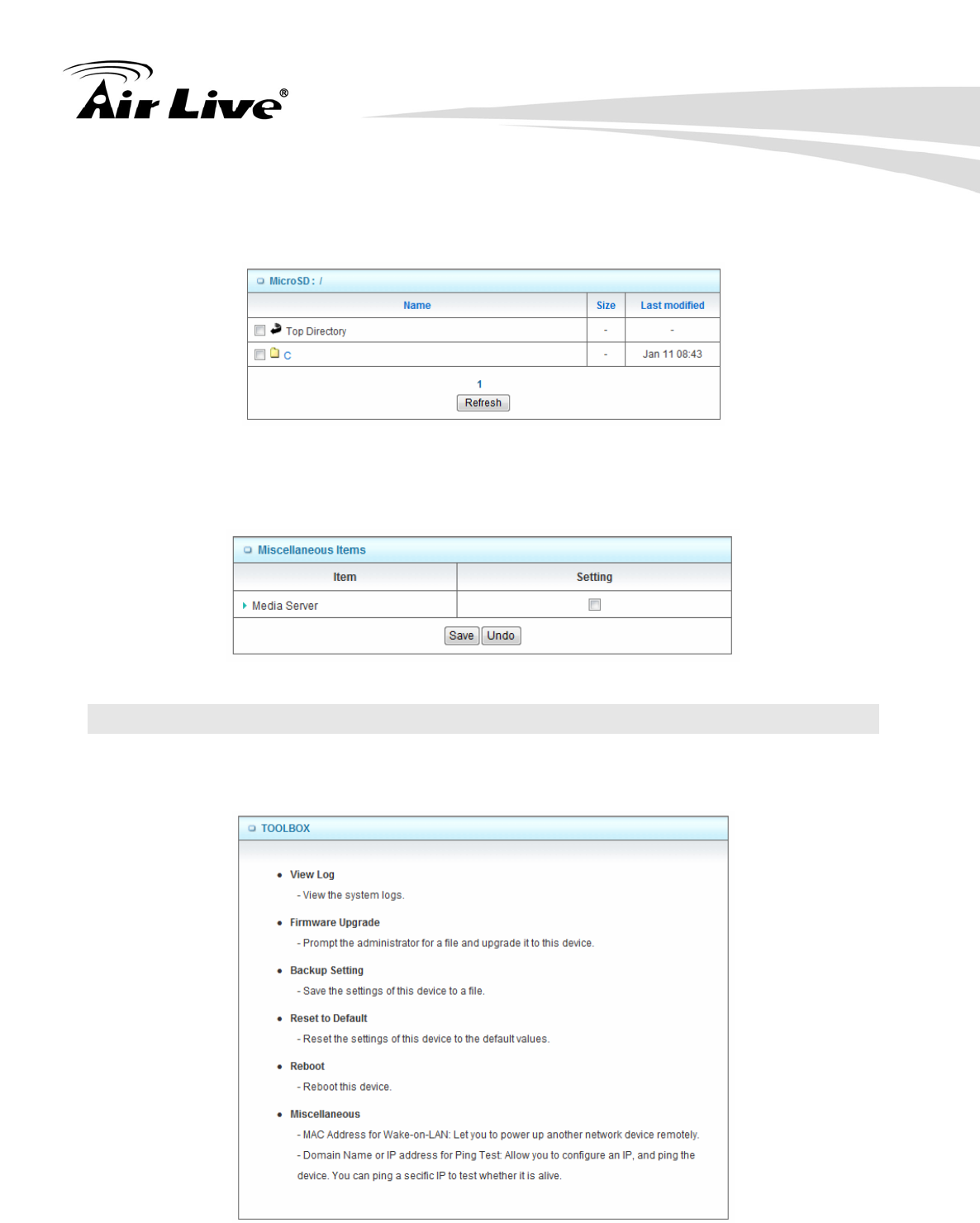
3. Configuration
AirLive N450R User’s Manual
97
3.6.8 Web HDD
This Web HDD can allow you to enter HDD by web UI, and also can allow you to let ‘guest’
to enter the ‘public’ area only.
(A) Miscellaneous
This setting is for Media Server service.
3.7 Tool Box
There are seven options: System Log, Firmware Upgrade, Backup Setting, and Reset
to Default, Reboot and Miscellaneous.
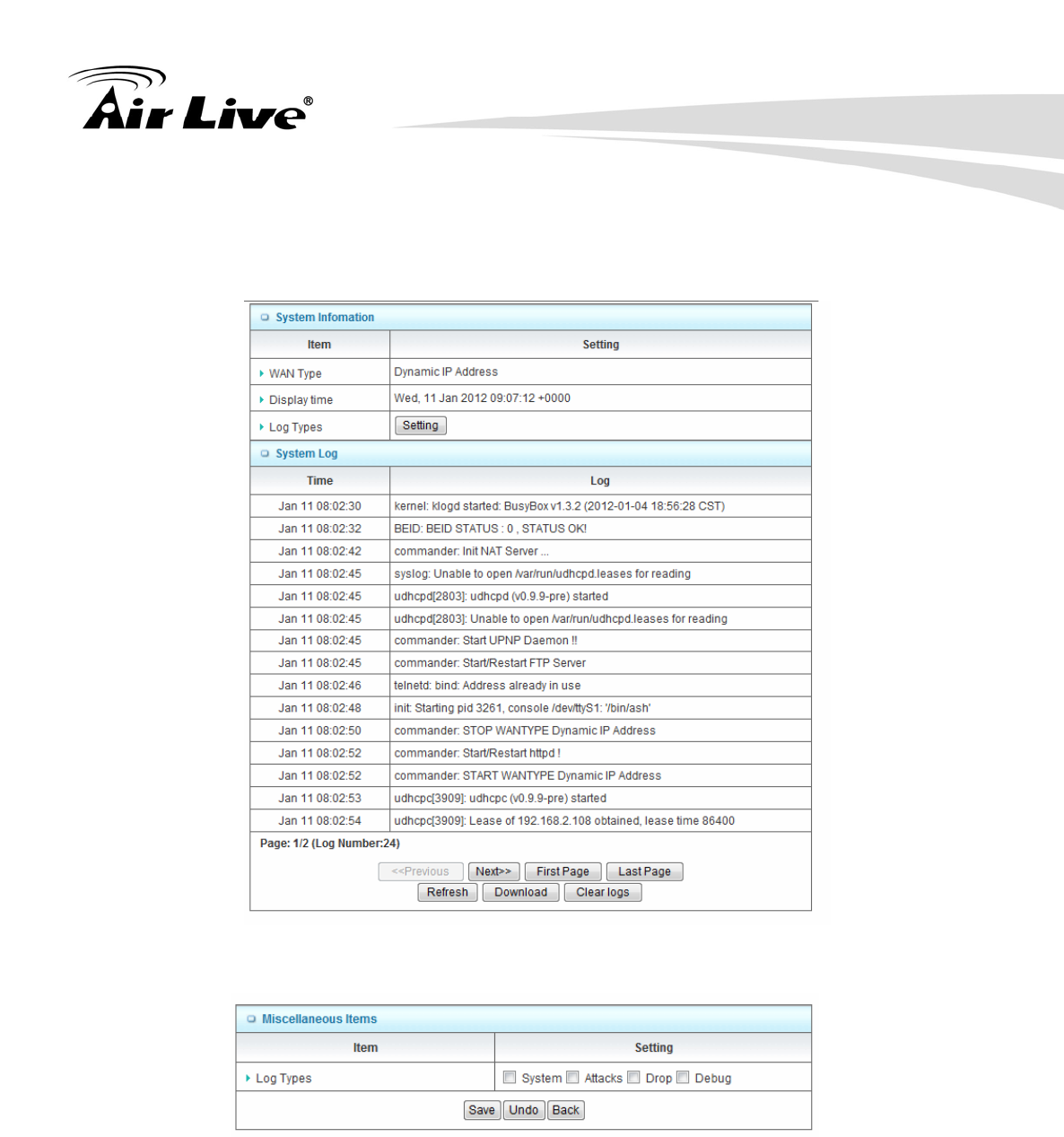
3. Configuration
AirLive N450R User’s Manual
98
3.7.1 System Info
You can view the System Information and System log, and download/clear the System
log.
Press “Setting” button.
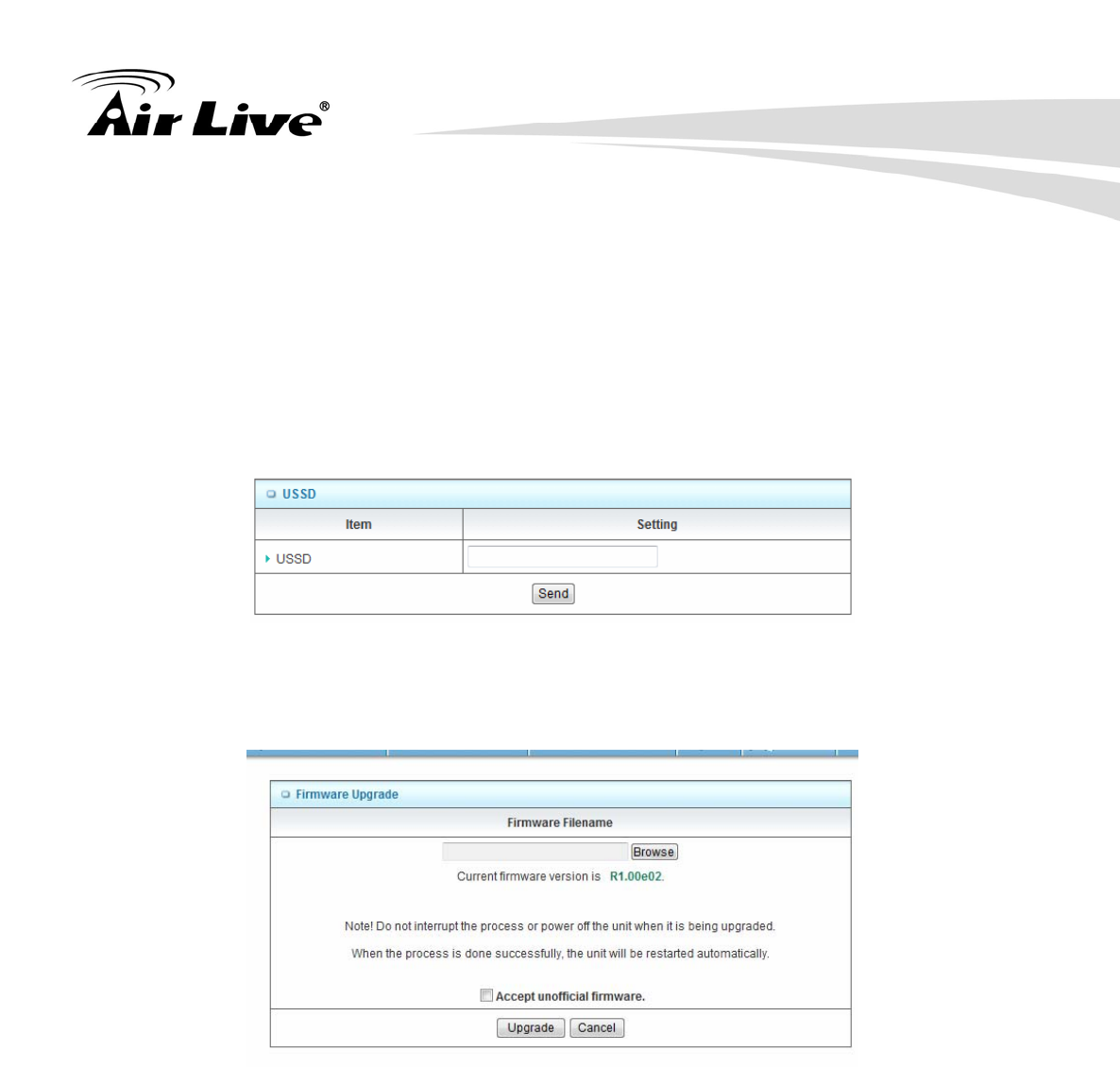
3. Configuration
AirLive N450R User’s Manual
99
3.7.2 USSD
USSD is a way to let subscribers finish some application on line, such as recharge SIM
card.
Enter the USSD command you got from ISP or carrier, and press button “Send” to send
this request to ISP or carrier. In most cases, ISP/Carrier will return a message regarding to
your USSD command. The replied message will be showed at this page as well. Please
note some replied message is sent back via SMS, and this device can’t deal with any SMS
message. If you don’t get any response after sending the command, please call your
ISP/carrier to confirm you request has been accepted.
3.7.3 Firmware Upgrade
You can upgrade firmware by clicking “Upgrade” button.
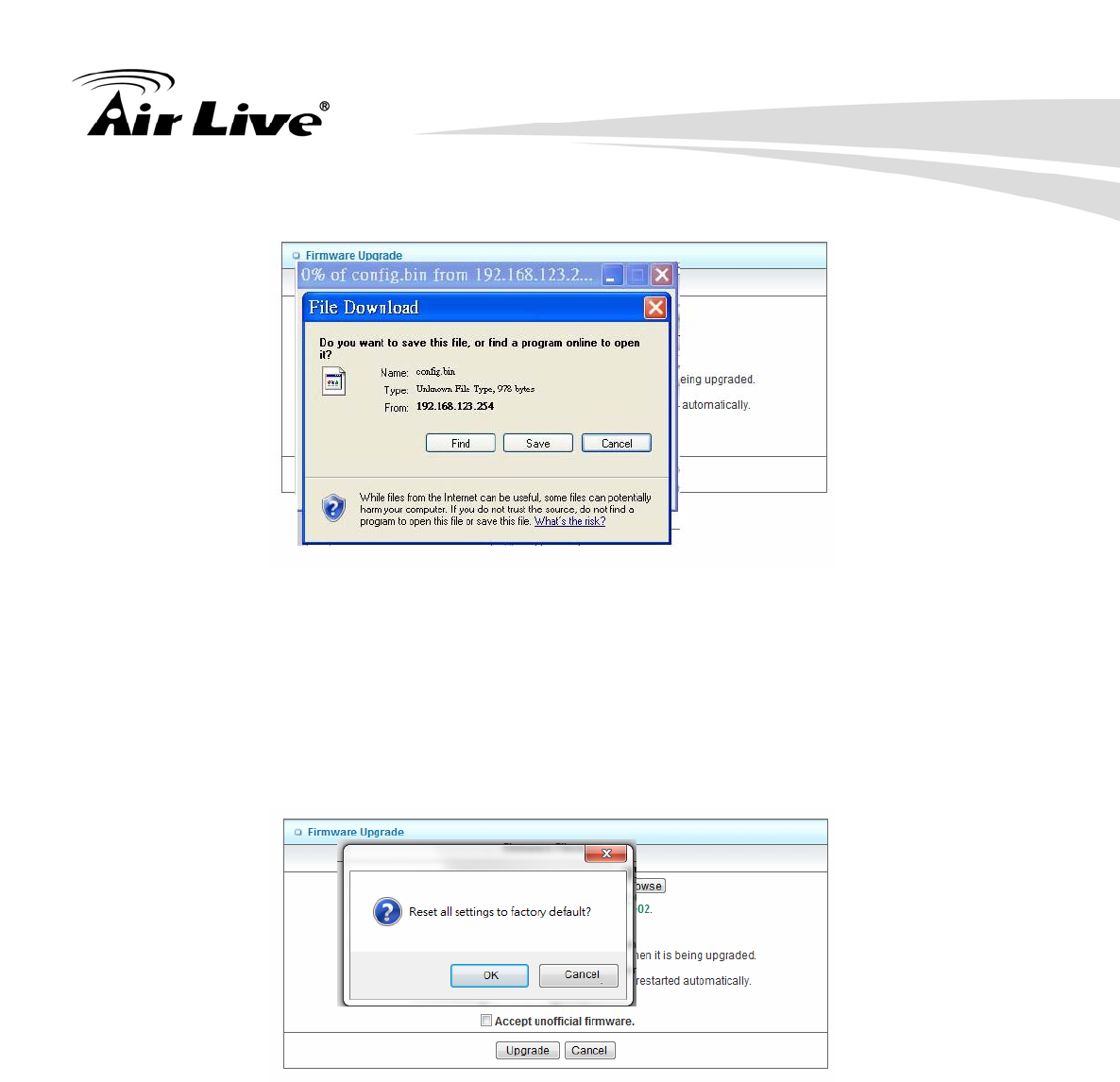
3. Configuration
AirLive N450R User’s Manual
100
3.7.4 Backup Setting
You can backup your settings by clicking the “Backup Setting” function item and save it
as a bin file. Once you want to restore these settings, please click Firmware Upgrade
button and use the bin file you saved.
3.7.5 Reset to Default
You can also reset this device to factory default settings by clicking the Reset to default
function item. Press “OK” to reset to factory default settings.
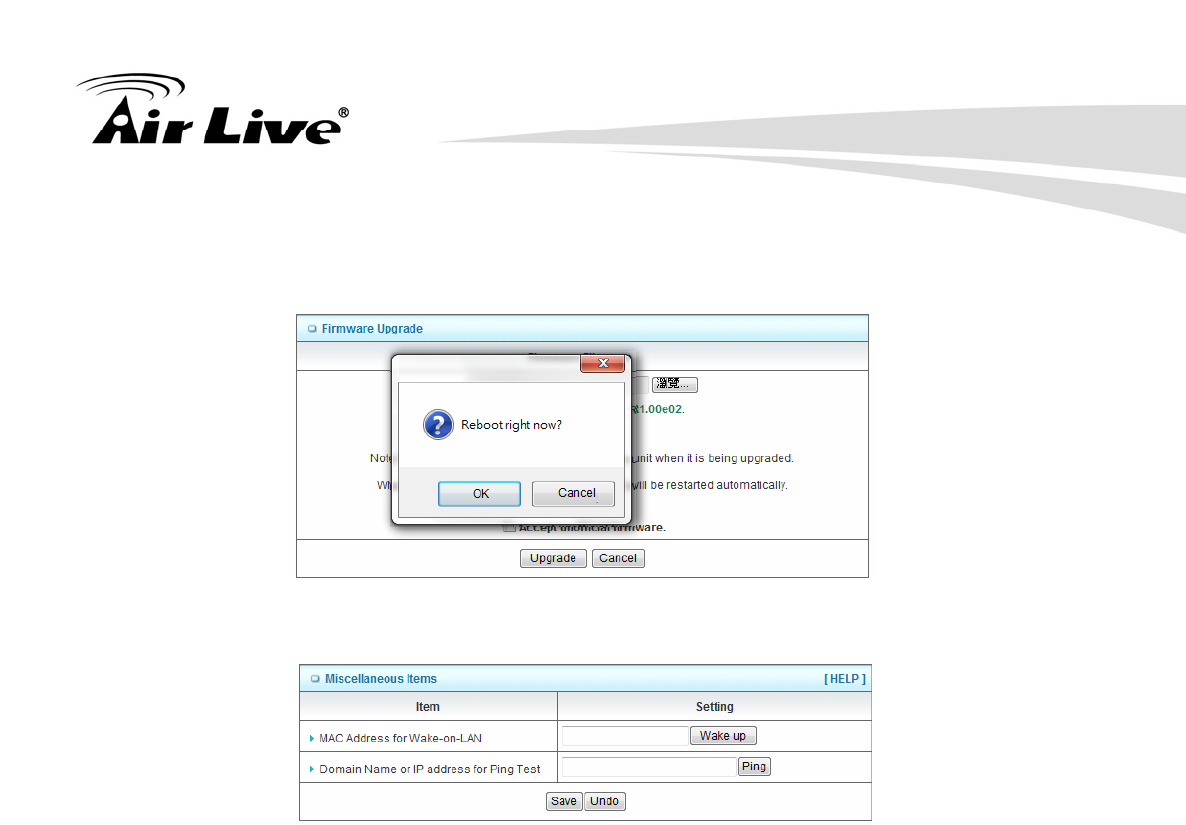
3. Configuration
AirLive N450R User’s Manual
101
3.7.6 Reboot
You can also reboot this device by clicking the Reboot function item.
3.7.7 Miscellaneous – Wake on LAN & Ping
1. MAC Address for Wake-on-LAN
It enables you to power up a networked device remotely. If you would like to trigger this
function, you have to know the MAC address of this device. For instance if the MAC
address is 00-11-22-33-44-55, enter it into the blank of MAC Address for
Wake-on-LAN. Afterwards, click "Wake up" button which makes the router to send the
wake-up frame to the target device immediately.
2. Domain Name or IP address for Ping Test
Allow you to configure an IP, and ping the device. You can ping a specific IP to test
whether it is alive.
Click on “Save” to store your settings or click “Undo” to give up the changes.
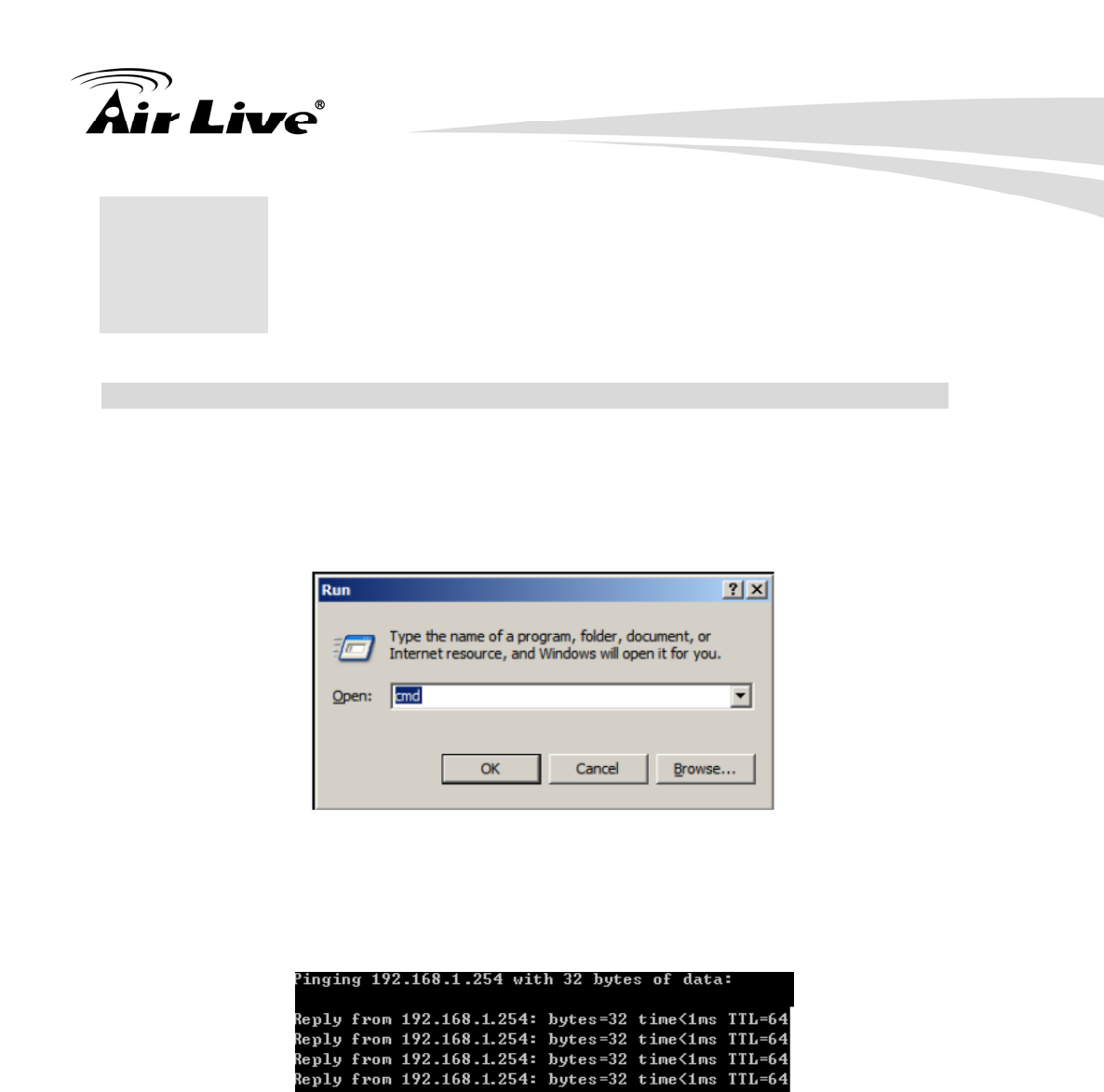
Appendix A: Troubleshooting
AirLive N450R User’s Manual
102
Q: Why can’t I configure the router even the cable is plugged and the LED is lit?
A:
Do a Ping test to make sure that the router is responding.
1. Go to Start > Run.
2. Type cmd.
3. Press OK.
4. Type ipconfig to get the IP of default gateway.
5. Type “ping 192.168.1.254”. Assure that you ping the correct IP Address assigned to
the router. It will show four replies if you ping correctly.
6. Ensure that your Ethernet Adapter is working, and that all network drivers are installed
properly. Network adapter names will vary depending on your specific adapter. The
installation steps listed below are applicable for all network adapters.
7. Go to Start > Right click on “My Computer” > Properties.
8. Select the Hardware Tab.
9. Click Device Manager.
10. Double-click on “Network Adapters”.
11. Right-click on Wireless Card bus Adapter or your specific network adapter.
12. Select Properties to ensure that all drivers are installed properly.
A Appendix A:
Troubleshooting

Appendix A: Troubleshooting
AirLive N450R User’s Manual
103
13. Look under Device Status to see if the device is working properly.
14. Click “OK”.
Q: What can I do if my Ethernet connection does not work properly?
A:
Make sure the RJ45 cable connects with the router.
1. Ensure that the setting on your Network Interface Card adapter is “Enabled”.
2. If settings are correct, ensure that you are not using a crossover Ethernet cable, not all
Network Interface Cards are MDI/MDIX compatible, and use a patch cable is
recommended.
3. If the connection still doesn’t work properly, then you can reset it to default.
Q: Something wrong with the wireless connection?
A:
1. Can’t setup a wireless connection?
Ensure that the SSID and the encryption settings are exactly the same to the Clients.
Move the WiFi Combo Router and the wireless client into the same room, and then
test the wireless connection.
Disable all security settings such as WEP, and MAC Address Control.
Turn off the WiFi Combo Router and the client, then restart it and then turn on the
client again.
Ensure that the LEDs are indicating normally. If no, make sure that the AC power
and Ethernet cables are firmly connected.
Ensure that the IP Address, subnet mask, gateway and DNS settings are correctly
entered for the network.
If you are using other wireless device, home security systems or ceiling fans, lights
in your home, your wireless connection may degrade dramatically. Keep your
product away from electrical devices that generate RF noise such as microwaves,
monitors, electric motors.
2. What can I do if my wireless client can not access the Internet?
Out of range: Put the router closer to your client.
Wrong SSID or Encryption Key: Check the SSID or Encryption setting.
Connect with wrong AP: Ensure that the client is connected with the correct Access
Point.
(A) Right-click on the Local Area Connection icon in the taskbar.
(B) Select View Available Wireless Networks in Wireless Configure.
Ensure you have selected the correct available network.
(C) Reset the WiFi Combo Router to default setting
3. Why does my wireless connection keep dropping?
Antenna Orientation.
(A) Try different antenna orientations for the WiFi Combo Router.
(B) Try to keep the antenna at least 6 inches away from the wall or other objects.
(C) Try changing the channel on the WiFi Combo Router, and your Access Point and
Wireless adapter to a different channel to avoid interference.
Keep your product away from electrical devices that generate RF noise, like microwaves,
monitors, electric motors, etc.

Appendix A: Troubleshooting
AirLive N450R User’s Manual
104
Q: What to do if I forgot my encryption key?
A:
1. Go to the Wireless Advanced setting to setup the encryption key again.
2. Reset the router to default setting
Q: How to reset to default?
A:
1. Ensure the router is powered on
2. Find the Reset button on the right side
3. Press the Reset button for 8 seconds and then release.
4. After the router reboots, it has back to the factory default settings.
Q: Problems with 3G connection?
A:
1. What can I do if the 3G connection is failed by Auto detection?
Maybe the device can’t recognize your ISP automatically. Please select “Manual”
mode, and filling in dial-up settings manually.
2. What can I do if my country and ISP are not in the list?
Please choose “Others” item from the list, and filling in dial-up settings manually.
3. What can I do if my 3G connection is failed even the dongle is plugged?
Please check the following items:
4. Make sure you have inserted a validated SIM card in the 3G data card, and the
subscription from ISP is still available
5. If you activate PIN code check feature in SIM card, making sure the PIN code you fill in
dial-up page is correct
6. Checking with your ISP to see all dial-up settings are correct
7. Make sure 3G signal from your ISP is available in your environment
8. What can I do if my router can’t recognize my 3G data card even it is plugged?
There might be compatibility issue with some certain 3G cards. Please check the latest
compatibility list to see if your 3G card is already supported.
9. What should I insert in APN, PIN Code, Account, Password, Primary DNS, and
Secondary DNS?
The device will show this information after you choose country and Telcom. You can
also check these values with your ISP.
10. Which 3G network should I select?
It depends on what service your ISP provide. Please check your ISP to know this
information.
11. Why my 3G connection is keep dropping?
Please check 3G signal strength from your ISP in your environment is above middle
level.
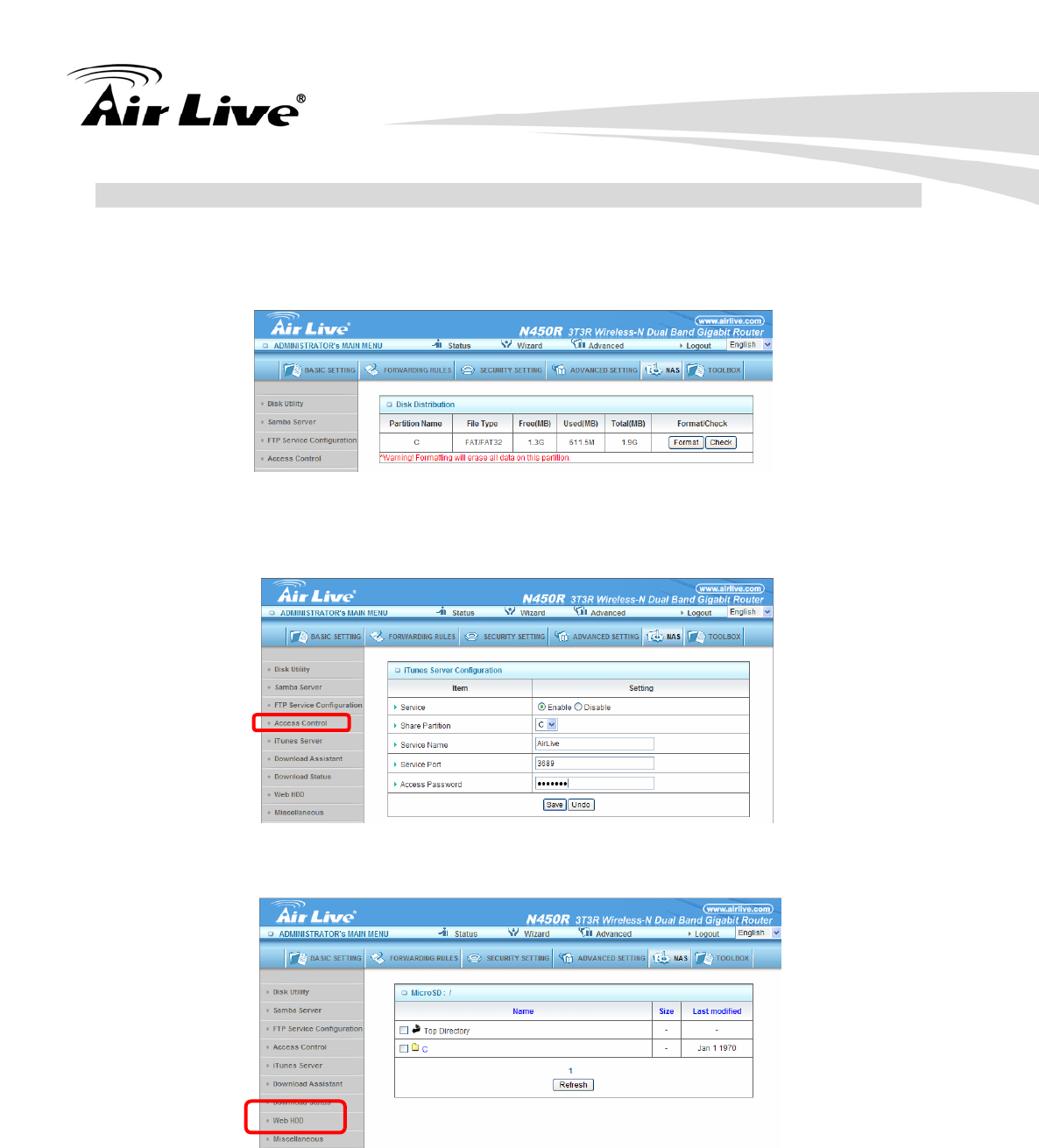
Appendix A: Troubleshooting
AirLive N450R User’s Manual
105
Q: How to configure the iTunes Server?
A:
Step1
Please check the USB HDD has installed to N450R properly.
Step2
Click iTunes Server, then enable iTunes Sever, type-in Service Name, Service Port and
Access password. Click “Save” to apply settings.
Step3: Click Web HDD, and then click “C” to check whether music file in the folder.
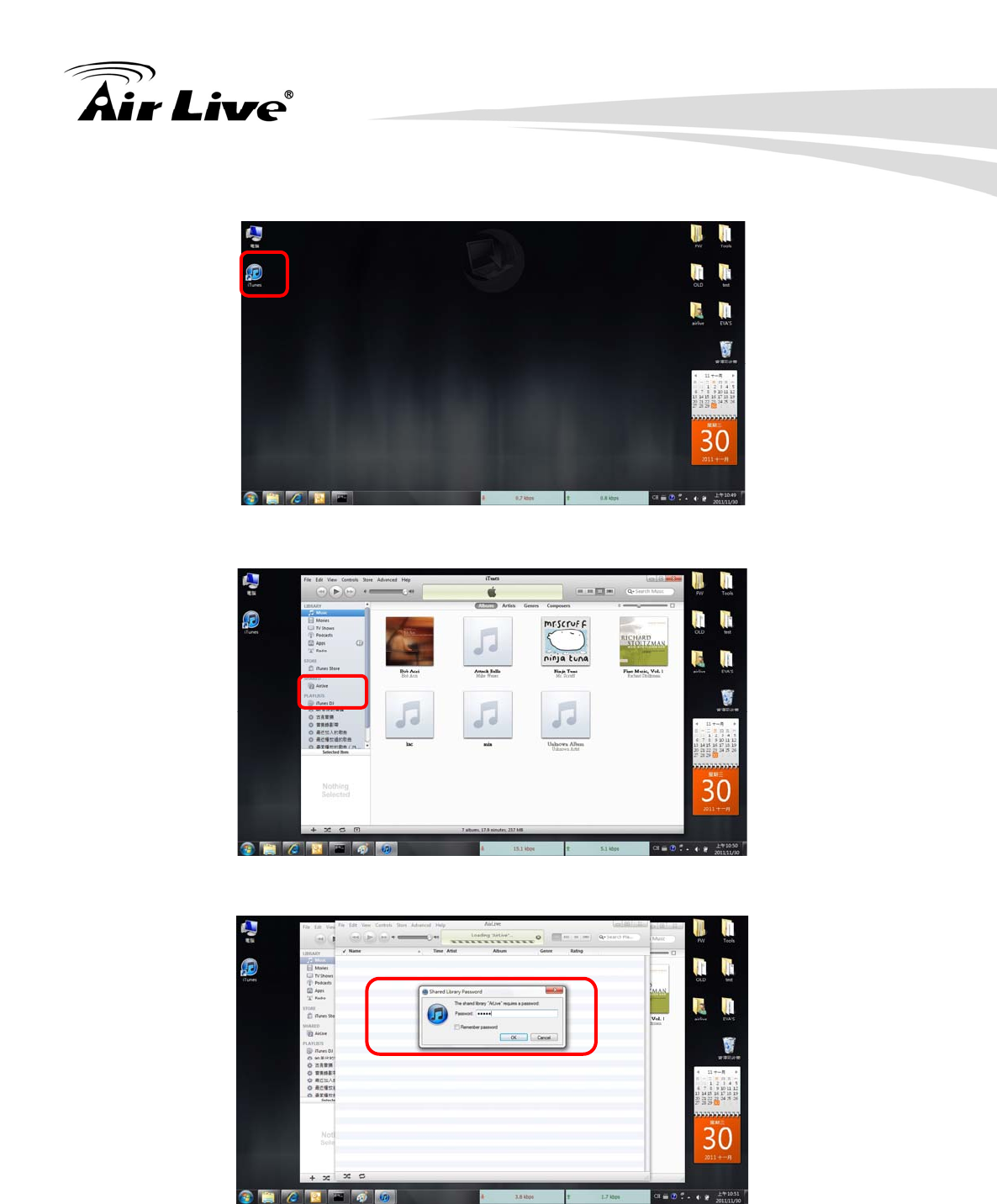
Appendix A: Troubleshooting
AirLive N450R User’s Manual
106
Step4: Start iTunes player on your PC.
Step5: There will appear a shared folder: AirLive, which you create
Step6: Please type the login password.
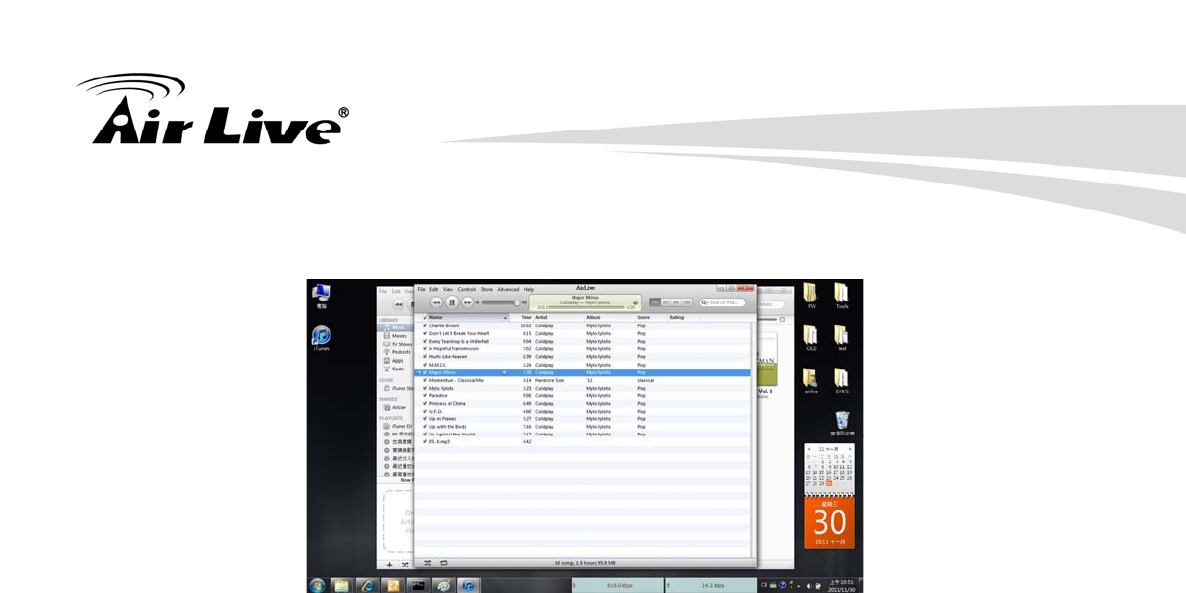
Appendix A: Troubleshooting
AirLive N450R User’s Manual
107
Step7: The music files will appear, click on the song to start to play.